
Best places to see Elephants in Thailand
- Post author By Ethan Smith
- Post date August 11, 2022
- 2 Comments on Best places to see Elephants in Thailand
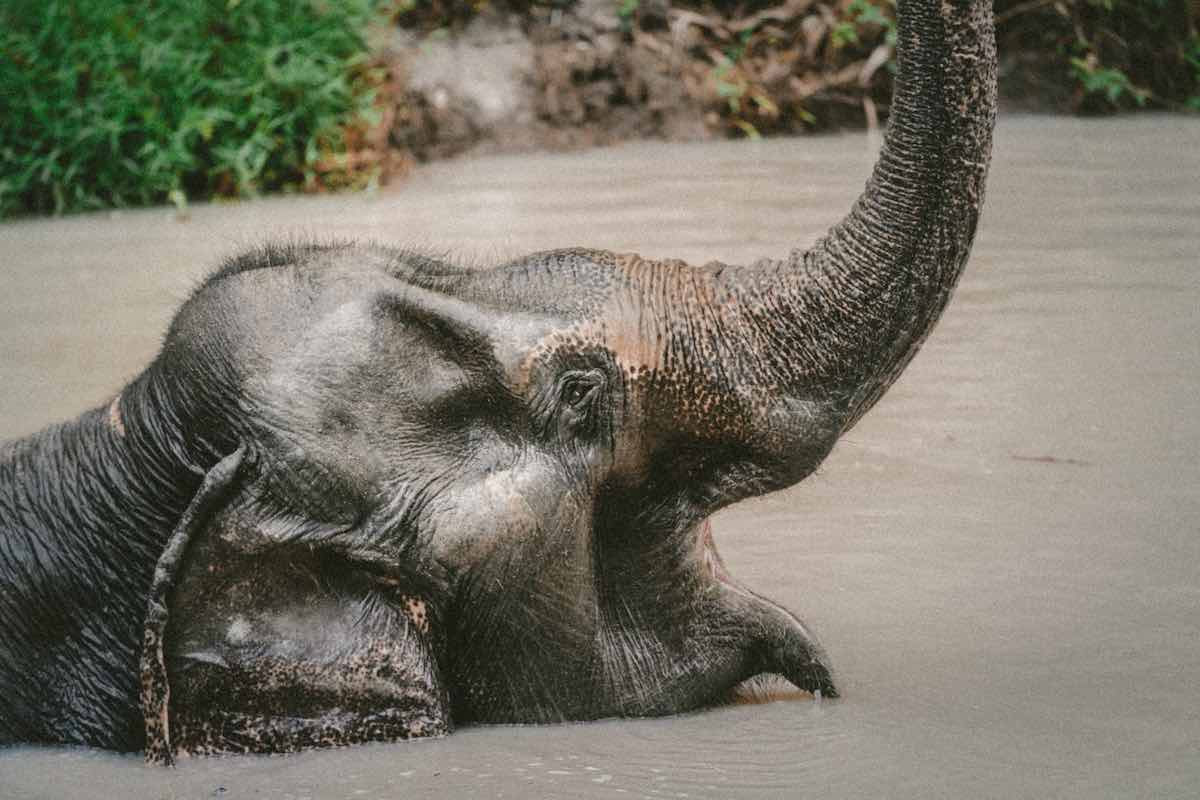
Home » Articles » Visit elephants » Best places to see Elephants in Thailand
We’re not only referring to the lovely people that call Thailand home when we say it’s home to some gorgeous citizens. The “Land of Smiles” is also known as the “Land of Spectacular Wildlife,” owing to its lush rainforests, tropical beaches, and lovely flora.
According to legend, seeing an Asian Elephant in Thailand will guarantee you good luck. On the other hand, these legends have failed to stop hunting wild elephants or exploiting elephants for profit.
The practice of logging was banned in the 1980s. However, most captive elephants were sold to the tourism industry, resulting in a more than 75% decline. Today, far less than 2,000 elephants live in their natural environments.
Currently, Thailand has no legislation that forbids the mistreatment or exploitation of elephants for tourism purposes.
However, the elephants rehabilitated in these ethical sanctuaries are helping to heal other elephants who have been abused, and you may do the same thing.
Check out these six best places and destinations to see elephant in Thailand!
1. The Elephant Nature Park, Chiang Mai
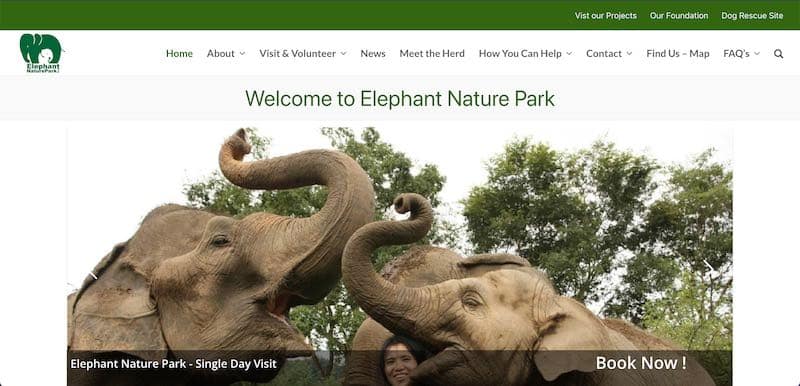
Even though the Thai term “Chang” actually translates to “elephant,” Chiang Mai is recognized as one of Thailand’s finest locations to see elephants. Because of its track record for honesty and long-term viability, locals trust Elephant Nature Park.
Quick facts:
In addition to the 75 free-roaming elephants (including rescued elephants) who call the reserve home. Each elephant has a heartbreaking rescue story to share. It also appreciates elephant tourism.
In most situations, the elephants were spared from tourism-related abuses such as habitat loss or harsh training camps.
The sanctuary has cared for dogs, cats, and other small creatures. It was formed in 1995 by naturalist Sangduen “Lek” Chailert. However, mainly it has worked on elephant conversation.
This park is located on the outskirts of the deep jungle in the northern capital. It is a magical haven for these formerly abused animals owing to the forgiving climate and lush surroundings.
Moreover, it is affiliated with one of the best Asian elephant hospitals. It’s also a great way for volunteers to help with elephant care, meal preparation, cleaning, and so on for a day or overnight.
2. Burm and Emily’s Elephant Sanctuary, Maechaem

BEES, founded by Burm and his English wife Emily, has worked to educate elephant owners in Thailand about the significance of animal welfare in the tourism sector. Since its inception, BEES has been known for putting elephants first.
BEES, an elephant refuge, care for old, wounded, and retired elephants subjected to years of logging, trekking tourism, and maltreatment.
The deep green valley and rolling hills two hours south of Chiang Mai are the ideal setting for these kind beings to live out their final years in peace. It’s no surprise that BEES holds the best track record and highest rating in our guide with five stars.
BEES has a more passive volunteer program, with responsibilities limited to animal maintenance, such as feeding them in the middle of the day and cleaning their living spaces.
Furthermore, there is a cat café on-site, and the cats there need to have cared for. Through BEES, volunteers may get involved in community conservation efforts like tree planting and repair. It is completely integrated into the local community.
3. Elephant Haven (The Sai Yok Elephant Camp in Kanchanaburi)

The Sai Yok Elephant Camp in Kanchanaburi, Thailand, is an interesting elephant project. Because of the sanctuary’s dramatic change in objective, its name was changed due to the move.
Elephant Haven was formerly a tourist attraction that chained elephants and kept them in chains and has since been transformed into a sanctuary for free-roaming elephants.
In keeping with the Elephant NaturePark’s pioneering efforts in Chiang Mai, Elephant Haven is one of a few elephant experiences that are being modernized. It has a great history and tracks records regarding the number of rescued animals, including injured elephants.
Visitors were prohibited from riding elephants on their backs at the old camp. Instead, they were advised to go for a stroll with the elephants and make/ feed the elephants fresh fruit and millet balls to consume as they moved through the forest.
4. Samui Elephant Sanctuary

The Samui Elephant Sanctuary is the first haven on the island for elephants that have been mistreated and worked to death.
In their mud pit and custom pool on the 10 acres of forest area where they live happily with 13 other elephants, guests are welcome to feed the elephants, stroll with them, and even play games with them.
Lek Chailert and Save, The Elephants, as well as volunteers, have helped open a second facility for this ethical elephant sanctuary to expand its conservation efforts around the island.
Outsiders may sponsor an elephant, get information on the elephant’s retirement, and give to their animal’s upkeep at both sanctuaries.
5. Friends of the Asian Elephant Hospital
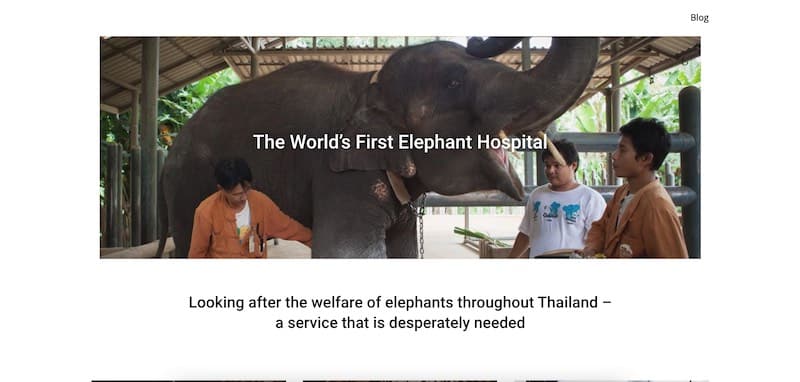
The Friends of the Asian Elephant Hospital, or FAE, was established in the early 1990s to provide better medical care for elephants in Asia.
With a mission to end the suffering of elephants, FAE has three primary objectives: rescue, rehabilitation, and release.
FAE is best known for their success in rescuing and rehabilitating elephants so that they may be returned to the wild.
The hospital is located in Lampang, Thailand, where it provides medical care for sick and injured elephants from all over Asia.
In addition to their rescue and rehabilitation efforts, FAE also works to educate the public about elephant welfare and the importance of conserving these majestic creatures.
6. Boon Lott’s Elephant Sanctuary
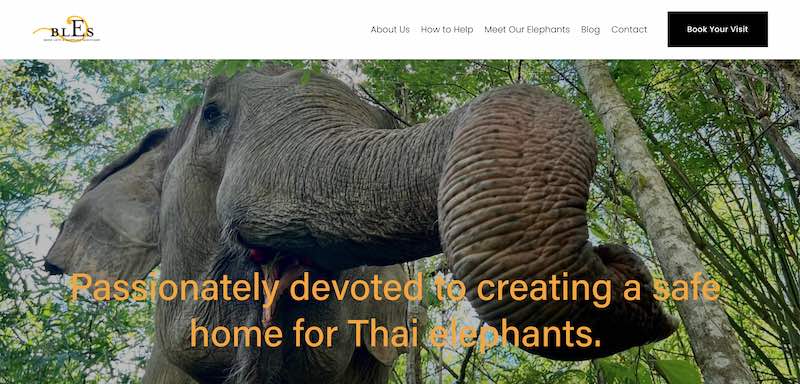
Boon Lott’s Elephant Sanctuary (BLES) is a haven for injured, abandoned, and abused elephants in Thailand.
Named after its founder, BLES was created to provide a safe environment for elephants to heal and live out their days in peace.
BLES is located on 10 acres of land in the beautiful province of Sukhothai. The sanctuary is home to 9 elephants , all of whom have been rescued from abusive situations.
In addition to providing a safe haven for elephants, BLES also works to educate the public about elephant welfare and the importance of conserving these majestic creatures.
Final Thoughts
Elephants are one of Thailand’s most popular tourist attractions, and there are many places where you can see them.
We’ve listed six sanctuaries that we recommend. Based on our experience, each sanctuary has unique benefits , so it’s important to research before deciding which is right for you.
Frequently Asked Questions about Best Places to see Elephants in Thailand
Yes, it is possible to see elephants in the wild in Thailand. However, it is important to remember that these animals are wild and should be treated cautiously and respectfully. We recommend hiring a local guide if you plan on venturing into the forest in search of elephants.
There is no definitive answer to this question, as elephants can be found all over Thailand. However, we recommend contacting a local tour company or guide to increase your chances of seeing elephants in the wild.
Prices will vary depending on the specific activity and location. However, we recommend budgeting at least $50 per person if you plan on interacting with elephants.
Yes, you can ride elephants in Thailand. Elephant rides can be found in places like the Phuket elephant sanctuary or in Samui.
- Tags Boon Lott , Burn and Emilys Elephant Sanctuary , Elephant Haven , Elephant Nature Park , elephants in Asia , Elephants in Thailand , FAE , Places to see Elephants in Asia , Samui Elephant Sanctuary
By Ethan Smith
Ethan aka "The Elephant Man" is a huge fan of elephants. He lives in the US with his wife and three kids. Together they travel to Africa every year to go on safari and see the big 5.
Ethan worked many years covering the news about the endangered animal species of Africa and is even mentioned in the now world renowned documentary "Planet Earth".
Ethan is passionate about conservation and loves educating others about these amazing animals.
2 replies on “Best places to see Elephants in Thailand”
Salut, ech wollt Äre Präis wëssen.
Hello Dennisgop,
(Dësen Text ass iwwersat)
Merci fir d’Erreechung. Leider si mir keng Reesbüro, mir liwweren einfach all Informatioun déi Dir braucht fir Elefanten ze besichen, an dësem Fall an Thailand.
Vill Gléck fir Är Rees ze reservéieren, et wäert sécherlech onvergiesslech sinn! Loosst eis wëssen wéi et geet oder wann Dir weider Hëllef braucht.
Comments are closed.

The 7 best ETHICAL elephant sanctuaries in Thailand
Disclaimer: Some posts on Tourism Teacher may contain affiliate links. If you appreciate this content, you can show your support by making a purchase through these links or by buying me a coffee . Thank you for your support!
Ethical elephant sanctuaries in Thailand, or any other country in the world, are the only kind of elephant attraction that you should visit on your travels. And even then some of the ‘sanctuaries’ are questionable in their practices. With the growth in ethical tourism and an increased awareness of animal cruelty, many people nowadays are looking to sanctuaries for their elephant experiences. But which of these are actually ethical and which are the best ethical elephant sanctuaries in Thailand to visit?
In this article I will explain to you what a ‘sanctuary’ is, before telling you which ones have the best reputations and the best reviews; making them the best ethical elephant sanctuaries in Thailand .
What is an elephant sanctuary?
How to tell if an elephant sanctuary is ‘real’, #1 elephant nature park, #2 phuket elephant sanctuary, #3 friends of the asian elephant hospital, lampang, #4 elephant hills, khao sok, #5 mahouts elephant foundation, #6 wfft thai elephant refuge, near hua hin, #7 boon lott’s elephant sanctuary (bles), sukhothai, the best ethical elephant sanctuaries in thailand: know before you go.

In an ideal world, no elephants would be living in captivity, however, in the real world this is not possible. There are many sanctuaries around the world which seek to ‘fix’ the problems that humans have created for elephants over the years. There are thousands of elephants all over the world who have spent their lives suffering by working in the logging or tourism industries.
A sanctuary is a place of refuge or safety. The vast majority of elephant sanctuaries in Thailand, and elsewhere, focus on taking care of rescued animals. They provide a safe home and shelter for elephants.
Sanctuaries do not always have the word sanctuary in their title. Three common titles that you will see are:
- Elephant park
- Elephant camp
- Elephant orphanage
However, it is not about the title, it is about the work that they do. Most sanctuaries are not for profit organisations or charities. The money that they make from allowing tourists to visit is spent on taking care of the elephants. In an ideal world (which we have already established we do not live in), there would be no interaction between tourists and elephants at all. But how else would the sanctuaries raise the money to care for these gentle giants? It is a necessary evil, I guess.
For many people, visiting elephants is a highlight of their trip to Thailand. Thailand is famous for its elephants, they are a symbol of this beautiful country. But sadly, history has not been kind to these animals, and it is only in the last decade or so that tourists have become more aware and more conscious of the wildlife tourism that they pursue.
This has resulted in the growth in the number of establishments claiming to be ethical elephant sanctuaries in Thailand. Fortunately, there has been a significant reduction in the maltreatment of elephants in Thailand, although there is still work to be done.
You cannot ride an elephant at an ethical elephant sanctuary in Thailand. However, you are often allowed to feed the elephants and bathe them. You will also usually learn about the elephant’s background and how the elephants are cared for. Visiting an ethical elephant sanctuary in Thailand can be a great educational tourism experience.

Unfortunately, there are some organisations that claim to be ethical elephant sanctuaries in Thailand, when in fact they are not. The owners of these organisations do not have the animal’s best interests at heart and are instead profit-driven. The people who own these organisations are simply looking for their next sale.
When you are considering visiting elephants, or any other animals for that matter, I strongly recommend that you do a bit of research first. Take a look on Trip Advisor to read reviews from other tourists and Google the name of the company. If it is a known organisation then something will usually come up in your research if they should be avoided.
However, if you are considering visiting a lesser-known establishment, as I often do on my travels, it may be difficult to find out whether it is actually an ethical elephant sanctuary before you go. Here are some tell-tale signs that may indicate that it is NOT an ethical elephant sanctuary in Thailand:
- They are charging high prices/obvious making a significant profit
- They use bull hooks/whips to control the elephants
- They force elephants to be near tourists when they clearly do not want to be
- They allow tourists to ride the elephants
- The elephants are exhibiting angry behaviour
If you see any of these things during your visit, it may indicate that the ‘sanctuary’ that you have chosen to visit may not be a sanctuary at all.
The best ethical elephant sanctuaries in Thailand
Visiting an elephant sanctuary in a popular thing to do in Thailand , so to help you decide on where to go to visit elephants in an ethical way , I have put together a list of the seven top-rated ethical elephant sanctuaries in Thailand. Many people choose to visit elephants in Thailand, and this is a particularly popular activity in the north of the country, forming part of a Chiang Mai itinerary . Below I have outlined establishments which have an excellent track record and reviews. The organisations are trustworthy, so you know that you are doing good by visiting.
The Elephant Nature Park acts as a ‘retirement home’ for rescued elephants. It does not promote elephant riding or performances, and is considered a pioneer in the treatment of captive elephants.
Located in the Chiang Mai province of northern Thailand and established in the 1990s, they are a true sanctuary for elephants as well as other animals. They have a five part mission statement. Briefly, this includes:
- Sanctuary for endangered species.
- Rain Forest Restoration.
- Cultural Preservation.
- Visitor Education.
- Act independently.
They aim to provide homes for animals as well as looking after them, ensuring they can develop. The sanctuary also plant trees in the surrounding area. This means they are working to restore the ecological balance of plants and animals, and increase biodiversity.
Elephant Nature Park also aim to preserve the cultural integrity of the local community through employment and by making local purchases where possible.
As with many similar parks, the Elephant Nature Park hope to educate their guests. This is important for it ensures that more people are able to understand the importance of their work, and why it is necessary. The final part of their mission statement makes it clear that they don’t engage with pressure groups who’s work is in direct contrast to the welfare of the animals at the park.
You can sponsor an elephant (or a dog) as well as donating to the park. This means they are able to carry on doing the vital work they do! When visiting the Elephant Nature Park, you are able to observe these magnificent creatures as well as the other animals on site like cats, buffalo, birds and dogs. You can feed the elephants, walk the dogs and more.
Read more about visiting the Elephant Nature park here .
The Phuket Elephant sanctuary is leading the way when it comes to the ethical treatment of retired/rescued elephants. It is the first of its kind in the area, with incredibly high standards when it comes to animal welfare.
The sanctuary rescues, retires and rehabilitates elephants who have spent their lives suffering within the trekking and logging industries. They don’t offer elephant bathing, and were the first to pioneer the ‘Saddle Off’ program. This has been adopted by other sanctuaries.
Phuket Elephant Sanctuary is run by a former elephant camp owner from the local area, Montri Todtane, and a world-renowned elephant rescuer Lek Chailert, who is also a conservationist and founder of the Save Elephant Foundation. Together they work hard to ensure the safety and welfare of animals across Thailand.
Set in 30 acres of stunning tropical jungle, there is plenty of space and biodiversity for the elephants who are lucky enough to retire to Phuket Elephant Sanctuary. You can visit the park for a morning, afternoon or full day experience. You can feed the elephants, walk with them and observe as they play, bathe and socialise!
It is important to note that there are parks impersonating Phuket Elephant Sanctuary in brochures and online. When booking, make sure you are being taken to the sanctuary in Paklok. It really is one of the best ethical elephant sanctuaries in Thailand.
Read more about visiting the Phuket Elephant Sanctuary here .

This was the world’s first elephant hospital. Located in Lampang, the Friends of the Asian Elephant Hospital pioneers new methods and technologies to heal sick or wounded elephants. They even have their own prosthetics centre!
Since opening in 1993, the Friends of the Asian Elephant Hospital have treated over 5,000 elephants. Coming from the logging industry as well as the more unethical side of elephant tourism, there has been plenty of work for the staff here to do over the years. This is, of course, very sad. However, it is amazing that there is somewhere these injured and poorly animals can go to be treated with care and respect.
You can visit the hospital and make a donation on entry, which allows the centre to continue with the vital work they do. From informative videos to passionate staff as well as a short tour, it is a great place to visit and spend an hour or so while in Lampang. It is clear to see how much the staff here care for the elephants, and well worth experiencing. You won’t be able to touch the elephants, but you will be able to admire them and learn about how incredible they really are.
NOTE: don’t confuse the hospital with the Thailand Elephant Conservation Centre next door, who are much less ethical in their practises.
Read more about visiting the Friends of the Asian Elephant Hospital here.
Elephant Hills is a luxury tented jungle camp offering natural encounters with elephants but no riding or performances. With canvas tents that have all the amenities of a 4-star hotel room and a choice of different ‘soft-adventure tours’, you’ll have a real adventure here.
You can meet the elephants, feed them and observe them. On top of the elephant experiences you are also able to take speedboat tours, visit the local market, swim in Cheow Larn Lake and hang out at the bar of an evening.
Having won various awards for their efforts in sustainability and animal welfare, Elephant Hills is an ideal choice when looking for ethical elephant sanctuaries in Thailand. Especially if you want added luxury!
As an added unique experience, Elephant Hills also offers a floating campsite on the lake. This is something completely different, and not offered at any of the other ethical elephant sanctuaries in Thailand. Your stay here really would be one to write home about…
Read more about visiting Elephant Hills here.
The Mahouts Elephant Foundation is working towards establishing a shift in attitude within tourism that facilitates the return of captive, working elephants to a protected forest habitat.
They currently run a project with hill mahouts in Thailand. This is to oversee the return of previously captive elephants to a protected forest area. On top of this, they aim to find an alternate income stream for their mahouts.
In their own words, they have a multifaceted approach which: cuts off the supply of elephants to the tourism industry, stops the demand of tourists by offering ethical alternatives, brings a sustainable source of income to impoverished communities, and provides science-based evidence showing good elephant welfare. We complement our industry disrupting tourism model with a scientific research program collaborating with international experts to expand the current body of knowledge on Asian elephant behaviour and biology.
To help with funding this they offer a Walking With Elephants programme in Thailand. You can also sponsor an elephant or simply donate to the project!
Read more about visiting the Mahouts Elephant Foundation here.

The Wildlife Friends Foundation Trust takes an active stance against elephant exploitation. With large areas of land for the animals, the refuge was the first chain-free sanctuary for elephants meaning they have plenty of freedom here.
When visiting you can meet and feed the elephants, but they don’t offer any bathing or riding experiences. This is all part of being one of the best ethical elephant sanctuaries in Thailand. It means that the elephants are not being used for entertainment. You are still able to get to know these creatures and learn about their magnificence, but without causing them any harm or distress.
There are currently over 20 elephants here. You can volunteer with them for a week (or longer) if this is something that appeals to you. The longer you stay the cheaper it works out. So if you’re really keen to volunteer with elephants somewhere that really cares about their welfare, and you have the resources to do so, consider a few months of working with these beautiful creatures!
Read more about visiting the Wildlife Friends Foundation Trust here.
Elephant welfare is, of course, the top priority at Boon Lott’s Elephant Sanctuary . They put all of their profits into conservation, allowing the elephants to live in a natural environment which helps them ‘rediscover they true identity’. The sanctuary also offer support, jobs and funding to the local community as well as providing as much education as possible.
Guest numbers are kept low so as not to cause any stress to the elephants. However, when visiting you can participate in all sorts of activities. These include walking with the elephants, bathing the on-site dogs, repairing elephant pens, collecting food and more.
You can stay at the sanctuary or at a nearby guesthouse, and a reservation is absolutely essential. As one of the best ethical elephant sanctuaries in Thailand (combined with their low capacity) they’re always booked up 1-2 years in advance!
Read more about Boon Lott’s Elephant Sanctuary here.
For years we have destroyed our environment. Human beings have littered beaches, been cruel to animals and polluted the air that we breath. Do your part before you travel to Thailand and do a little bit of research into how YOU can be an ethical tourist . Here are some articles that I have written that you may enjoy:
- Why you should NOT visit the famous long neck tribe in Thailand
- Sustainable tourism explained: What, why and where
- Ethical tourism: Everything you need to know
- Ecotourism: Everything you need to know
- Sex tourism in Thailand: What where and why
Liked this article? Click to share!
- The Best Places To See...
The Best Places to See Elephants in Thailand

Looking for a place to see elephants in Thailand but confused about which places are ethical? We’ve compiled a list of the best places to get to know Thailand’s friendly giants. The list only includes places that have sound animal welfare practices and do not let guests ride the elephants.
Join our North Thailand tour for the chance to bathe baby elephants at a sanctuary near Chiang Mai and experience many other wonderful sights and activities. Led by a local guide, you’ll get to go to places and do things other tourists often miss out on.
Elephant Nature Park

Elephant Nature Park is one of the most respected and famous elephant conservation projects in the country. Elephant Nature Park is located near the northern Thai city of Chiang Mai and is home to more than 35 free-roaming elephants, many of which have been rescued from the logging and tourism industries. A day out at Elephant Nature Park is both informative and fun. Longer volunteer placements are also available.

For a truly unique elephant experience, visit Friends of the Asian Elephant (FAE) Hospital. This hospital is one of the few elephant hospitals in the world and is dedicated to the treatment and rehabilitation of elephants. Here, you’ll learn how professionals treat sick elephants and see the fantastic equipment they have to help elephants return to good health. Visitors are not permitted to get too close to the elephants, in an effort to protect the vulnerable creatures during their healing process.
Elephant Hills

Elephant Hills is located in the picturesque Khao Sok National Park. This glamping-come-elephant-sanctuary mimics the atmosphere of an African safari. This location offers guests an immerse jungle experience and opportunities to bathe, feed and interact with the elephants. Elephant Hills won the esteemed Thai Green Excellence Award for Animal Welfare in 2015 and adheres to a strict no-riding policy.
Wildlife Friends Foundation Thailand

The esteemed Wildlife Friends Foundation Thailand (WFFT) has nine animal welfare projects across the country. Their elephant refuge centre is located close to Hua Hin and offers visitors the opportunity to learn about Thailand’s elephant conservation issues, while walking with and bathing the elephants. The refuge centre is also home to a host of other rescued animals, including monkeys and bears. Choose to visit for the day or sign up for a one-week immersive experience.
Elephant Jungle Sanctuary

The Elephant Jungle Sanctuary has numerous locations throughout the country. However, its flagship branch is located in Chiang Mai. The Elephant Jungle Sanctuary works tirelessly to promote respect for the Asian elephant, ethical treatment of elephants and awareness about issues related to irresponsible tourism practices. The sanctuary is home to over 30 elephants who have been rescued from abuse. The elephants are lovingly cared for at the sanctuary. During your visit, you’ll walk with an elephant and watch them roam freely. For an additional immersive cultural experience, you can overnight in a local Karen village.
The Happy Elephant Home

If you are looking for a fun day out during your stay in Chiang Mai, then head to The Happy Elephant Home. During this immersive cultural experience, visitors dress in traditional attire so they do not distract the elephants with unfamiliar smells. Visitors can feed bananas to the elephants, give them a mud bath and cool off with them in the stream. Prepare to get soaked, as elephants tend to like to squirt you with water from their trucks.
Phang Nga Elephant Park

Phang Nga Elephant Park is a small family-run park, dedicated to elephant conservation and education. Here, guests learn about Asian elephants and watch them roam in their natural environment. Visitors can choose between a half-day and a full-day tour, with the full day including a bonus hands-on Thai cooking class.
Boon Lott’s Elephant Sanctuary

Boon Lott’s Elephant Sanctuary in Sukhothai is a small sanctuary for rescued elephants. Boon Lott’s sanctuary is the ideal place to spend a few days getting to know the small herd of gentle giants. Walk alongside your new friends, take them for a swim in the river and get to know the local mahouts. This destination is very popular, so early reservation is recommended.
Since you are here, we would like to share our vision for the future of travel - and the direction Culture Trip is moving in.
Culture Trip launched in 2011 with a simple yet passionate mission: to inspire people to go beyond their boundaries and experience what makes a place, its people and its culture special and meaningful — and this is still in our DNA today. We are proud that, for more than a decade, millions like you have trusted our award-winning recommendations by people who deeply understand what makes certain places and communities so special.
Increasingly we believe the world needs more meaningful, real-life connections between curious travellers keen to explore the world in a more responsible way. That is why we have intensively curated a collection of premium small-group trips as an invitation to meet and connect with new, like-minded people for once-in-a-lifetime experiences in three categories: Culture Trips, Rail Trips and Private Trips. Our Trips are suitable for both solo travelers, couples and friends who want to explore the world together.
Culture Trips are deeply immersive 5 to 16 days itineraries, that combine authentic local experiences, exciting activities and 4-5* accommodation to look forward to at the end of each day. Our Rail Trips are our most planet-friendly itineraries that invite you to take the scenic route, relax whilst getting under the skin of a destination. Our Private Trips are fully tailored itineraries, curated by our Travel Experts specifically for you, your friends or your family.
We know that many of you worry about the environmental impact of travel and are looking for ways of expanding horizons in ways that do minimal harm - and may even bring benefits. We are committed to go as far as possible in curating our trips with care for the planet. That is why all of our trips are flightless in destination, fully carbon offset - and we have ambitious plans to be net zero in the very near future.

See & Do
The solo traveller’s guide to northern thailand.

Guides & Tips
The best private trips to book for a relaxing retreat.

The Best Private Trips to Book in Thailand

The Best Long Trips to Take in 2024

How Much Does a Trip to Thailand Cost?

Restaurants
The best waterside restaurants in thailand.

The Best Two-Week Itineraries Around the World

The Best Tours for Visiting Multiple Countries in One Trip

The Best Places to Travel in 2024

A Guide to Sailing in Thailand

The Best Trips and Tours in Thailand

Top Tips for Travelling in Thailand
Culture trip spring sale, save up to $1,100 on our unique small-group trips limited spots..

- Post ID: 1711968
- Sponsored? No
- View Payload
How to choose an ethical elephant experience in Thailand

Jan 21, 2022 • 9 min read
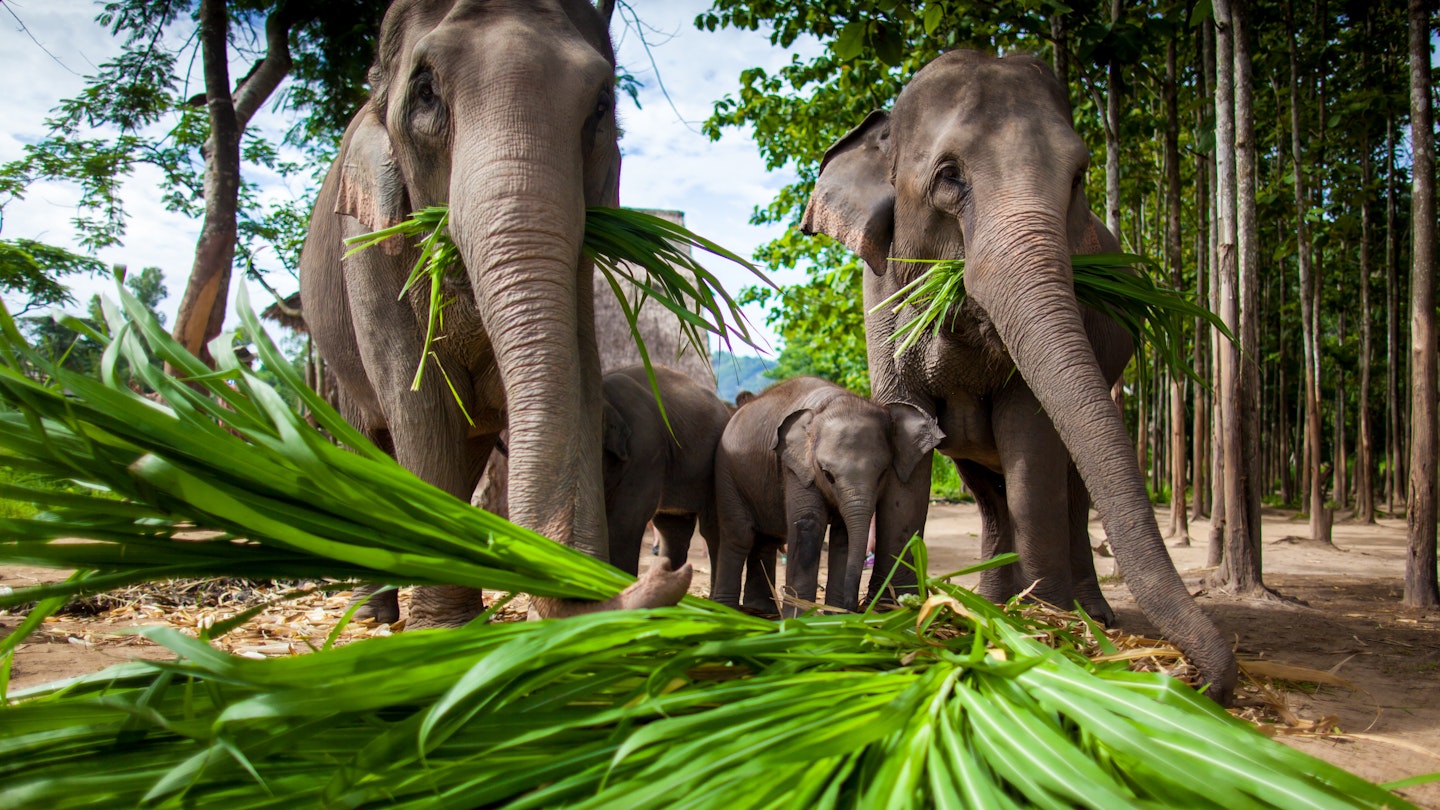
Adult and baby elephants eating sugar cane © hangingpixels / Shutterstock
Increased awareness of the harm that riding elephants can cause these remarkable animals saw Thailand ’s elephant tourism industry pivot to offer "gentler" interactions. Now, amid claims by animal welfare groups that all interactive experiences can be problematic, a growing number of global tour operators no longer include them on trips. So what options are left for travelers who want to experience Thailand’s elephants responsibly post-pandemic?
The evolution of Thailand’s elephant industry addresses the growing understanding that the nation’s long history of using elephants as beasts of burden, and the reverence of elephants in Thai culture, doesn't change the harm that is done to elephants by tourism today.
The good news is that there are now alternatives to the exploitative elephant camps where elephants are forced to perform for tourists’ entertainment. Dotted around Thailand, particularly in the northern hills around Chiang Mai and Chiang Rai , are a growing number of centers for rescued working elephants that offer a chance to encounter these incredible mammals – and help to pay for their upkeep – without causing them harm. Seeing elephants up close, while not too close, is an experience you'll remember for a lifetime, particularly if you have kids in tow.

Understanding elephant welfare issues in Thailand
There was a time when you could barely turn a corner in Thailand without seeing another billboard touting elephant rides or shows with elephants painting, balancing, or performing other circus stunts. However, that's now changed due to amendments to Thai law and because tourists have started to demand better welfare for captive elephants.
Thailand has been slow to legislate for the protection of elephants, but there have been improvements. Under Thai law, elephants are still classed as "working animals", but the new legislation will compel owners of captive elephants to provide DNA samples to the national elephant database and to register all new elephant births, allowing the authorities to better monitor the welfare of Thailand's estimated 3800 working elephants.
There is still a long way to go, with a Chiang Mai University study published in 2021, for example, finding that more than half of elephants in Chiang Mai Thai tourist facilities have nervous tics that may reflect anxiety, frustration, or boredom.
A more effective lever pushing elephant camp operators to improve standards is growing consumer awareness of elephant welfare, buoyed by the campaigning of animal welfare groups such as NGO World Animal Protection, publishers of a helpful online guide to responsible elephant interactions.
Once seen as a harmless activity, riding in howdahs (elephant carriages) is now widely recognized to cause pain and spinal damage to elephants. Even "shoulder riding" – the traditional riding technique used by mahouts (traditional elephant drivers) – is now discouraged by animal welfare groups.
Then there's the issue of the methods used to train working elephants. Young elephants are typically caged, beaten, and goaded with metal bullhooks to persuade them to submit to carrying passengers or perform circus tricks. Even fully trained captive elephants are sometimes hobbled with chains to prevent them from escaping or harming tourists.
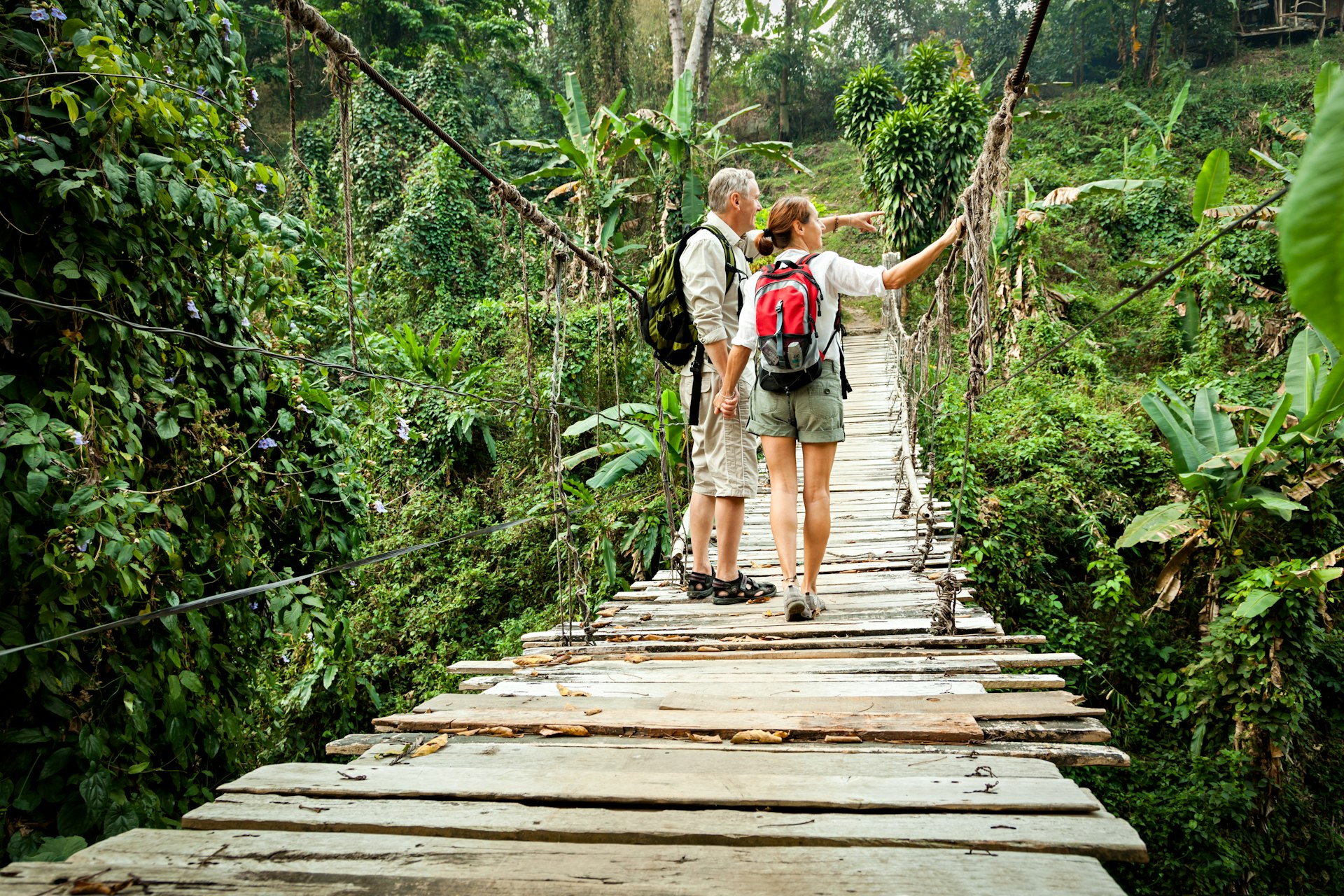
The changing face of elephant tourism in Thailand
Following tourist backlash, many elephant camps have abandoned elephant rides and shows in favor of less intrusive ways to engage with elephants, such as bathing elephants in rivers and ponds, and feeding elephants. Many camps have abandoned chains entirely, allowing captive elephants to form their own family groups, in large, open enclosures.
While this is a step forwards, some animal welfare groups encourage tourists to go further, avoiding experiences that involve direct contact with elephants because of the techniques used to train elephants to accept human interaction.
“There is still a certain element of control required for elephants to be in close contact with humans, whether it’s rides or elephant bathing,” explains Drinya Kenyon from World Animal Protection, adding that close contact with elephants also poses safety risks for tourists. “Even when elephants are under a high level of control, they can still be unpredictable.”
The global tourism industry is increasingly taking note. In 2019, ABTA , the UK’s largest travel association, updated its animal welfare guidelines to make it "unacceptable" for tour operators and travel agents (who adopt the guidelines) to offer tourists direct contact with elephants or feed elephants without a barrier.
Since 2020, Intrepid Travel has only offered trips in Thailand that help support the elephants and mahouts impacted by its 2014 decision to stop selling elephant rides. Initiatives such as these have prompted Thailand’s elephant industry to pivot once again, with a growing number of camps now transitioning to offer observation-only elephant experiences.
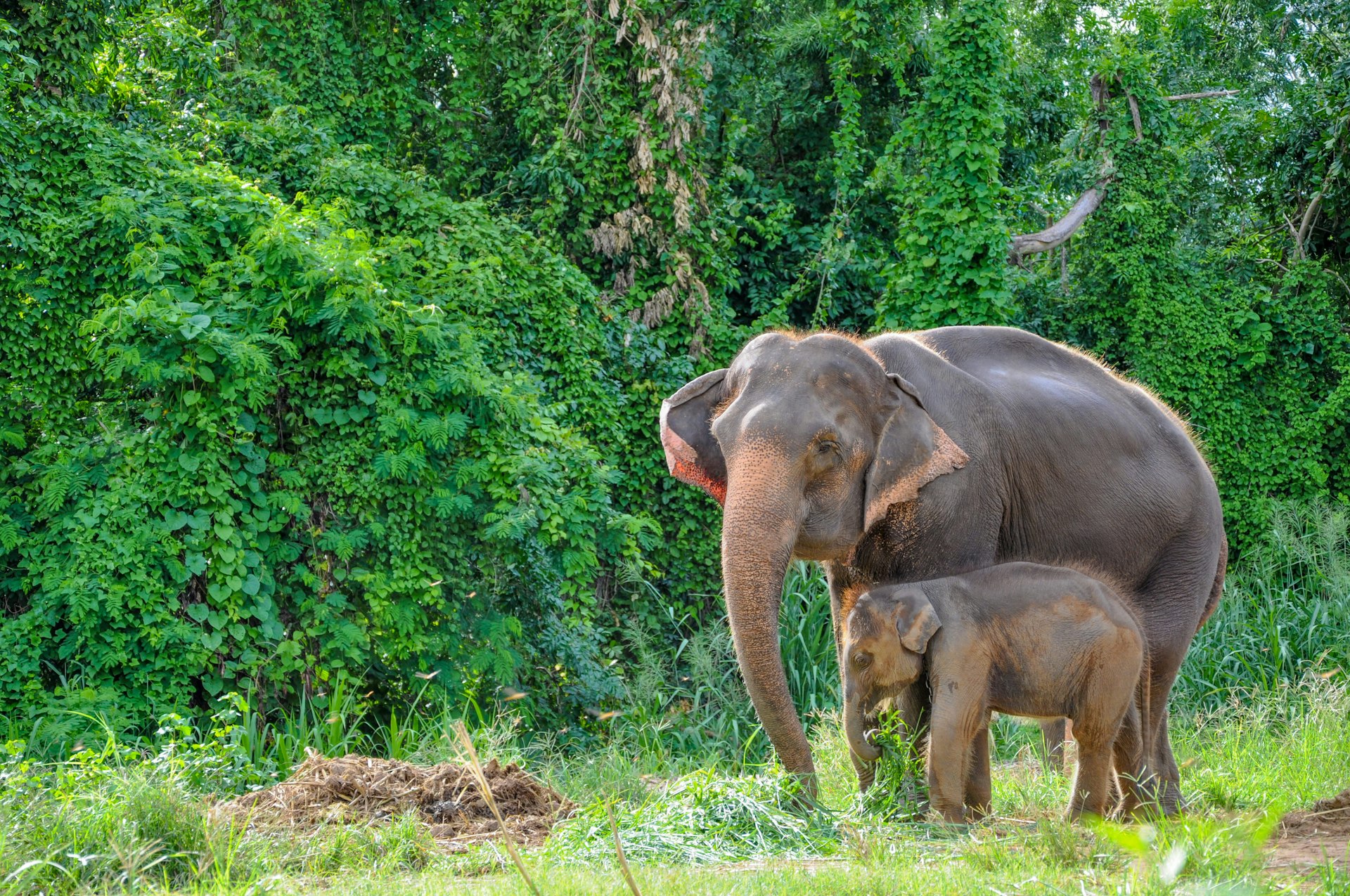
The impact of COVID-19 on Thailand's elephants
There's a valid argument for not supporting interactive elephant tourism, but the situation is complex. Most captive elephants are unable to return to the wild, and they need to be fed, exercised, and given medical treatment, placing a huge financial burden on their owners.
The COVID-19 pandemic has only increased the financial burden. By mid-2020, hundreds of captive elephants had been sold or abandoned, with owners unable to cover the cost of their upkeep due to the lack of tourist revenue. More than 85 elephant camps were closed, upwards of 5000 mahouts and other elephant camp staff lost their jobs, and some of the elephant centers that led the way in promoting good elephant welfare practice are now scraping by on bank loans and donations from concerned tourists.
With many of Thailand’s elephants on the brink of starvation by mid-2021, leading conservationist Jane Goodall stepped in to launch the Foodbank: Battle For Survival campaign in collaboration with Save Elephant Foundation founder Lek Chailert – a meaningful way to support elephants until travelers can visit Thailand again.
However, World Animal Protection claims the pandemic highlights another important reason to avoid direct contact with elephants, with Global Head of Wildlife Research Dr. Jan Schmidt-Burbach pointing out that “about 70% of emerging zoonotic infectious diseases originate from wild animals and being in close proximity with humans elevates the risk of infection.”
The lack of tourists during the pandemic has also demonstrated the unsustainability of breeding elephants for tourism. Seeing an end to this practice is a key goal of a new bill for elephant protection World Animal Protection is currently working on it with a team of experts.
With tourists now returning to the Thai Kingdom following its reopening to vaccinated tourists in November 2021, it's more important than ever to use your tourist dollars to support the ethical treatment of captive elephants. Here are five examples of high-welfare elephant tourism ventures, where elephants can be admired in a sanctuary-style environment – the next best thing to viewing them in the wild. For more, see World Animal Protection’s elephant-friendly list .
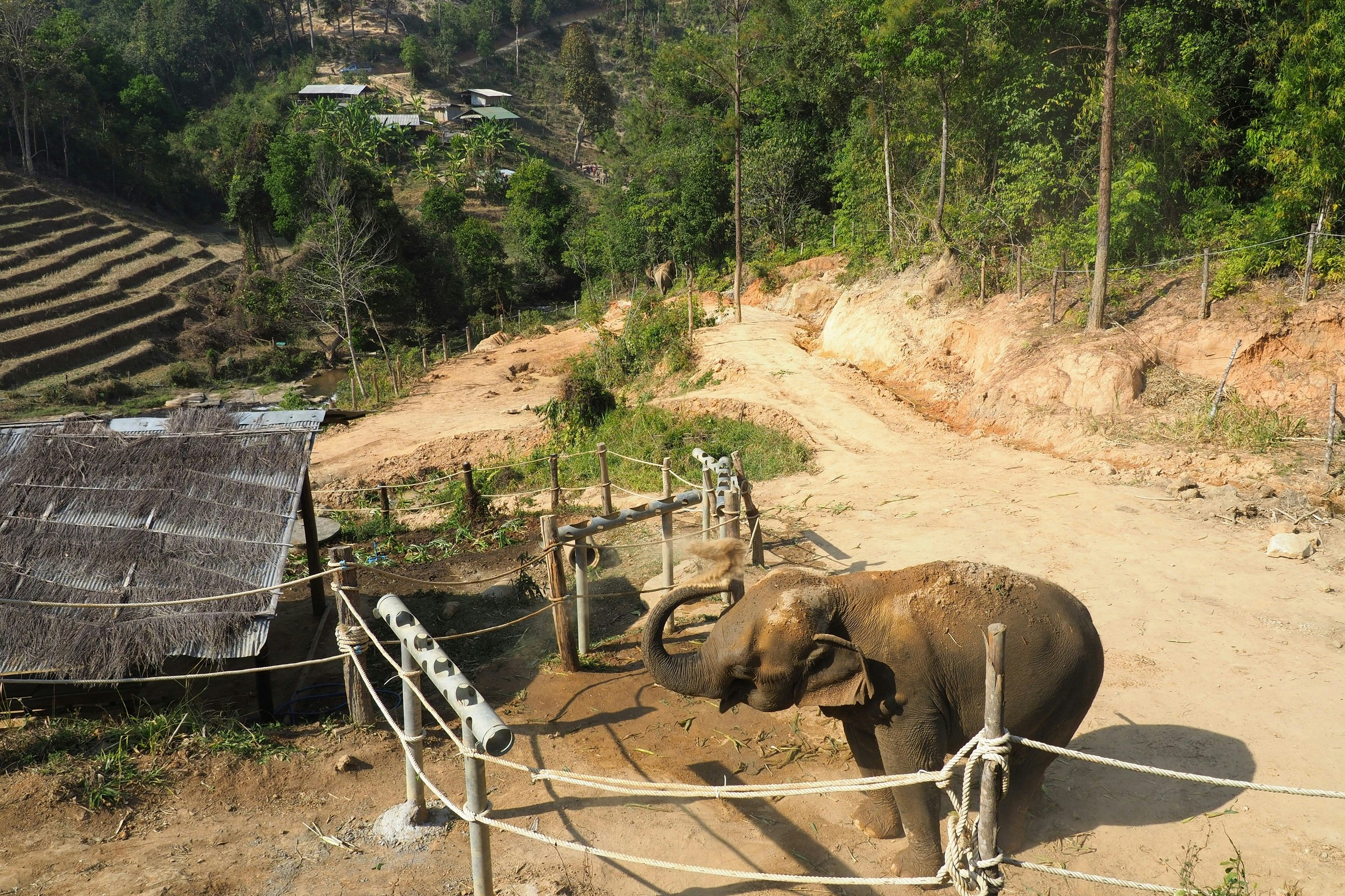
ChangChill, Chiang Mai
Opened in 2019 with support from World Animal Protection, ChangChill was the first elephant venue in the Chiang Mai area to fully transition from interactive elephant tourism to an observation-only model. Day visits begin with a jungle hike to observe ChangChill’s six female elephants moving around the hilly, jungle-covered property, an hour-and-a-half drive southwest of the city. In the afternoon, visitors relax on viewing platforms as the elephants socialize by a gurgling stream, with a guide on-hand to interpret their natural behavior. One-day visits including transfers from Chiang Mai and lunch cost 2500B (US$75).
Burm & Emily’s Elephant Sanctuary (BEES), Chiang Mai
After witnessing the hardships experienced by elephants working in tourist camps, Australian Emily McWilliam founded BEES with her Thai partner Burm Rinkaew in 2010. Visits to this lush sanctuary, a 2.5-hour drive southwest of central Chiang Mai, are structured like a mini-volunteering program, with lots of hiking to observe the natural behavior of elephants, in between helping out with elephant food preparation, construction tasks, planting trees, and other activities. BEES now has a "hands-off" policy, meaning visitors observe elephants but don't touch them. Costs start at 2500B (US$75) for a full-day visit with lunch (visiting with your own transport). Transfers are available for longer visits.
Boon Lott’s Elephant Sanctuary (BLES), Sukhothai
BLES was founded in 2007 by Briton, Katherine Connor, who dedicated her life to nurturing rescued and retired elephants after encountering a courageous baby elephant called Boon Lott ("survivor" in Thai). Visitors to BLES, located outside the village of Baan Tuek, an hour’s drive north of Sukhothai airport, get involved in all aspects of sanctuary life, from collecting elephant food from the jungle to maintaining herding areas and grazing grounds. Overnight visits including transfers and all meals cost 6000B (US$178). Due to its remote location, BLES does not run single-day tours – most visitors stay for several days on individually-tailored itineraries.

Following Giants, Ko Lanta
Also supported by World Animal Protection, Following Giants transitioned to an observation-only model in late 2019. On a day's visit to this lush Ko Lanta elephant venue, guests shadow elephants on a jungle walk and plant treats for the pachyderms to find while foraging. Those staying for the full-day program hike to a stunning cave and a waterfall, and share herbal drinks with the local mahouts . Full-day visits including transfers and lunch cost 3500B (US$105).
Phuket Elephant Sanctuary, Phuket
In 2020, this center for retired logging elephants in north-eastern Phuket opened Thailand’s largest canopy walkway, from which visitors can observe elephants simply being elephants. While feeding is allowed on some programs (half-day tours from 3000B (US$90)), a barrier separates elephants and visitors during the activity. A 7-day volunteering program is also available (18,000B (US$535).
What to bring when visiting an elephant center
Elephant centers tend to be in hot, humid rural areas. Wear lightweight clothing (with long sleeves/trousers for overnight visits) and bring a sunhat, sunscreen, DEET-free insect repellent, some sturdy shoes, and swimwear if there is a waterhole on the property, plus a change of clothes in case you get muddy.
Also bring drinking water, ideally filling your own bottle to avoid buying water in plastic bottles. Volunteers should expect basic facilities, usually simple accommodation blocks with mosquito nets, basic cooking facilities, Thai-style bathrooms, and (often) cold showers.
You may also like: Thailand's best beaches from peaceful paradises to parties The quickest, easiest and most affordable ways to get around in Thailand Jungle safaris, kayaking and bird-spotting at Thailand's top national parks
This article was first published Nov 10, 2014 and updated Jan 21, 2022.
Explore related stories
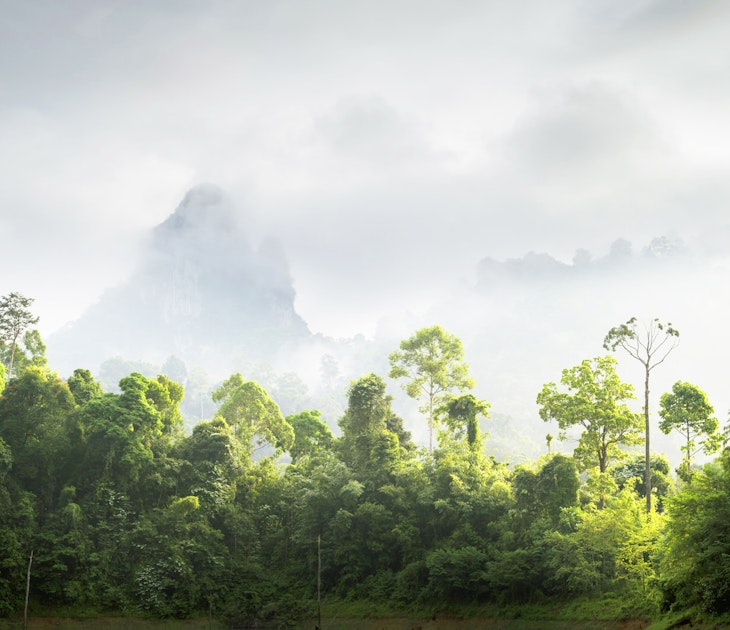
Mar 15, 2018 • 7 min read
‘Up there – can you see them?’ Scanning the evening sky above the jungle, they were alarmingly easy to spot: hundreds of Pteropus vampyrus – or flying…

Apr 25, 2024 • 8 min read

Apr 25, 2024 • 5 min read

Feb 29, 2024 • 12 min read

Feb 12, 2024 • 10 min read

Jan 31, 2024 • 11 min read
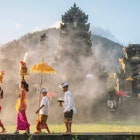
Jan 17, 2024 • 6 min read

Jan 5, 2024 • 20 min read
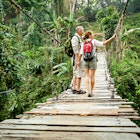
Dec 27, 2023 • 7 min read

Dec 21, 2023 • 9 min read
You are using an outdated browser. Please upgrade your browser to improve your experience.
Thailand Elephant Sanctuary – Top 10 Ethical Places You Should Visit

Thailand , a country synonymous with the majestic elephant, has seen a profound transformation in how these gentle giants are treated and revered. In recent years, the rise of ethical elephant sanctuaries has become a beacon of hope for the conservation of Asian elephants. These sanctuaries not only provide a safe haven for rescued and retired elephants but also offer visitors an opportunity to interact with these magnificent creatures in a respectful and humane environment.
As we delve into the history and ethos behind Thailand elephant sanctuary in this article , we will guide you on how to choose a genuinely ethical one and highlight the top 10 sanctuaries that are leading the charge in elephant conservation and ethical tourism in the country.
The History Of Thailand Elephant Sanctuary
As you wander through the lush landscapes of Thailand, the evolution of elephant sanctuaries tells a story as captivating as the creatures they protect. Once the backbone of the logging industry, these gentle giants trudged through Thailand’s forests until the ban on logging set them adrift. Their mahouts, whose livelihoods were intertwined with the elephants, sought refuge in the burgeoning tourism industry, which was not without its ethical pitfalls.
The early days of elephant tourism saw these majestic animals performing tricks and offering rides, a stark contrast to their natural way of life. Public sentiment and a growing awareness around animal welfare began to reshape this narrative, giving birth to the first ethical elephant sanctuaries. These sanctuaries became havens of healing and dignity, offering elephants a chance to live as they ought to—roaming freely, socializing, and bathing in the sun-dappled rivers.
In these sanctuaries, a new chapter unfolds—one where elephants are no longer entertainers but ambassadors of wildlife conservation. Visitors are invited not just to observe but to learn the importance of these sanctuaries in the broader tapestry of conservation. The travel experience has been transformed from passive observation to active education, fostering a deeper connection between humans and elephants.
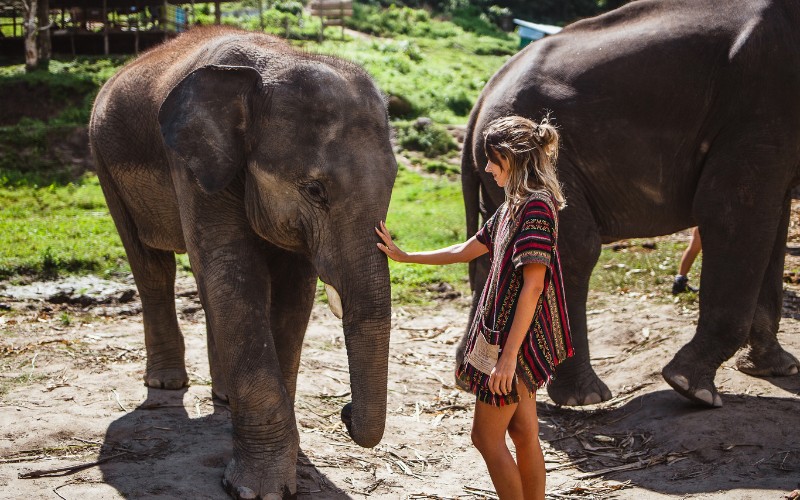
Visitors have the chance to interact with the elephants actively
The sanctuaries we celebrate today are the result of this profound shift, places where the thrum of the jungle is a backdrop to the quiet retirement of these magnificent animals. They stand as a testament to Thailand’s commitment to ethical wildlife tourism and the enduring bond between humans and elephants. As these sanctuaries continue to innovate and collaborate with global conservation efforts, they not only offer a sanctuary for elephants but also a blueprint for responsible tourism practices worldwide.
>> Read More: 13 Best Places To Visit In Thailand For First Timers
How To Find An Ethical Thailand Elephant Sanctuary In Thailand?
Factors to consider before visiting a thailand elephant sanctuary.
If you are planning to visit an elephant sanctuary in Thailand, it is crucial to make sure that you choose an ethical one. This is important not only for the safety and well-being of the elephants but also for the authenticity and value of your travel experience. To help you select an ethical elephant sanctuary, we suggest considering the following key points:
- No-riding policy: Ethical sanctuaries do not offer elephant rides. Riding can cause long-term harm to an elephant’s spine and overall health, and it’s often indicative of a place where profit is prioritized over animal welfare.
- Transparent operations: Look for sanctuaries that are open about their practices. They should be willing to discuss how they care for the elephants and what they do to ensure their well-being.
- Elephant behavior: In ethical sanctuaries, elephants should be able to express their natural behaviors. This includes roaming freely, socializing with other elephants, foraging for food, and bathing in water sources.
- Education focus: A focus on visitor education is a hallmark of an ethical sanctuary. These establishments should provide information about elephant conservation and the impact of human activities on these animals’ lives.
- Positive reinforcement: Observe the methods used by mahouts to interact with the elephants. Ethical sanctuaries use positive reinforcement rather than hooks or other tools that can cause pain and stress.
- Conservation efforts: The best sanctuaries engage in broader conservation efforts, working to protect habitats and prevent poaching, ensuring a sustainable future for elephants in the wild.
- Responsible volunteering: If a sanctuary offers a volunteering program, it should be responsibly structured. Volunteers should have tasks that genuinely contribute to the welfare of the elephants and the sanctuary’s operations.
- Adequate space: Elephants require large amounts of space. Ethical sanctuaries have extensive land to allow elephants to roam and exhibit natural behaviors without confinement.
- Veterinary care: Regular and professional veterinary care should be evident, with specialized staff to attend to the elephants’ health needs.
- Local community involvement: Ethical sanctuaries should work in harmony with the local community, providing employment opportunities and education, and ensuring that elephant welfare doesn’t come at the expense of local people’s livelihoods.
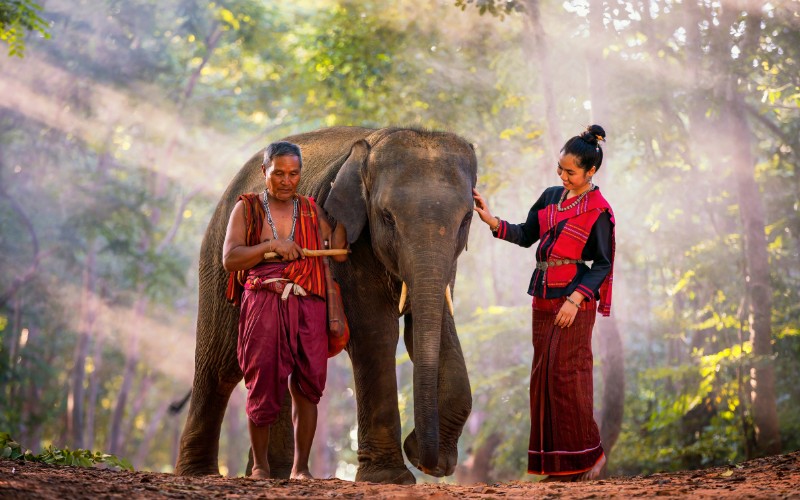
The relationship between the mahout and the elephant is important
Trusted Sources To Find An Ethical Thailand Elephant Sanctuary
There are several organizations and websites that offer recommendations and certifications for ethical elephant sanctuaries in Thailand. These can be valuable resources for travelers looking to ensure their visit supports responsible wildlife tourism.
- World Animal Protection : An international non-profit animal welfare organization that often lists and endorses ethical elephant sanctuaries that meet their strict animal welfare criteria.
- Save Elephant Foundation: A Thai non–profit organization dedicated to providing care and assistance to Thailand’s captive elephant population through a multifaceted approach involving rescue and rehabilitation programs, advocacy, and education. Their website features ethical sanctuaries like Elephant Nature Park.
- Global Federation of Animal Sanctuaries (GFAS): A global body that certifies animal sanctuaries based on rigorous standards of care. Sanctuaries accredited by GFAS are usually a safe bet for ethical practices.
- Responsible Travel: This UK-based travel agency is committed to responsible tourism and offers a curated list of ethical elephant sanctuaries that have been vetted for humane practices.
- Lonely Planet and TripAdvisor: These popular travel resources sometimes feature articles and lists of recommended ethical elephant experiences, based on traveler reviews and responsible tourism guidelines.
- The Elephant Asia Rescue and Survival Foundation (EARS Asia): They work to improve the welfare of elephants in Asia and provide a list of ethical places to visit.
Top 10 Ethical Elephant Sanctuaries You Should Visit In Thailand
Here are some of the sanctuaries that stand out for their commitment to elephant welfare.
Elephant Nature Park
- Location : In the verdant outskirts of Chiang Mai, Elephant Nature Park has emerged as a beacon of hope for elephants since its inception in 1995 by the passionate conservationist Lek Chailert.
- Its story : It’s a sanctuary that has turned the tears of over 75 rescued elephants into stories of triumph. Each elephant, rescued from the throes of tourism or logging, enjoys the freedom of the park’s expansive rainforest habitat, alongside a motley crew of other rescued animals including dogs, cats, and even water buffalo.

Elephants in the natural environment of Chiang Mai
The park’s immersive visitor experience ranges from single-day visits to overnight stays, allowing you to delve into the daily life of these majestic creatures. Volunteers contribute to the well-being of the elephants by preparing their meals and caring for the park’s other residents. For those wishing to forge a deeper connection, the park offers longer-term volunteer opportunities, which require booking well in advance due to their popularity.
>> See Tour: Essential Thailand
Boon Lott’s Elephant Sanctuary (BLES)
- Location : The intimate haven of Boon Lott’s Elephant Sanctuary resides in the serene landscapes of Sukhothai.
- Its story : Spanning 600 acres of natural wonder, this sanctuary was born from Katherine Cooper’s leap of faith, leaving behind her life in the UK to advocate for elephant welfare. The sanctuary ensures a tranquil life for its elephants, allowing them to wander through banana plantations and freshwater rivers.
With only three guesthouses, the guest experience is as exclusive as it is personal, emphasizing the elephants’ quality of life over visitor numbers. Here, days are spent in quiet contemplation of the elephants’ graceful presence and in the company of the local mahouts, whose stories are as enriching as the sanctuary itself.
The Surin Project
- Location : Situated in the small village of Baan Tha Klang
- Its story : The Surin Project tackles the complex issue of elephant abuse by addressing the economic challenges faced by traditional mahouts. It bridges the gap between the need for mahouts to earn a living and the need for elephants to live free from exploitation.
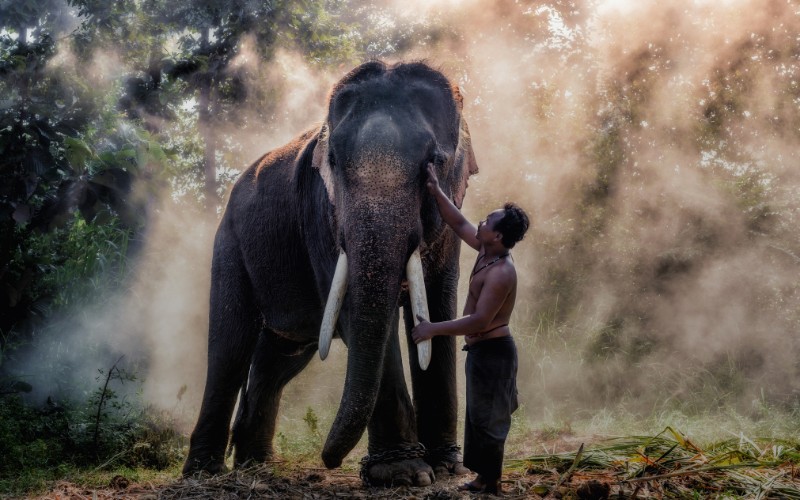
Outdoor activities of mahout and elephant
The project provides a home for nearly 200 mahouts and their elephants, preventing them from resorting to street begging or unsustainable tourism practices. Volunteers are the lifeblood of this initiative, with a minimum commitment of one week, offering a rare opportunity to immerse oneself in the culture of the mahouts and to support this vital cause.
Note : This project is currently permanently closed.
>> See Tour: Best of Thailand
Elephant Haven
- Location : In the scenic province of Kanchanaburi, Elephant Haven stands as a symbol of transformation.
- Its story : Once known as Sai Yoke Elephant Camp, this sanctuary has shed its past of chains and performances to embrace a future where elephants have the freedom to socialize and roam without the threat of hooks or entertainment duties.
In partnership with Elephant Nature Park, Elephant Haven is at the forefront of a movement reshaping the future of elephant tourism in Thailand. Visitors can join these elephants for day visits or overnight stays, embarking on jungle walks alongside these gentle giants and participating in their care with a host of other rescued animals.
Elephants World
- Location : Nestled on the banks of the River Kwai in Kanchanaburi, Elephants World is a sanctuary that lives by a simple yet profound philosophy: “We should work for the elephants, and the elephants, not for us.”
- Its story : Established in 2008 by the compassionate Thai veterinarian Dr. Samart and his wife Khun Fon, this sanctuary serves as both a refuge for injured and retired elephants and a sustainable farm. Starting with just three elephants, it has grown to provide sanctuary to 25, each with a history of hardship from logging or trekking camps.
Visitors to Elephants World are invited to respectfully observe these majestic animals in their natural behaviors—feeding, bathing, and socializing—whether for a day trip, an overnight stay, or as part of a week-long volunteer program.
Samui Elephant Sanctuary
- Location : Koh Samui, an island known for its idyllic beaches, is also home to the pioneering Samui Elephant Sanctuary.
- Its story : Spread across 10 acres of forest, it’s a retreat for a dozen elephants rescued from the burdens of logging and tourist trekking industries. This sanctuary, inspired by the Elephant Nature Park, is a testament to the power of positive change.

The elephant enjoying its natural space
Here, you can observe these magnificent creatures as they engage in natural behaviors, such as foraging and socializing, or as they splash joyfully in their custom-designed pool. The Samui Elephant Sanctuary is an intimate experience, prioritizing the well-being of elephants over the spectacle of entertainment.
>> See Tour: Thailand Temples and Beaches
Friends of the Asian Elephant Hospital
- Location : The Friends of the Asian Elephant (FAE) Hospital, nestled in Thailand’s northwest, operates as one of the world’s few elephant hospitals.
- Its story : It represents a beacon of hope for sick and injured elephants across the country. The hospital runs a mobile vet clinic that extends its healing touch to elephants in need.
During a visit, you can witness the compassionate care provided to these gentle giants and understand the complexities of treating such large animals. Since its inception in 1993, the FAE Hospital has treated over 5,000 elephants and relies on the support of visitors and volunteers to continue its noble mission.
Wildlife Friends Foundation
- Location : It is a wildlife refuge in Tha Mai Ruak.
- Its story : A rescue mission that transcends species, the Wildlife Friends Foundation in Phetchaburi offers sanctuary to a diverse array of animals, including elephants, big cats, bears, primates, and birds. Many of the over 600 animals have been rescued from deplorable conditions or were abandoned. While a significant percentage of the animals are rehabilitated and released back to the wild, the elephants, having spent extensive time with humans, remain under the sanctuary’s lifelong care.
Visitors can participate in day excursions to witness these animals thriving in a natural habitat and volunteer to assist in the daily care and environmental enrichment of over 20 elephants and other residents.
Phuket Elephant Sanctuary
- Location : It stands as the indisputable pioneer of ethical elephant sanctuaries in Phuket.
- Its story : A beacon for ethical elephant treatment, the Phuket Elephant Sanctuary is a refuge for those who have suffered from the tourism and logging industries. Partnering with Save the Elephant Foundation, the sanctuary is nestled against the backdrop of Khao Phra Thaeo National Park, offering a serene environment for elephants aged between 36 and 70 years.
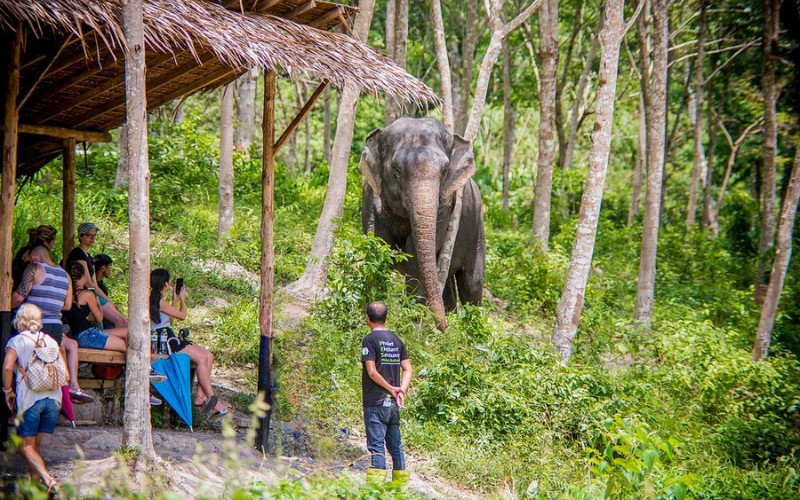
Witness a giant friend at a very close distance
The sanctuary features a treetop observation deck, allowing visitors to discreetly observe the elephants as they forage, bathe, and interact within their herds in expansive natural enclosures, complete with freshwater lagoons and hydrotherapy mud pools.
>> Read More: An Expert’s Guide On The Best 10 Things To Do In Phuket
Elephant Hills
- Location : Elephant Hills blends the concept of an African safari tent camp with the stunningly gorgeous surroundings of Khao Sok, Southern Thailand.
- Its story : This sanctuary provides a haven for elephants to live freely in the jungle, away from the chains of captivity. Recognized for its exceptional care of elephants, Elephant Hills has earned accolades for meeting all core criteria in an audit by Global Spirit. The sanctuary’s dedication to improving the lives of its elephants is matched only by its commitment to offering guests an immersive experience.
You can stay in one of two glamping camps, blending the adventure of jungle trekking, kayaking, and cultural exploration with ethical observation and learning about the sanctuary’s elephants.
Travel Ethically With Asia Pioneer Travel
The existence of these ethical elephant sanctuaries across Thailand is a beacon of hope, offering a humane and inspiring alternative to traditional elephant tourism. Each visit supports a future where elephants are treated with the respect and care they deserve. As travelers seeking meaningful experiences, we have the power to drive positive change by choosing destinations that prioritize animal welfare.
Asia Pioneer Travel aligns with this vision, pledging to offer trips exclusively to ethical sanctuaries. We ensure our tours contribute positively to the welfare of elephants, echoing our commitment to responsible tourism. When Crafting Your Journey With Us , you’re not just planning a trip; you’re investing in a future where tourism is a force for good. So contact our delicate travel designers and let your journey be a step towards a more compassionate world!
You may also be interested in
Tours you might like.

Thailand Holiday: Bangkok, Phuket & Koh Yao Yai 11 Nights
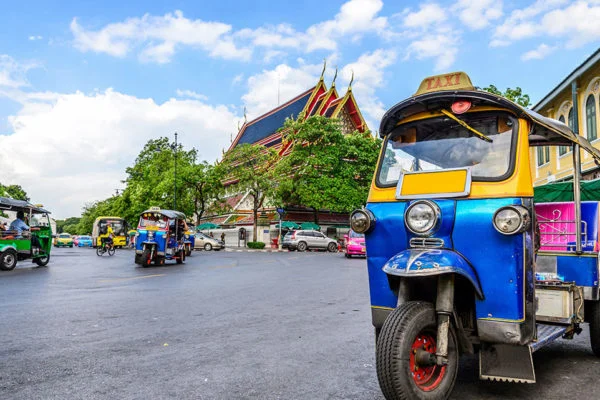
Vietnam, Cambodia & Thailand Tour

Thailand Family Holiday
The best places to see elephants in Thailand
- March 16, 2024
Ethical elephant experiences in Thailand
Thailand’s majestic elephants have long been a symbol of cultural significance and natural beauty. However, their welfare has often been compromised by unethical practices such as riding, bathing, and performing. Fortunately, a growing number of sanctuaries and conservation areas now offer ethical encounters that prioritize the wellbeing of these gentle giants. Here are some of the best places to see elephants in Thailand.
1. Elephant Nature Park, Chiang Mai
Located in the lush forests of northern Thailand, Elephant Nature Park is a renowned sanctuary dedicated to rescuing and rehabilitating elephants from exploitation. The sanctuary provides a natural haven for rescued elephants, offering them a safe and humane environment to roam freely. With around 80 elephants, each with their own unique story of rescue and rehabilitation, visitors can observe these gentle giants up close, learn about their behaviours, and participate in ethical elephant interactions, fostering a deeper understanding and appreciation for these magnificent creatures. Here, visitors can observe elephants roaming freely in their natural habitat, without any riding or performance shows. You can spend your day feeding, observing, and even walking alongside these magnificent creatures. The park is also home to a menagerie of other animals including warthogs and water buffalo. Visit as a day trip or longer, more immersive volunteer stay.
2. Boon Lott’s Elephant Sanctuary (BLES), Sukhothai
Boon Lott’s Elephant Sanctuary (BLES) , situated in Sukhothai, Thailand, offers a serene setting amidst verdant forests and rolling hills. Founded by a Brit, the sanctuary’s intriguing name is dedicated to a baby elephant of the same name (meaning survivor in Thai). The sanctuary emphasizes education and conservation efforts, striving to raise awareness about the challenges facing Asian elephants while providing a sanctuary where they can thrive in a natural environment. Home to a smaller number of elephants, typically around 10 to 15, BLES prioritizes individualized care and rehabilitation for each resident elephant. Volunteers to BLES can get stuck in gathering and preparing food and looking after the grounds.
3. Khao Yai National Park
For those seeking the best places to see elephants in Thailand in the wild, Khao Yai National Park offers a pristine habitat where these magnificent creatures roam freely. As one of the largest protected areas in the country, Khao Yai provides a vital habitat for around 300 wild Asian elephants. These elephants play a crucial role in maintaining the park’s biodiversity, shaping the landscape through their browsing and movement patterns. Visitors to Khao Yai have the opportunity to spot these majestic creatures while trekking through the park, offering a rare glimpse into their natural habitat and contributing to ecotourism efforts aimed at their conservation.
4. Elephant Hills, Khao Sok National Park
Elephant Hills is a luxury tented camp located in Khao Sok National Park, Thailand, nestled amidst towering limestone cliffs and lush rainforests. Elephant Hills provides a unique opportunity for visitors to learn about elephant conservation while enjoying the stunning beauty of southern Thailand’s wilderness.The camp offers immersive experiences with rescued Asian elephants in their natural habitat. With around 10 elephants, guests can observe and interact with these gentle giants in an ethical and sustainable manner. Guests can observe elephants in their natural habitat during guided jungle excursions, where encounters prioritize observation and conservation education.
5. Surin Project, Surin Province
The Surin Project focuses on ethical elephant tourism while empowering the local community of the Surin province. This ethical elephant sanctuary is home to around 10 to 15 rescued Asian elephants. Visitors to the Surin Project can participate in responsible elephant interactions, learning about their conservation and rehabilitation while supporting local communities. Visitors can also participate in volunteer programmes aimed at supporting elephant welfare and community development initiatives.
6. Wildlife Friends Foundation Thailand (WFFT), Petchaburi Province
Wildlife Friends Foundation Thailand (WFFT) is located in Phetchaburi province, Thailand, surrounded by lush tropical forests and rolling hills. The sanctuary provides a safe haven for rescued wildlife, including approximately 20 elephants. Situated on a vast expanse of land, WFFT offers spacious enclosures and natural habitats where elephants can roam freely and receive specialized care. Visitors can engage in educational experiences and responsible interactions with the elephants, learning about their conservation and rehabilitation efforts. WFFT is dedicated to rescuing and rehabilitating animals from exploitation and promoting awareness about wildlife conservation in Thailand.
7. Phang Nga Elephant Park, Phang Nga Province
Nestled in the picturesque province of Phang Nga, this sanctuary offers a compassionate approach to elephant tourism. The park is home to a small number of elephants, typically around 5 to 7 individuals. Set against the backdrop of tropical forests and rolling hills, the park offers visitors the opportunity to engage in responsible elephant interactions and learn about elephant conservation efforts. With a focus on ethical tourism practices, Phang Nga Elephant Park provides a peaceful sanctuary where guests can observe and connect with these majestic creatures in a natural environment.Visitors can spend their day observing elephants in a natural environment, learning about their behaviours, and participating in enrichment activities.
8. Koh Samui Elephant Sanctuary, Koh Samui
Located on the tropical island of Koh Samui, this sanctuary provides a haven for retired and rescued elephants. Visitors can embark on guided tours to observe these gentle giants as they roam freely in their natural habitat. Interaction with the elephants is limited to ethical encounters, such as feeding and observing from a respectful distance.
Change Location
Find awesome listings near you.

5 Ethical Elephant Sanctuaries to Visit on Your Next Trip to Thailand
These five sanctuaries across thailand offer tourists alternative ways to see elephants while providing the gentle giants a safe place to live..
- Copy Link copied

The best way to see elephants is to simply view them from a distance in their natural habitat.
Photo by tdee photo cm/Shutterstock
Many travelers dream about snapping a selfie with an elephant while on vacation in Thailand. Sadly, elephant tourism in the country is complex and often harmful to the animals—and riding, bathing with, and even photographing elephants can contribute to their suffering. There are an estimated 3,800 elephants living in captivity in Thailand —a sobering number considering there are only an estimated 3,000 living wild within the country’s jungles. But at a few trustworthy places across Thailand, you can get up close and personal with our long-trunked friends while knowing that they are being treated with dignity and respect.
Why travelers need to choose carefully
The organizations on this list shelter elephants who have endured a lifetime of abuse in both the tourism and logging trades. Elephants held in captivity experience low birth and fertility rates , so many in the tourist industry are kidnapped from their mothers in the wild. Those forced to entertain visitors—activities that may involve rides, bathing with guests, or being made to do tricks like painting self-portraits —are subjected to “ the crush” where they are kept confined in tiny quarters, beaten, stabbed with bull hooks, and starved so they will learn to obey the commands of their mahout (elephant handler).
Before logging was officially banned in Thailand in 1989, elephants were used much like any other draft animal and helped loggers transport massive quantities of timber. Elephants working in the logging industry were often injured by falling trees and splintered stumps, abused by cruel mahouts, and sometimes overworked to the point of injury, miscarriage, or death. Once the new law was in place, many mahouts turned to tourism to keep up with the cost of maintaining their elephant. And although the practice of logging jungles was officially banned decades ago, illegal logging is an issue for the country, and elephants are still used to log .
Tourism once generated about $500 million a year for the Thai elephant trade, but the industry collapsed during COVID-19 and many animals met grisly fates or (hopefully) ended up at sanctuaries. Abuse and captivity are especially tragic considering that elephants possess the same mental capacity for self-recognition, language, and social awareness (and perhaps even more ) as humans— zoo-psychosis is a real thing.
Sadly, there is no regulatory Thai agency that oversees the treatment of elephants, nor is there an official vetting process when it comes to evaluating the ethics of a sanctuary. But as a rule of thumb: The most ethical way to see elephants is to view them from afar in their natural habitat. The most humane sanctuaries will let the elephants be while giving them a safe place to live and a constant stream of food to eat that would be a part of their natural diet. So, if you ever see anyone riding an elephant, encouraging people to bathe with elephants, or making the animals do tricks, stay away. And keep in mind that the best way to love elephants is to support the preservation of their natural habitats and prevent deforestation. Though much is out of ordinary people’s hands, consider donating to NGOs like Conserve Natural Forests and avoiding products with palm oil in them.
Here are five elephant sanctuaries to consider on your next trip to Thailand:

Boon Lott’s Elephant Sanctuary currently cares for nine elephants.
Photo by New Hope/Shutterstock
1. Boon Lott’s Elephant Sanctuary
In 2005, British animal activist Katherine Connor Connor rescued a baby elephant from the tourist trade, whom she named “Boon Lott” (which means “survivor” in Thai). Tragically, the elephant died in her arms following complications that arose after an accident left the two-year-old partially paralyzed. Determined to save other elephants trapped in the tourist trade, she founded Boon Lott’s Elephant Sanctuary , located in the village of Baan Tuek near the Myanmar border.
Today, the sanctuary focuses on rescuing elephants from the tourist and logging trades. Elephants at Boon Lott’s are given specialized care for ailments like amputated or injured feet (there are still thousands of landmines littering the Thai jungle) and are given free rein to roam the 540-acre reserve. Three teak guesthouses on the property sleep two each, but the sanctuary is popular so book far in advance . Travelers can walk with elephants to their grazing pastures, plant vegetation such as grass, bamboo, and vegetables for the pachyderms to munch on, and more.

In addition to elephants, Wildlife Friends Foundation also takes care of monkeys, jungle cats, and other types of Thai wildlife.
Courtesy of Wildlife Friends Foundation
2. Wildlife Friends Foundation
Tha Mai Ruak
In addition to being a refuge for retired and rescued elephants, Wildlife Friends Foundation is a fully equipped animal hospital and rescue center. Situated in the province of Tha Mai Ruak, this elephant sanctuary rehabilitates injured wild animals and releases them back into the wild; shelters abused and neglected animals, including elephants, monkeys, bears, and gibbons; provides high-quality veterinary care; and educates the public and locals about the perils of wildlife tourism and the illegal pet trade.
Visitors are allowed to view the elephants but rides and bathing are strictly prohibited. Day visits start at $48 per person, while half days are $33. The foundation conveniently offers lodging on the premises; prices start at around $100 a night. Wildlife Friends also relies on volunteers to help with such projects as restoring the local forest. If you’re down for a longer stay—and some hard labor that will improve the lives of Thai animals—this is a place to add to your list.
3. Burm and Emily’s Elephant Sanctuary
In 2009, Emily Rose McWilliam, who grew up in Australia, traveled to Thailand, where she encountered Indian elephants (the most common subspecies of Asian elephants found in Thailand) for the first time—and, sadly, the abuse they endure. In 2010, McWilliam, along with her partner, Burm Pornchai Rinkaew, who’s originally from Chiang Mai, made plans to create a retirement sanctuary for elderly elephants. One year later, the couple’s dream became a reality when they founded Burm and Emily’s Elephant Sanctuary .
Today, the couple take care of three female elephants who are free to roam and socialize across the property as they please. The elephants’ comfort is a top priority and no bathing, riding, or any other form of interacting with the elephants is allowed. Volunteers are welcome to help with various tasks around the sanctuary, like planting more greenery, but guests can book day or overnight visits as well. Lodgings are traditional Thai-style rooms, and northern Thai cuisine (a bit spicier than its southern counterpart thanks to Malay, Burmese, and Chinese influences) is served on site.

Mahouts Elephant Foundation focuses its efforts on reintroducing elephants back into their natural habitats.
Photo by Oriol Querol/Shutterstock
4. Mahouts Elephant Foundation
Mahouts Elephant Foundation is not a traditional Thai elephant sanctuary. Rather, this organization returns captive elephants to their natural, forested habitat on thousands of acres in northern Thailand. Founded in 2014 by the Blaine family—who are originally from the United Kingdom—Mahouts Elephant Foundation champions safari-style elephant interactions where tourists can view the majestic creatures at a safe and respectful distance.
Working in partnership with local indigenous Karen people, they’ve created a unique, ethical tourism experience and hope that other communities across Thailand will adopt a similar model. The foundation doesn’t offer traditional day visits, but Mahouts does have two night programs and a weeks stay for community volunteering.

Never Forget Elephant Foundation offers hikes, yoga retreats, and overnight stays at its headquarters in northern Thailand.
Courtesy of Never Forget Elephant Foundation
5. Never Forget Elephant Foundation
Never Forget Elephant Foundation runs a program that is fairly similar to Mahouts Elephant Foundation. Rather than housing elephants in a sanctuary, Never Forget Elephant Foundation instead works to release captive elephants back into their natural habitat in the Thai jungles. In addition to working directly with pachyderms, the organization also prioritizes working with the local Karen Hill Tribe (famous for their weaving abilities) to help change their relationship with elephants in a way that offers long-term solutions for all parties involved.
NFEF offers guided hikes, yoga retreats, and overnight stays at its headquarters in northern Thailand. There are several traditional, Karen Hill Tribe–style bamboo huts on site that can house up to three people, as well as a garden and a full-service kitchen that serves plant-based meals.
>> Next: With No Tourists, Thai Elephants Return to Natural Habitats

Finding the Universe
Travel tales, photography and a dash of humor
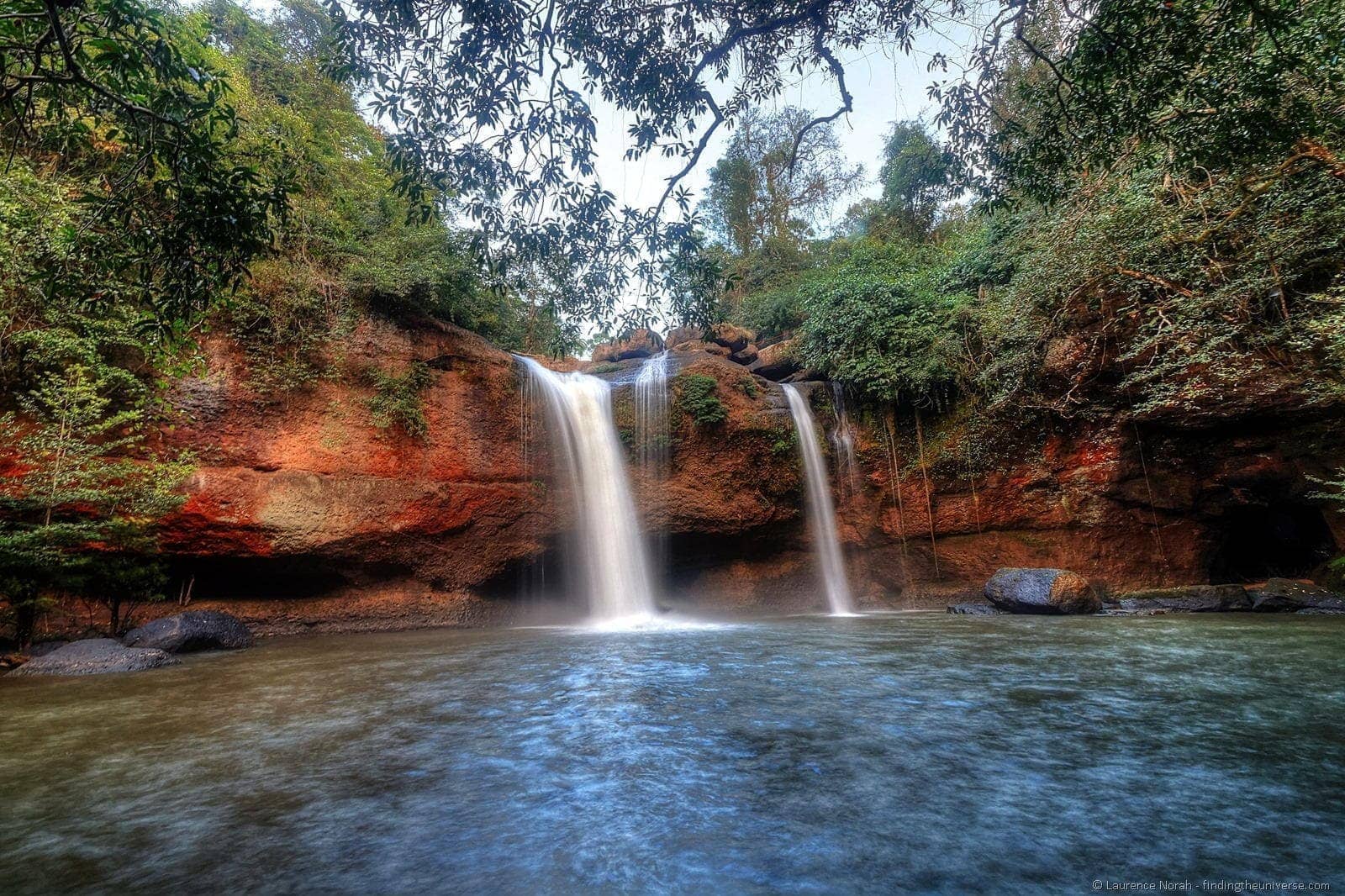
Seeing elephants in the wild: Khao Yai National Park, Thailand
Last updated: February 21, 2023 . Written by Laurence Norah - 8 Comments
Nature! Thailand has no shortage of gorgeous natural areas to explore, and Khao Yai was right up there as one of our favourites. It was the only place in Thailand where we saw elephants in their natural habitat, as well as countless other species of animals, from deer to gibbons.
In today’s post I’m going to tell you all about what we got up to in Khao Yai. First though, some where and what.
Where and what is Khao Yai National Park?
Khao Yai National Park was the first national park to be established in Thailand. It’s to the east of Bangkok, not too far away from the regional city of Nakhon Ratchasima (also known as Korat). These days it is the second largest national park in Thailand, and along with a number of other surrounding natural areas, is a UNESCO listed world heritage site.
The park is fairly mountainous, with winding, monkey strewn access roads which offer gorgeous glimpses of lushly forested slopes. It has a visitor centre and there’s a lot to see and do, from wildlife walks to waterfall hunting. We spent a couple of days in the park, and this was what we got up to.
What to do in Khao Yai
Finding elephants on a nature walk.
Khao Yai National Park is one of the best places in Thailand to see Asian elephants in the wild. There are two good ways to do this, the first being by night safari (see below), and the second by guided walk.
Our first adventure in Khao Yai was therefore a guided walk, which involved us meeting up with a ranger, being issued with leech socks (we hadn’t by this point had the joy of the leech infested Khao Sok to know what these were for), and then setting off with our guide.

This was pretty handy – as with other national parks where we did a similar walk the guide knew all kinds of stuff about the local flora and fauna, including medicinal uses, and kept us entertained as we went. We saw ancient bear scratching posts, giant insects, and all kind of fascinating trees.
The piece de resistance though came when the guide suddenly motioned us to stop, and we were able to hear large crunching noises in the undergrowth.
Looking faintly concerned, our guide explained that there were elephants in the undergrowth, and we had to be careful, as they had a baby with them.
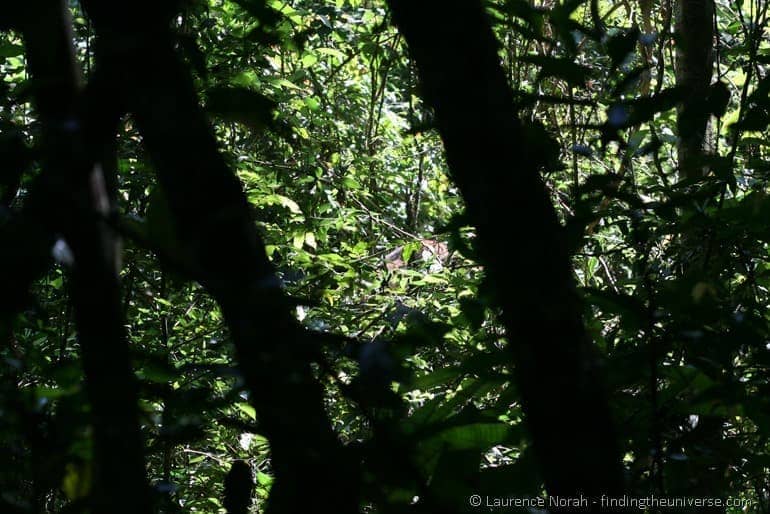
Now, I’m not going to lie, our view of the elephants wasn’t exactly mind blowing. There were hints of brown and grey through the foliage, with the occasional whisk of a tail and the waving of a trunk. The photos largely reflect this. But still. We did see elephants in the wild in Khao Yai, and that left us on a high for the rest of the day!
Even if we hadn’t seen elephants though, the walk would have been worth it. Starting off in jungle, and finishing on a huge grassy plain by a waterhole, it felt more like Africa than Thailand. And at only 3km it was easy enough for folk of any fitness.
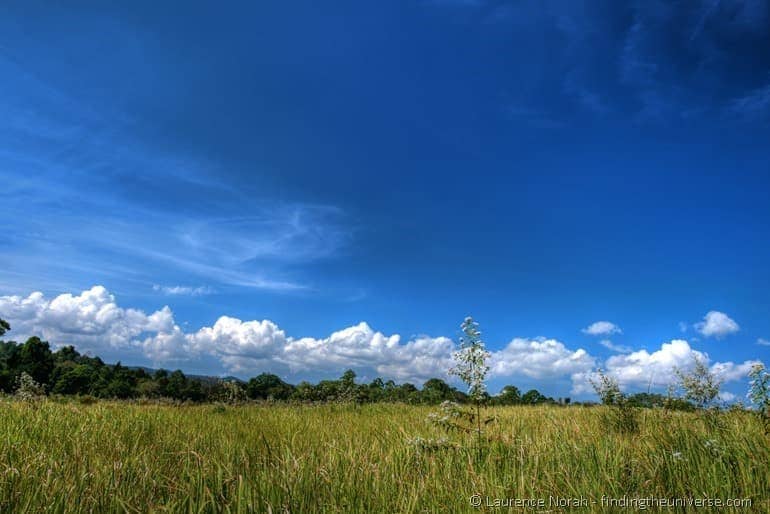
Note – the guide fee was 200 Baht for the two of us, and remains the same regardless of group size. A guide is very much recommended as the path isn’t always clear and you don’t want to get lost in Thailand’s second largest national park! They can be arranged at the national park office in the centre of the park.
Watching the bats emerge at sunset
Just outside the national park itself, there is a large limestone cave which is home to around a million bats. These chaps are asleep all day, but as the sun sets, they launch themselves into the sky in an effort to catch themselves a bit of food.
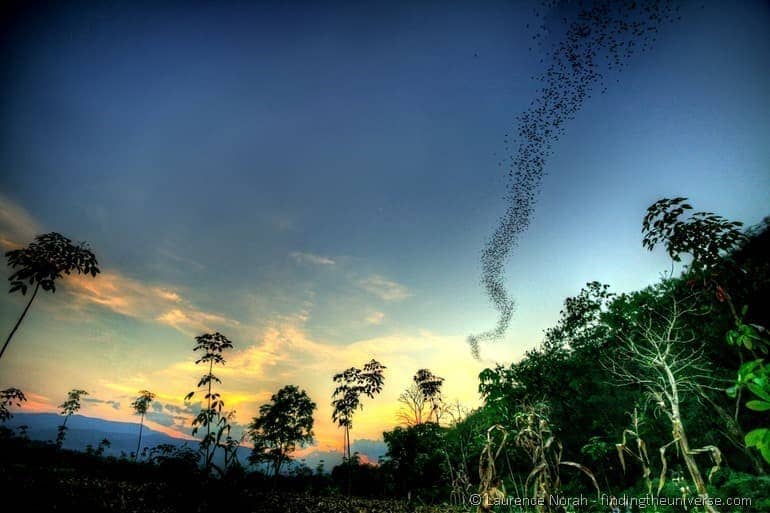
The spectacle that results is quite unlike anything I’ve ever seen. Thousand upon thousands of bats stream out of the cave entrances on the hill in a giant bat ribbon that flows undulating across the sky. Hawks circle, looking for an easy meal, with the bats surviving through sheer weight of numbers. Throw in a gorgeous sunset and it’s a sight you are never going to forget.
Taking a night safari to spot game
One of the problems with trying to see animals in any national park is that a great number of them are a lot more active in the cool of the night than the heat of the day.
It is for this reason that a night safari is an excellent way to see a whole range of animals that would be fast asleep and well hidden during the day.
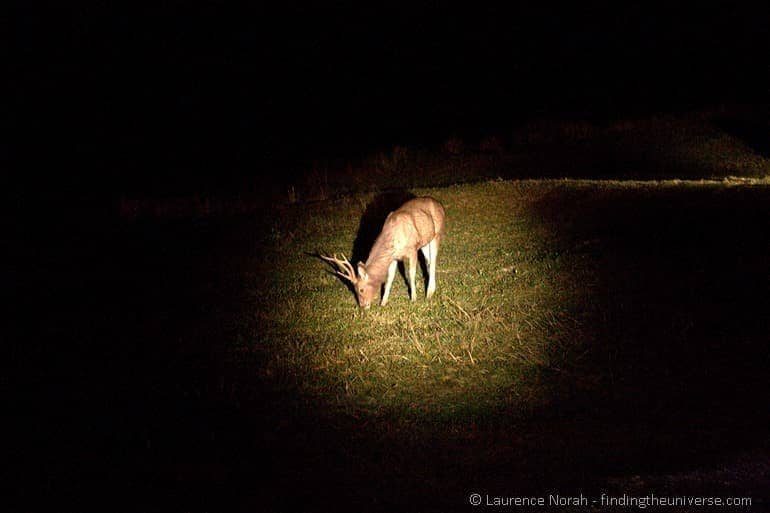
In Khao Yai nightly safaris take the form of some open topped pick up trucks with a couple of rangers in each – one driving and one operating a very bright spotlight with which to see the various animals. It does seem a bit weird to be driving around in the darkness in a line of pickup trucks shining lights on animals, but I have to admit that it is a great way to see animals, none of which seemed particularly perturbed by our actions.
As the full moon rose above our convoy we were thrilled to see all kinds of animals, from massive deer through to porcupines and of course, lots and lots of monkeys. Definitely worth doing. If you want to do a night safari you just need to arrange it from the national park office, and when we were there the fee was 200 Baht for the vehicle and driver, which could accommodate about eight people.
Go waterfall hunting – with a chance of crocodile
I do enjoy a nice waterfall, and Khao Yai has no shortage on offer. We were particularly impressed by Haeow Narok, which splashes down 150m of rock face, and earns the title of largest waterfall in Khao Yai.
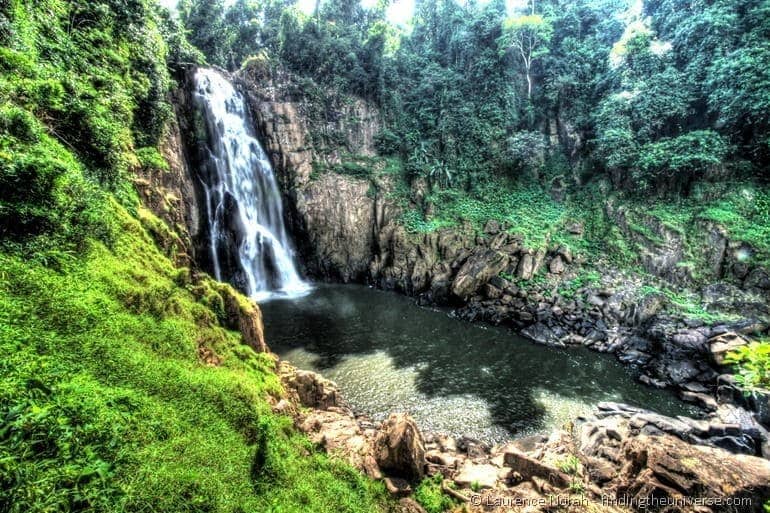
The walk down to the viewing platform is fairly steep, but it is very much worth it for the view.
There are of course other waterfalls in the park, and if you are lucky, on one of the walks you may come across the parks lonely resident Siamese Crocodiles. How they got into the park remains a mystery, with the popular opinion being that they were released here by someone who didn’t want crocodiles any more. At up to three metres long, they are an impressive sight for sure.
We spotted one basking in the sun on a log as we walked to Haeo Suwat waterfall – another impressive sight that tumbles into a large plunge pool deep in the forest. Although there is handily a campground just up the road, which was stuffed to the gills when we popped by.
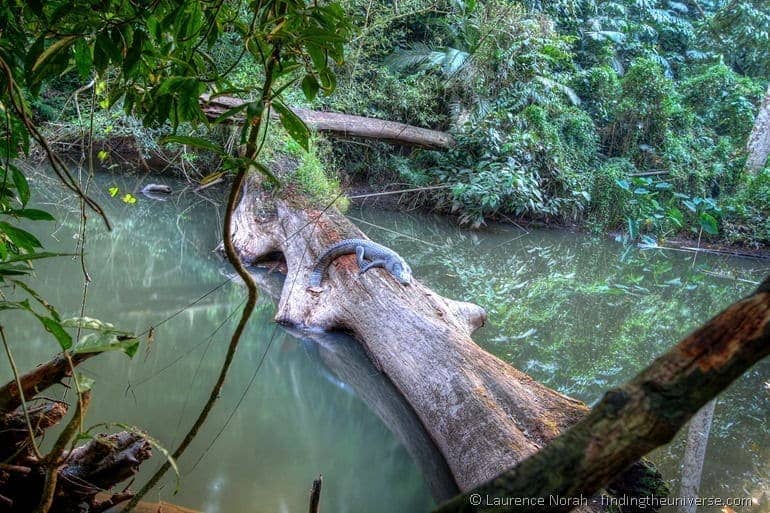
Entry fees for Khao Yai
Entry to Khao Yai was 400 Baht per person for a foreigner when we visited in early 2013. These fees apply for each day that you visit, although if you leave the park and re-enter on the same day you don’t get charged twice.
How to Get Around Khao Yai
There was no public transport to get around Khao Yai that we could see, so sorting out your own transport – be that a car with driver or a scooter – is going to be the way to go. We had a vehicle with driver.
Another option is to arrange a tour with a local operator, or through the park office, and this will come with transport.
How to Get to Khao Yai
Khao Yai is found on the main road between Bangkok and Nakhon Ratchasima (also known as Korat). Our route had us arriving in Korat, and then picking up local transport here, however most buses or trains stop in Pak Chong before they get to Korat, and this is the closest main town to the park.
From here you can arrange transport in the form of a songthaew (local pickups that serve as taxis) to the park area.
Where to Stay in Khao Yai
You can stay in the park under either canvas or in cabins, both of which can be booked via the park office.
There are also a number of options outside the park which will be able to help you out with tours into the park, and might be the best option if you want something easier. We’d suggest focusing on the town of Mu Si, which is the closest to the park. Here are some ideas:
- Baan Saranya Khaoyai – features bungalows with air-conditioning, hot showers, and WiFi.
- The Jungle House – with a garden terrace, free wifi and shared kitchen, this property is only 1.6 miles from Khao Yai and can organise tours into the park
- Lala Mukha Tented Resort – If you prefer your tent to come with a real bed and flat screen TV, this glamping experience is a great option.
There are loads more options in Mu Si, check them all out on booking.com here .
Tours to Khao Yai
- A full day trekking trip through Khao Yai , with departure from Bangkok. Includes entry fees, water, and a full lunch, as well as raincoats and leech socks.
- A Tour of Khao Yai that also includes a visit to a local market and a Thai cooking class.
- A full day tour of both Khao Yai and Ayutthaya , including entry fees to the major attractions, guide, water and raincoats / leech socks
Further Reading for Visiting Thailand
We’ve written a great deal about Thailand to help you plan your trip here. Here are some of the most useful posts for your research.
- A detailed two week Thailand itinerary
- Thailand has a lot of street dogs, read our guide to dealing with street dogs in Thailand so you know how to handle them
- A guide to visiting Ayutthaya , one of our favourite old cities in Thailand
- Tips for visiting Sukhothai during Loi Krathong , one of the most popular festivals in Thailand
- Our tips for what to do in Kanchanaburi – there’s a lot more here than the Death Railway!
- A guide to visiting the beautiful Khao Sok National Park
And that’s it! We hope you found this post useful, as always, do let us know your comments and feedback below.
Enjoyed this post? Why not share it!
There are 8 comments on this post
Please scroll to the end to leave a comment
18th September 2019 at 1:29 pm
Hi, may I know did you hire the ranger at the national park center? How much does it cost? Thanks!
Laurence Norah says
18th September 2019 at 1:30 pm
We arranged it through the centre, but I have to be honest that I don’t recall the cost! Sorry about that,
Gintare says
27th January 2019 at 9:06 am
Hi, which one you enjoyed more – Khao Sok or Khao Yai?
27th January 2019 at 9:45 am
I think the lake part of Khao Sok was my favourite, but for hiking and wildlife I prefered Khao Yai (less leeches!)
22nd November 2018 at 6:43 am
Some errors in this.
You say it’s the second largest then you say it’s the largest national park.
Thailand doesn’t have any baboons…
400 baht is not per day, it’s per visit. Stay 5 nights you still pay just 400 baht.
Why do you keep spelling it khao yoi?
22nd November 2018 at 1:47 pm
Thanks for your feedback, much appreciated 🙂 I have updated the post per your comments. My only query is around the 400baht per day – my understanding is that it’s 400 baht for one day (so you don’t have to pay if you leave and re-enter on the same day). It’s also 400 baht if you stay in the park for a few days. However, if you leave and come back another day, it’s another 400 baht. Is that correct?
Thanks again!
tony DOWNEY says
7th September 2018 at 3:06 pm
Hi, please, please, please can you help with how to plan this trip, We have been to Thailand and loved the off the beaten track places, real Thailand, real wildlife and your little trip here in Khao Yai seems the perfect thing for us.
Can you maybe expand on best ways to get there, places to stay, etc…we have two weeks coming down from Chiang Mai to Surat Thani and would love to spend a few days doing just what you describe. Really hope you can email us
8th September 2018 at 12:26 pm
Hey Tony! Thanks for getting in touch. I have updated the post with some content that should help you a bit with your planning based on your questions. My advice is to get somewhere local like one of the hotels I recommend, and then arrange transport or a tour from there, which will likely be the easiest way to go.
Leave a Reply Cancel reply
Your email address will not be published. Required fields are marked *
Let me know when there's a reply to my comment (just replies to your comment, no other e-mails, we promise!)
Subscribe to our monthly Newsletter where we share our latest travel news and tips. This also makes you eligible to enter our monthly giveaways!
We only ask for your e-mail so we can verify you are human and if requested notify you of a reply. To do this, we store your data as outlined in our privacy policy . Your e-mail will not be published or used for any other reason other than those outlined above.

Thailand Travel Diaries
All About Thailand
The Best Places To See Elephants In Thailand
If you want to see elephants while you’re in Thailand , you’re not sure which tourist destinations to choose. The best places in Thailand where you may encounter the giant friends of the nation are on our list. The places on this list are only those that adhere to rigorous guidelines for animal welfare and prohibit guests from riding elephants.
Elephants In Thailand: Elephant Nature Park
One of the most prominent and well-known elephant conservation initiatives in the country is commonly regarded as the Elephant Nature Park. Elephant Nature Park is located in northern Thailand , close to the city of Chiang Mai. More than 35 free-ranging elephants may be seen in this park, many of whom have been rescued from the forestry and tourism industries. The Elephant Nature Park is a fun and instructive place to spend the day. There are more, longer-term volunteer opportunities available.
Elephants In Thailand: Friends of the Asian Elephant Hospital
If you want a truly unique interaction with elephants, head down to the Friends of the Asian Elephant (FAE) Hospital. This facility enjoys the distinction of being one of the few elephant hospitals in the world and is one of the few hospitals in the world that specializes in the treatment and rehabilitation of elephants. While you’re here, you’ll learn about how experts care for sick elephants and see the amazing team they have working to help elephants regain their good health. Visitors are encouraged to preserve their distance and avoid getting too near to the elephants as they are still healing from wounds. This is being done in an effort to protect the delicate animals.
Elephants In Thailand: Elephant Hills
The resort town of Elephant Hills is located in the breathtaking Khao Sok National Park. This elephant sanctuary imitates an African safari by offering camping, dining, and other activities. Combining five-star lodgings with a shelter for neglected or abandoned animals might not seem like the logical choice. On the other hand, this venue not only offers an authentic jungle experience but also gives guests the chance to bathe, feed, and interact with elephants. Elephant Hills upholds a policy that forbids riders from getting close to the elephants after receiving the renowned Thai Green Excellence Award for Animal Welfare in 2015.
Elephants In Thailand: Wildlife Friends Foundation Thailand
Nine different animal care programmes spread all over Thailand are run by the highly recognised Wildlife Friends Foundation Thailand (WFFT). In addition to providing the elephants with a walk and a bath, their elephant refuge site is near to Hua Hin and offers visitors the chance to learn about the conservation initiatives being made in Thailand’s elephant population. Other rescued animals kept at the rescue facility include bears and monkeys, among other species. You may join up for an intense experience that lasts the entire week or just attend during the day.
Elephants In Thailand: Elephant Jungle Sanctuary
Around the country, The Elephant Jungle Sanctuary runs a variety of various places. On the other side, the organization’s main office is located in Chiang Mai. The Elephant Jungle Sanctuary works hard to promote respect for the Asian elephant, ethical treatment of elephants, and ethical treatment of elephants. It also works hard to create awareness about issues related to irresponsible tourist activities. About thirty mistreated elephants that were given a second shot at life now reside at the elephant sanctuary. The elephants at the sanctuary get careful and kind treatment. You will get the chance to ride an elephant while there and see the herd in its natural setting. You can choose to spend the night at a neighbouring hamlet of Karen people, which will provide you an even more thorough introduction to their culture.
Elephants In Thailand: The Happy Elephant Home
If you’re looking for a special spot to spend a day of your holiday in Chiang Mai, pay a visit to The Happy Elephant Home. Visitors participating in this immersive cultural experience are expected to wear traditional attire in order to avoid scaring the elephants with unfamiliar odours. The visitors may feed the elephants bananas, give them a mud bath, and even cool down in the stream alongside the elephants. Since the elephants like having water poured on them from their trucks, be prepared to get totally soaked.
Elephants In Thailand: Phang Nga Elephant Park
A small family-friendly park dedicated to the preservation and education of elephants is Phang Nga Elephant Park. Visitors may learn about Asian elephants in this region and see the creatures in their natural environment. Tourists may choose between a half-day and a full-day excursion, with the full-day tour including an additional participatory Thai cooking class.
Elephants In Thailand: Boon Lott’s Elephant Sanctuary
In Sukhothai, there is a small sanctuary for rescued elephants known as Boon Lott’s Elephant Sanctuary. The Boon Lott Sanctuary, which is in the ideal position, is the greatest place to spend a few days getting to know the little herd of gentle giants. Take your new friends on a stroll, float down the river with them, and introduce them to the local mahouts. When visiting this place , it is essential to book reservations in advance due to the great demand.
- Recent Posts
- My Caffeinated Journey: The Top 8 Best Coffee Shops in Bangkok - September 11, 2023
- My Encounter with Thailand’s Black and White Striped Snakes - September 2, 2023
- The Koh Samui Island Tour - July 24, 2023
Related Posts

My Encounter with Thailand’s Black and White Striped Snakes
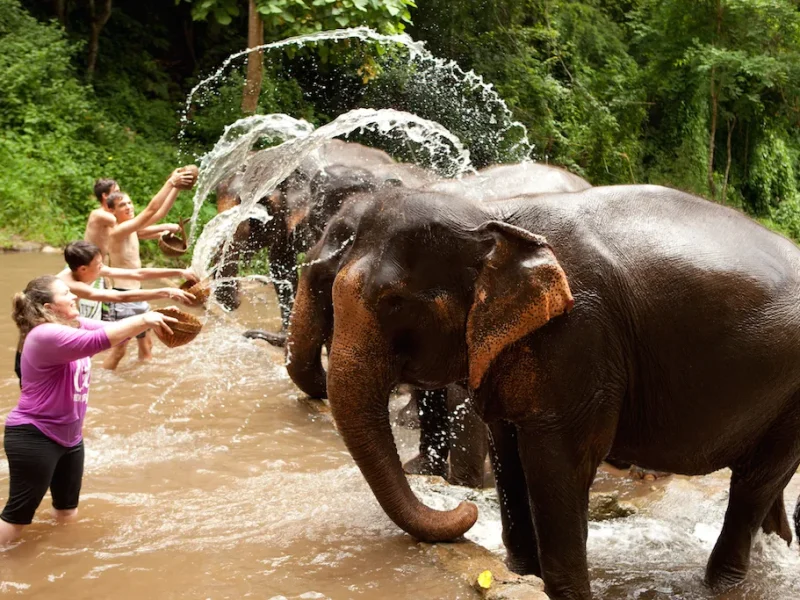
Exploring the Top 6 Elephant Sanctuaries in Chiang Mai
Leave a reply cancel reply.
Your email address will not be published. Required fields are marked *
Save my name, email, and website in this browser for the next time I comment.
- Search Please fill out this field.
- Manage Your Subscription
- Give a Gift Subscription
- Sweepstakes
- Travel Tips
Thailand's Famed Elephant Tourism Is Controversial — Here's How to Pick an Ethical Sanctuary
There are roughly 3,800 captive elephants in Thailand.
nong2/Getty Images
In Thailand , it’s very easy to encounter an elephant. Some sites allow quiet observation, as you admire the massive animals from afar. Other tourist venues offer activities like feeding, riding, or bathing with elephants. Many places toss around the term “ethical” when describing the encounters, but they often are not the sanctuaries they promote.
“Visiting an animal sanctuary while traveling can be a great way to support local animal welfare and conservation efforts, but you need to do your homework because there are many bogus sanctuaries operating that can lure in well-meaning and unsuspecting tourists,” Wendy Higgins, director of international media for Humane Society International , told Travel + Leisure .
An immediate red flag is if visitors can participate in any hands-on interactions with elephants such as playing with babies or taking elephant rides. Another warning sign is if the elephants perform in shows or demonstrations, like painting, Higgins said. “These are entirely unnatural displays for which the elephants will be forced to train, and there is no welfare benefit to the elephant whatsoever. A true sanctuary will never encourage or force any animal to interact with people, especially tourists.”
Westend61/Getty Images
Elephant tourism has been an important part of Thailand’s economy for five decades. There are about 4,000 wild elephants in Thailand, reports the World Wildlife Fund (WWF) with an additional 3,800 elephants in captivity . The country is home to three-quarters of the captive elephants in Asia with a 70 percent increase in just a decade, according to a 2020 report from the non-profit World Animal Protection . Of the venues studied across Asia, the report found that 63 percent of elephants live in dire conditions at 208 locations and only 7 percent of elephants were kept in “high welfare” venues.
“When travelers visit Asia, particularly places like Thailand, they are focused on captive elephants because of opportunities to interact with them,” Nilanga Jayasinghe, a wildlife conservation manager at WWF, told T+L. “However, it's important to remember that there are also wild elephants in these places, and they are facing significant conservation challenges. There is direct value in keeping these elephants wild, living as elephants should live.”
Asian elephants are classified as endangered with their numbers decreasing by the International Union for Conservation of Nature (IUC) Red List , which tracks the conservation status and extinction risk of species. They have been threatened by conflict with humans, poaching, and illegal elephant trade. The main threat is habitat loss and fragmentation — where parts of their habitat are destroyed, leaving smaller, disconnected areas. “They live on the most populous continent on the planet alongside a burgeoning human population, so habitat loss is a significant threat,” said Jayasinghe.
Wendy Higgins
Unethical elephant facilities attract tourists because people love elephants and are delighted at the possibility of getting up close and personal. What they won't necessarily know is that the elephants are not willing participants in that encounter, and can suffer greatly for the tourist trade.
In Thailand, captive elephants are classified as "beasts of burden" with few welfare protections. Thailand’s Cruelty Prevention and Welfare of Animals Act of 2014 was enacted to prevent animal cruelty and promote welfare but, until recently, there was little enforcement and little motivation to improve conditions.
Now, the livestock ministry, which has jurisdiction over captive elephants, is working to develop welfare standards and legal penalties to enforce the law, reports the Asian Elephant Specialist Group , a global network of specialists studying and monitoring the conservation of Asian elephants. And a Thailand-based independent welfare organization is performing welfare audits of tourist camps.
How to Tell if a Sanctuary Is Ethical
“As a general rule, a true sanctuary will allow you to look but not touch the elephants,” said Higgins. “A sanctuary will allow you to see elephants just being elephants in as near a wild setting as possible, and the tourist is a mere observer.”
Another pro-tip: research what is offered at an elephant tourist location and look at photos before visiting. These are some telltale signs that sanctuaries are not ethical:
- Elephants are restrained, particularly chained by the foot.
- Workers carry bullhooks. These are long poles with sharp hooks on the ends that have been used to control elephants.
- The location offers elephant rides, elephant painting, or other interactive experiences, like feeding the elephants.
- They engage in captive breeding to always have baby elephants on hand for tourists to pet or feed.
“Unethical elephant facilities attract tourists because people love elephants and are delighted at the possibility of getting up close and personal. What they won't necessarily know is that the elephants are not willing participants in that encounter, and can suffer greatly for the tourist trade,” said Higgins.
“Visiting these establishments perpetuates a cycle of animal suffering in which the animals experience boredom, frustration, and even physical pain or fear. These places can also pose a danger to the human visitors in some cases because elephants are very large powerful animals whose behavior can be unpredictable in an overcrowded or stressful situation.”
If you choose to visit a genuine elephant sanctuary, look for ones that give back to practical and local conservation efforts, Higgins suggested. “By supporting those sanctuaries that are doing things right, and promoting your visit on social media with a reminder that you chose it for its ethical practices, it's a great way to encourage other travelers to do the right thing too.”
The WWF suggested visiting places like Kui Buri, Khao Yai, or Kaeng Krachan national parks where you can see elephants in the wild.
“It’s a much more enriching experience to go see them in the wild if you are visiting a country like Thailand, where you can experience them in all their majesty,” said WWF’s Jayasinghe. “You don’t have to touch or bathe an elephant to experience how amazing they are.”
Visiting the Elephant Nature Park in Chiang Mai
The Elephant Nature Park in Chiang Mai is one of the most memorable experiences in Thailand ! It’s the only place in the country where you can see elephants without causing them harm. Sadly, wildlife tourism remains a massive part of the standard backpacker trip, with most being unethical and even cruel. This vast nature reserve, however, truly provides a haven for rescued elephants, allowing them to live peacefully and healthily as they would in the wild. Watch as the majestic creatures move across the grounds or see how they cool off at their favorite bathing spot.
- Entrance Tickets
- Things to do
- Tips for visiting
- The Park’s Story
- Where to stay
- Best time to visit
The Story of Chiang Mai’s Elephant Nature Park
The Elephant Nature Park is an incredible project set in Northern Thailand , only 65 kilometers from the city of Chiang Mai . Since the 1990s, it has provided a sanctuary and haven for elephants and many other rescued animals from all over Thailand.
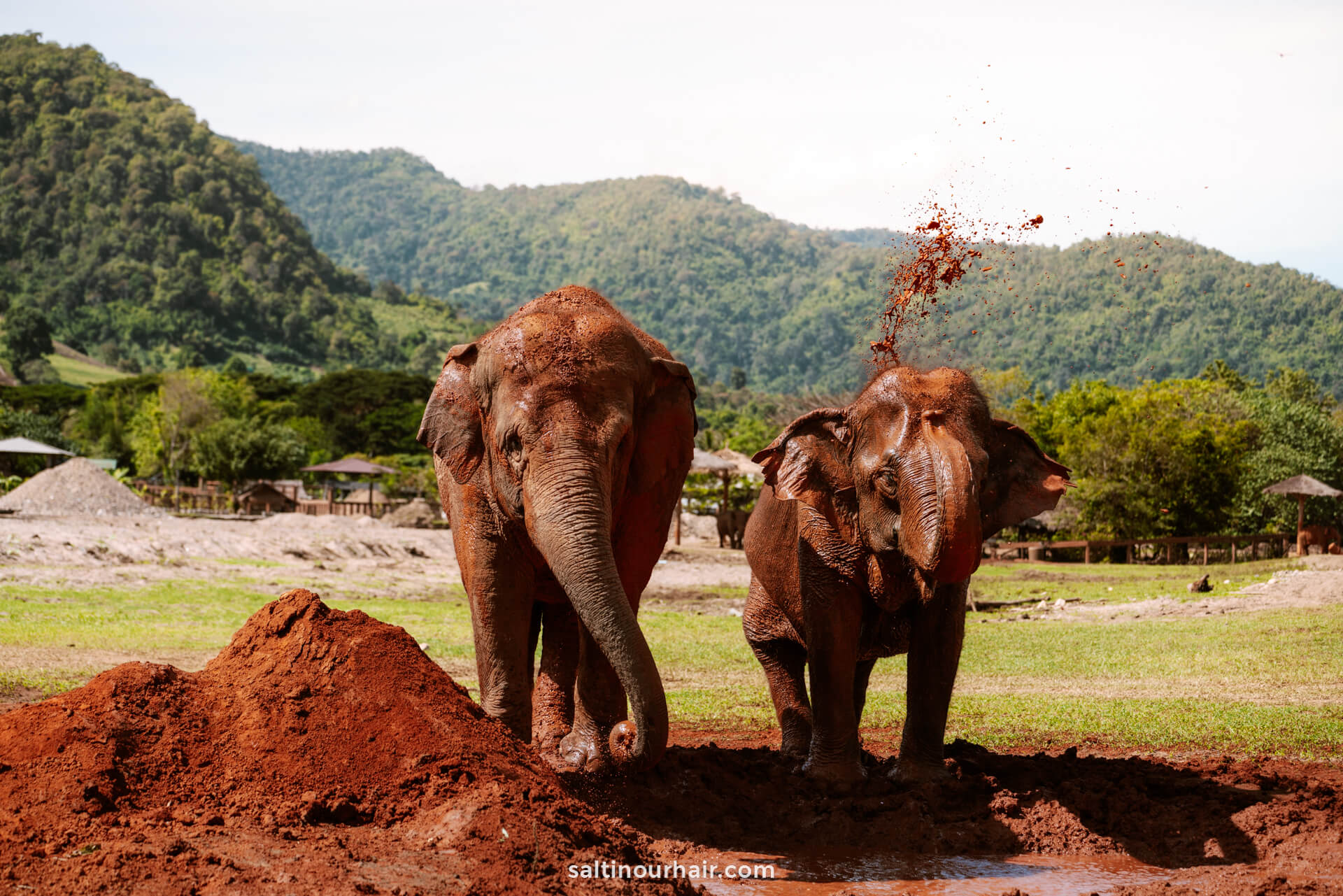
It’s the only place to experience elephants in the country (or another sanctuary recommended by the park’s staff) that operates ethically and responsibly and has the peace and well-being of the animals in mind. The sanctuary does fantastic work for the animals, allowing them to live happily, healthily, and with minimal interaction.
Here are all your hotel options in Chiang Mai.
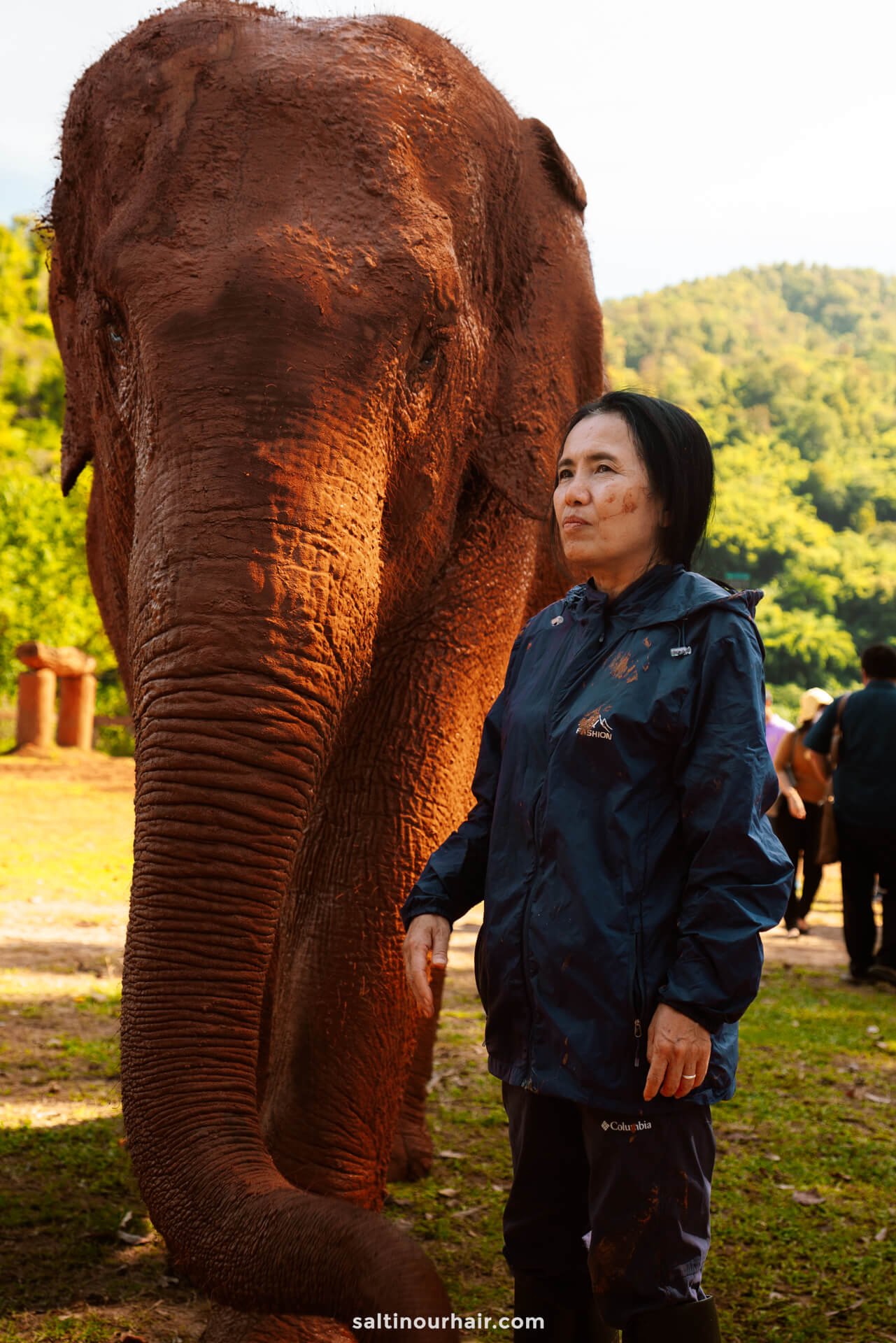
Sadly, wildlife tourism is a massive part of the standard backpacker trip in Thailand, with most being unethical and even cruel. Many of the elephants in this nature reserve have been saved from the tourism industry, tree logging, circuses, and poaching. Besides taking them in, the owner, Lek, and her team do a lot of work raising awareness of the mistreatment of elephants in Thailand .
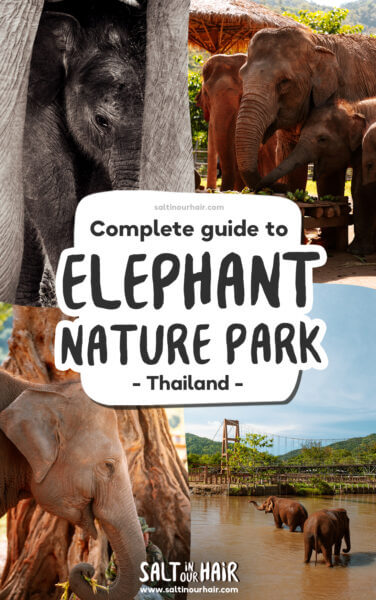
The wildlife reserve is a sanctuary for those who can’t speak for themselves, home to 114 elephants, 670 dogs, and 2000 cats, as well as cows, buffalo, rabbits, and more. Watch how the majestic creatures interact with one another, just as they would in the wild. The Elephant Nature Park is the perfect place to admire how beautiful wild animals actually are.
Book your visit to the Elephant Nature Park here
Did you know? Thailand even has its own day to celebrate the elephant. Since 1998, March 13th is the Thai National Elephant Day.

How to Visit Elephant Nature Park
If you’ve booked a trip to Elephant Nature Park, pick-up and drop-off are included in your ticket. Early in the morning, you’ll be picked up outside your accommodation in Chiang Mai and brought to the nature reserve for the day.
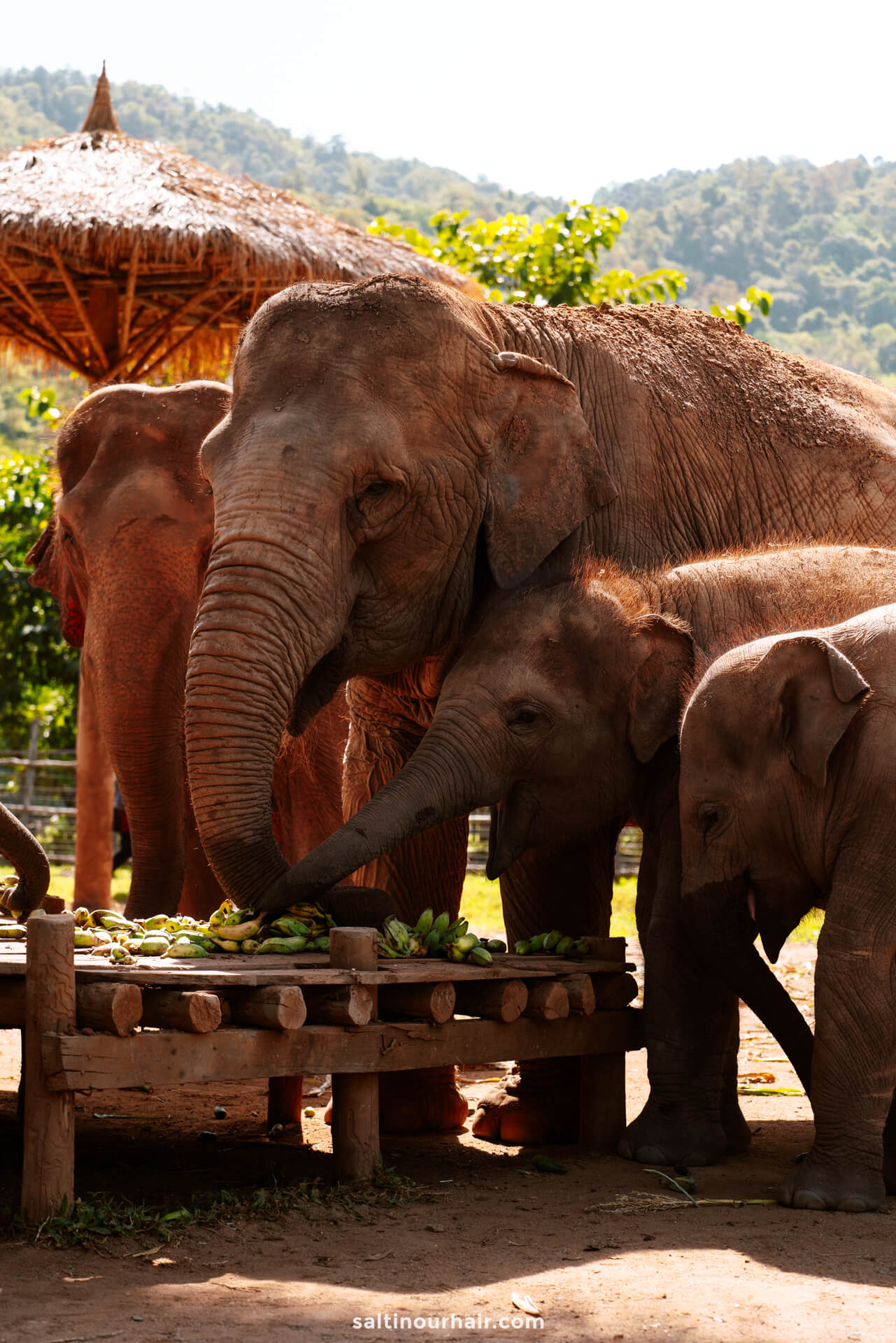
The comfortable minibus takes 60 – 90 minutes to get to the park, allowing you to get to know the rest of your tour group. After a quick stop for coffee, you’ll be at the sanctuary in no time. At the end of your experience, no matter how long (day trip, overnight, or week volunteering), you’ll be brought back to the city.
Tip: Planning on visiting an elephant sanctuary somewhere else too? Check with the park guides where else in Thailand you can find an elephant sanctuary that provides ethical care for the animals. The Elephant Nature Park in Chiang Mai is the best one to visit in Thailand.
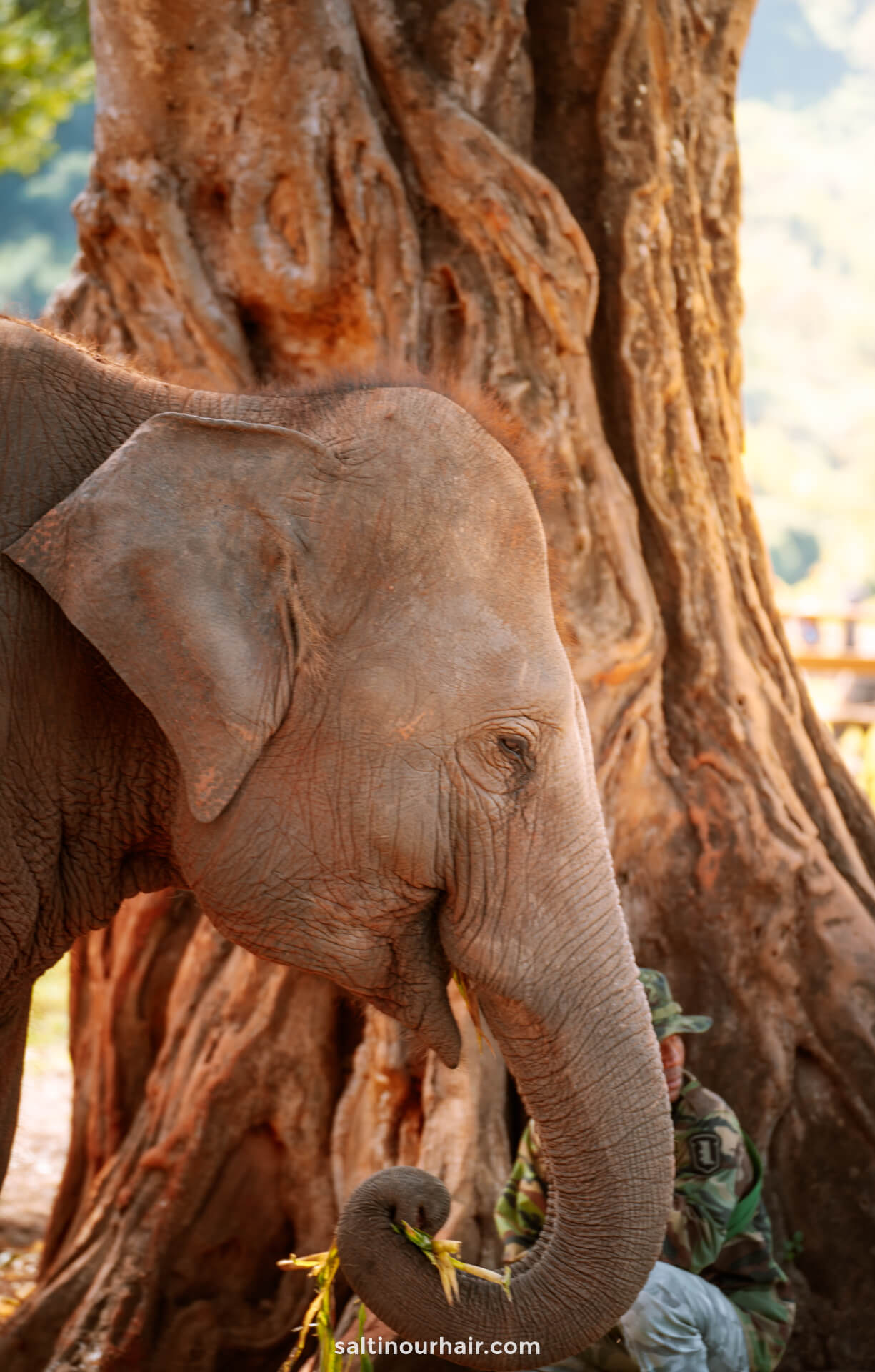
Things to do in the Elephant Nature Park
Seeing elephants up close as they roam across their camp or bathe in the river is an incredible experience. While you observe the herd, take your time to relax and learn about the elephants. Throughout, you’ll get a better understanding of the sanctuary’s purpose.
There are a few things you can do at the nature reserve, depending on how much time you’d like to spend amongst the animals and mountains. Visit for the day, overnight, or even volunteer for seven days!
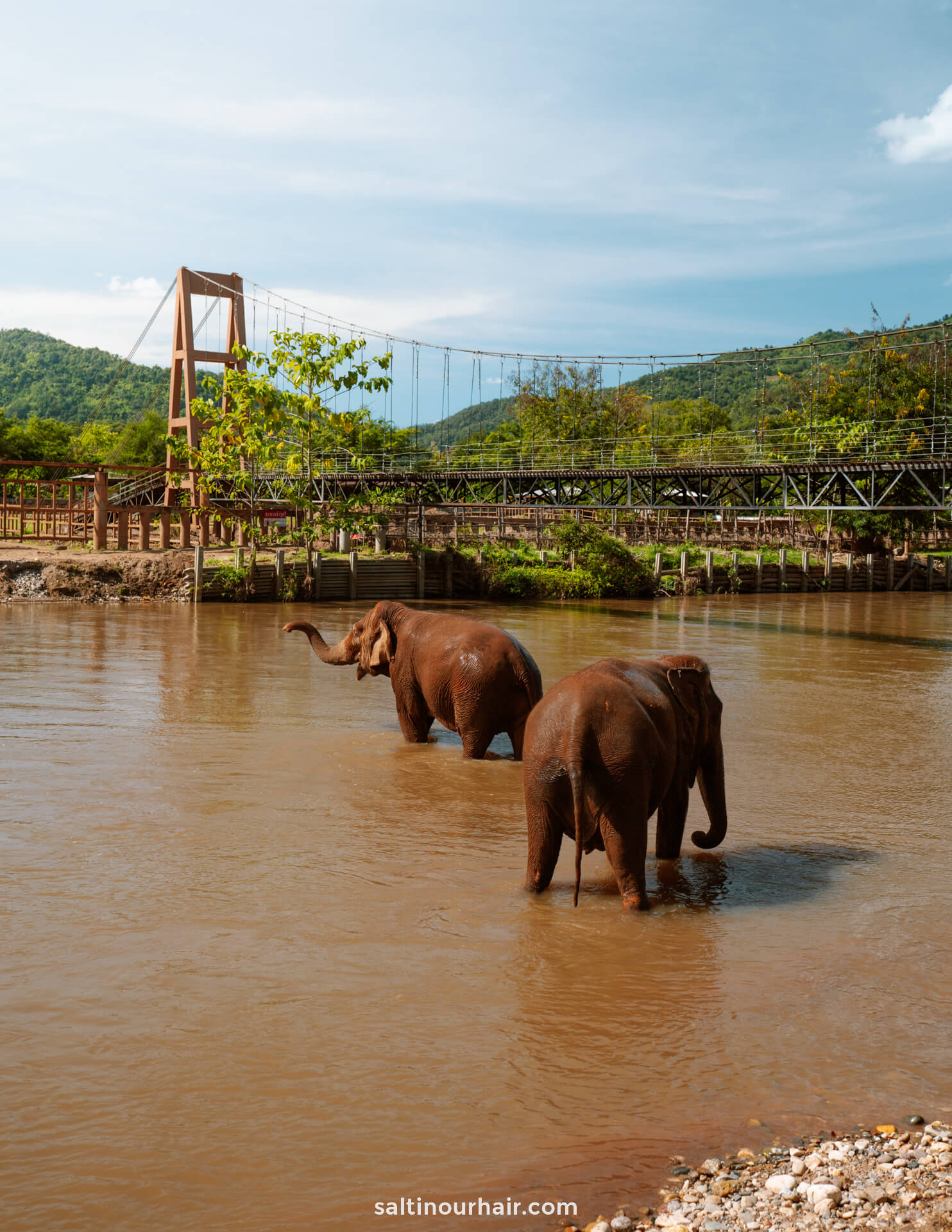
Visit on a Day Trip
On a day trip, you’ll walk through the park with a guide. The elephants walk around too, and you might even have to step aside as they don’t stop for you. You’ll spend your time learning about their daily routine, watching them bathe and cover their skin in mud (as sunscreen).
Watch as the gentle giants splash around and play while you stay dry on the river bank (bathing elephants is not an option). Or, walk across an elevated boardwalk, looking out over the reserve grounds and seeing the elephants from above.
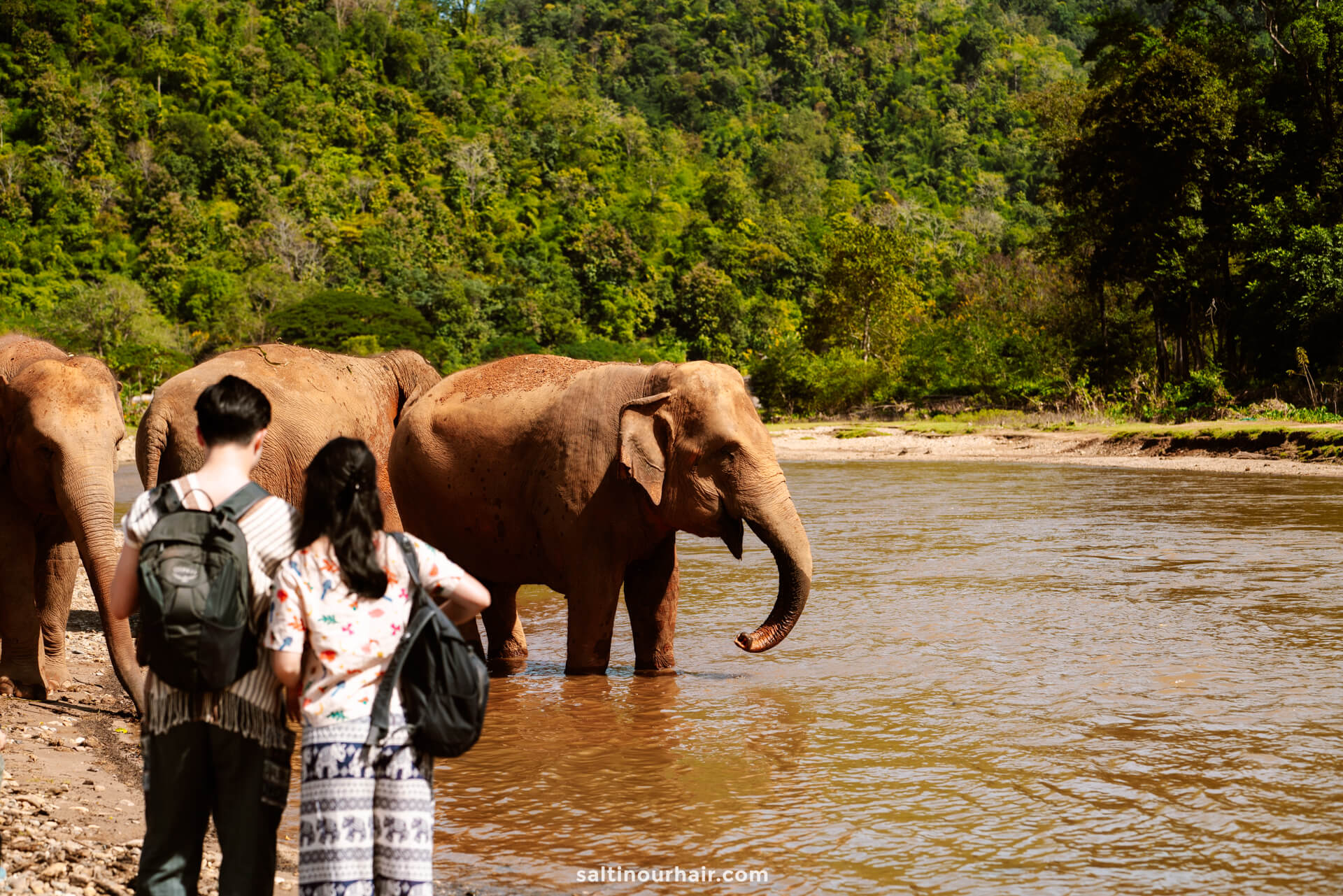
Every elephant has their own mahout (trainer), whom they’ve been with for a long time. As you meet the herd, made up of 2 to 100-year-old elephants, you’ll witness this trustful bond between the elephant and its caretaker.
A day visit is for a full day (07.30 AM – 5.30 PM or later), and a delicious vegetarian lunch with a selection of Thai and Western dishes are included in the price. Make sure to book ahead, as this experience sells out quickly, particularly at peak times.
Sleepover in a Lodge
Fall asleep in the midst of thriving elephant herds and the lush northern mountains of Thailand. After a day of meeting the elephants and learning about the beautiful conservation work that’s being done, you can wind down at the park.
Overnight guests stay in private huts with mosquito nets, bedding, and an attached bathroom. Enjoy the simple rustic nature while the sun sets over the mountains, and get a better glimpse at what happens at night in the sanctuary.

Volunteer at Elephant Nature Park in Chiang Mai
If you wish to contribute to the incredible work that’s being done at the reserve, you can sign up to volunteer for a week. During this time, you’ll help take care of this endangered species and many other animals in the park. From preparing food and harvesting crops to creating mud pits or cleaning the shelters, there’s a lot to do!
Also read: Best Places to Visit in Thailand
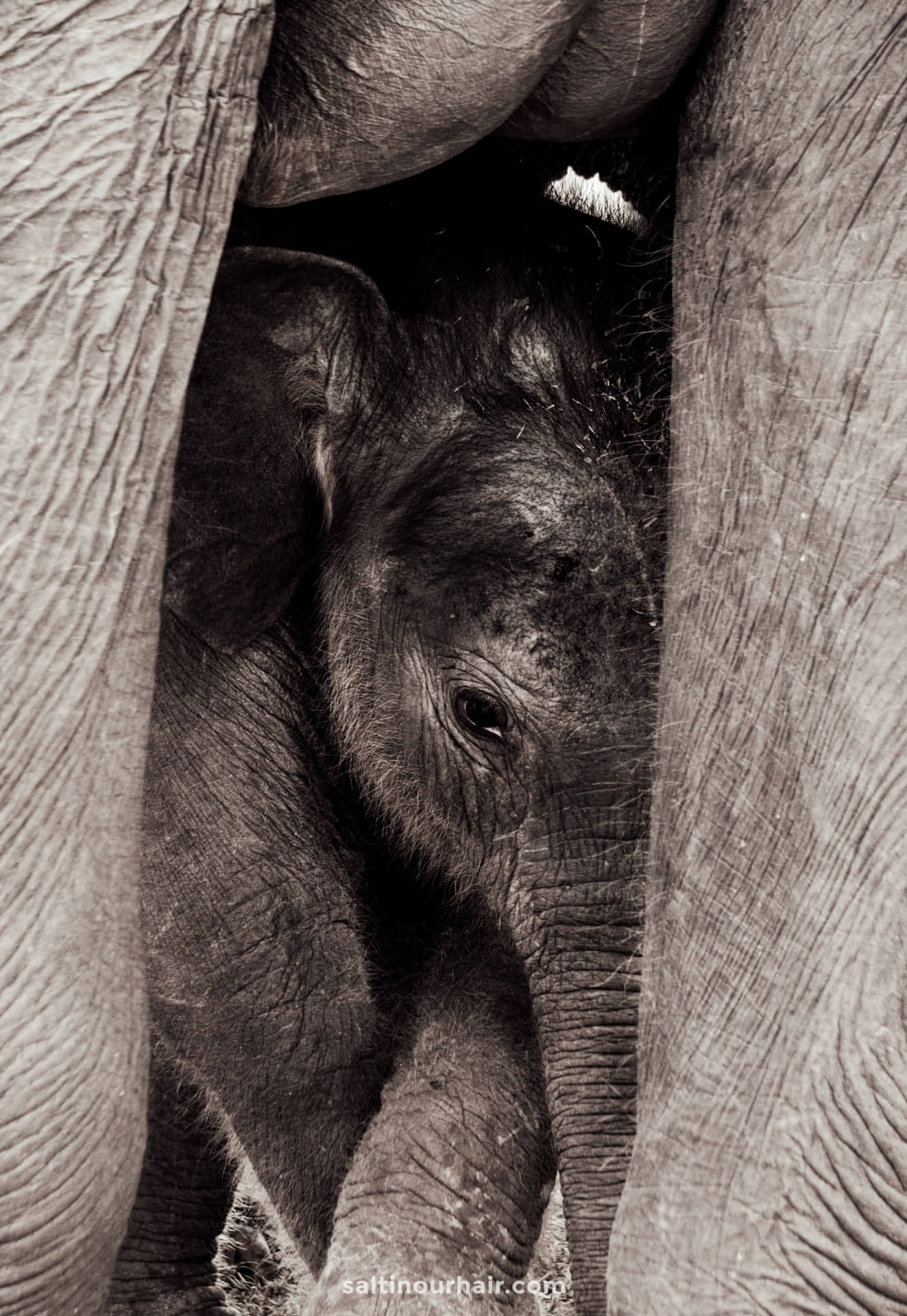
Volunteering is a fantastic experience abroad and the perfect opportunity to do hands-on work in a unique program that helps protect Asian elephants. Meals and accommodation are included, as well as WiFi. There are several different packages that you can choose from on the Elephant Nature Park website .
Did you know? An average elephant needs around 200-300 kg of food and over 100 liters of water daily! This makes work at the sanctuary incredibly important, including help from the volunteers.
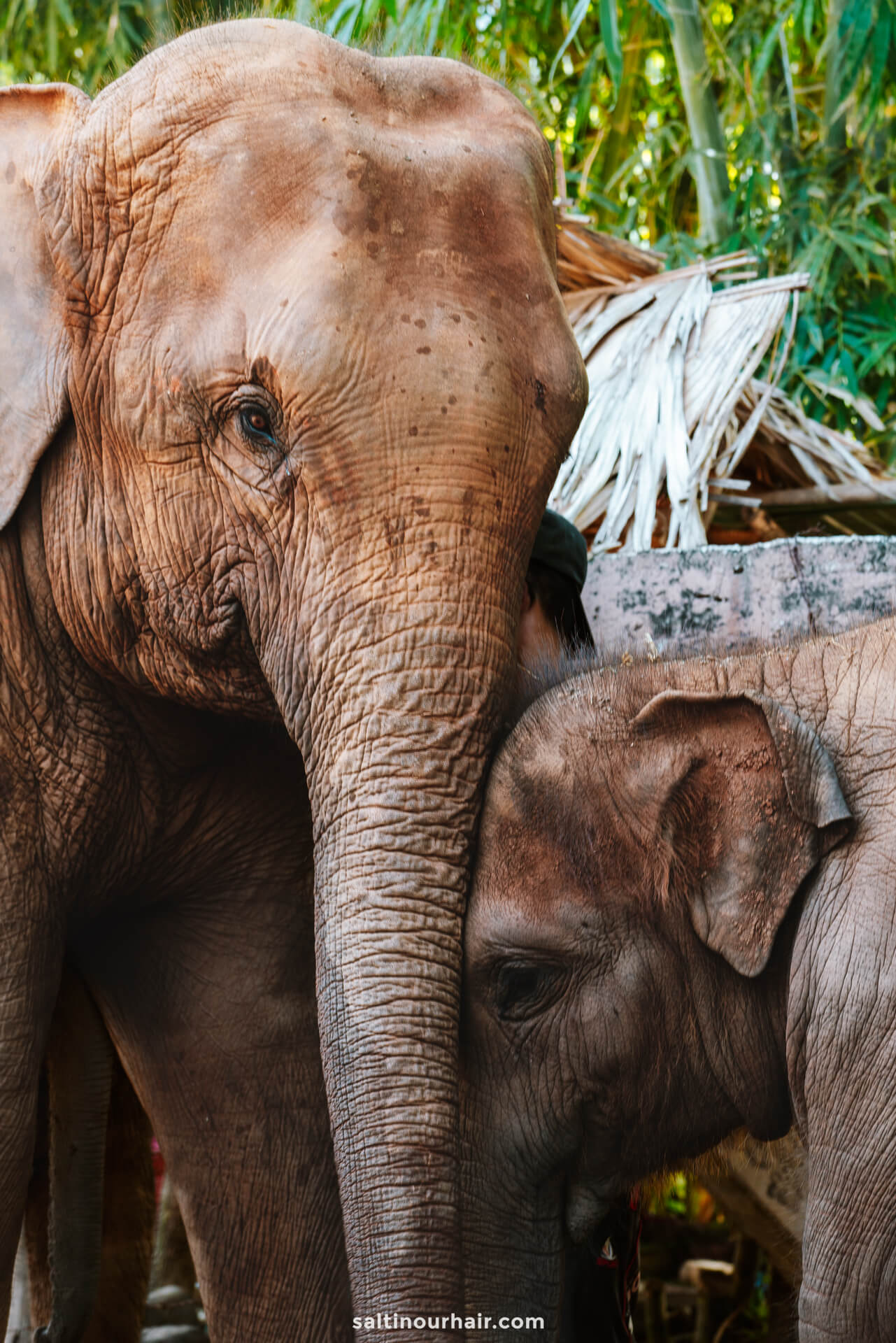

Tips for Visiting Chiang Mai Elephant Nature Park
Visiting the sanctuary is one of the most memorable things to do in Thailand. Here are some tips to make your trip to the elephant nature park unforgettable:
- Respect the elephants and follow the park’s rules for interacting with them. Elephant Nature Park’s animals roam freely, meaning you’ll have to keep an eye on them as you’re in their habitat.
- Wear comfortable clothes and good shoes (no slippers) that you don’t mind getting dirty. Prepare to be walking around a lot in slightly humid temperatures. Make sure also to bring your reef-safe sunscreen , bug repellent, a hat, and plenty of water to stay hydrated.
- If you want to snap a few photos to remember this incredible experience, make sure to be mindful of the animals. Turn off your flash, and don’t make any loud noises.
- Plan ahead by booking in advance. The park can be busy, and tickets are known to sell out pretty quickly.
- Consider staying overnight at the park’s lodge to experience the elephants and the beautiful surroundings fully. Take your time to learn more about the park’s mission as it promotes ethical wildlife tourism and conservation efforts.
- The park is in a hilly area, meaning you’ll also travel and walk there. Prepare for some steep uphill areas!
- Tip your park guides – the guides do an amazing job here, providing you with lots of information. They help out with taking tons of pictures and videos for you too!
Also read: The best things to do in Phuket, Thailand
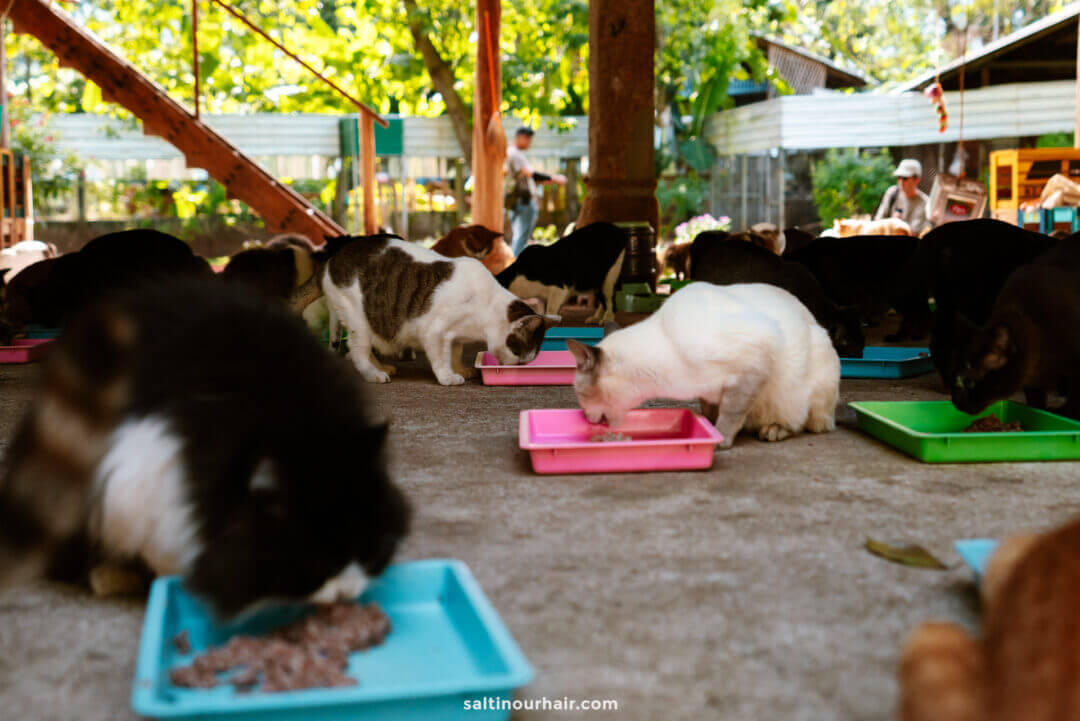
Hotels near the Elephant Nature Park
The Elephant Nature Park lies in the mountainous North of Thailand , roughly 65 kilometers from Chiang Mai. If you plan on visiting the sanctuary on a day tour, the park will arrange to pick you up from your hotel in the city.
Hotels in Chiang Mai 😴

In Chiang Mai, there are many incredible accommodation options for every budget, from backpacker hostels and mid-range guesthouses to luxury apartments. The Old Town is the best location as it’s where you’ll find most hotels, all within walking distance from the top sights and temples in the city.
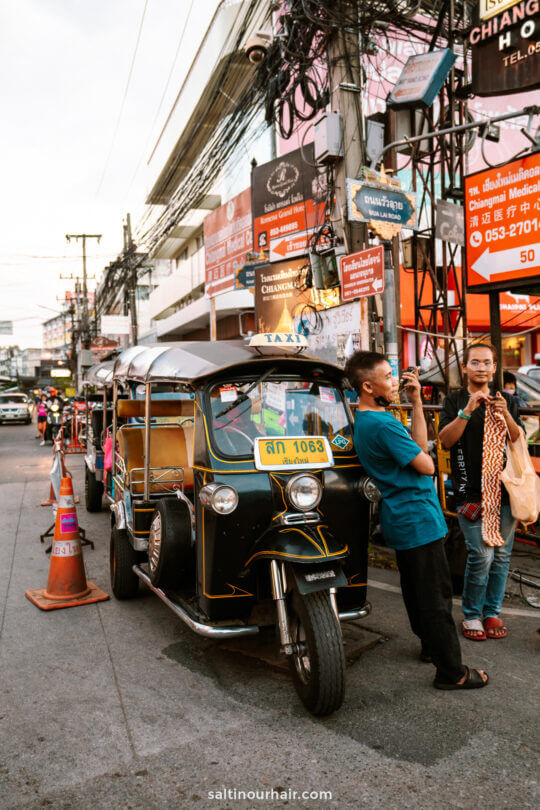
Wildlife Tourism
Seeing wildlife up close is an incredibly special travel experience and one of the highlights of a trip abroad. However, it should always be ethically done, with the animals’ well-being in mind. Visit wild animals in their natural environment and treat them with respect, not as something for entertainment.
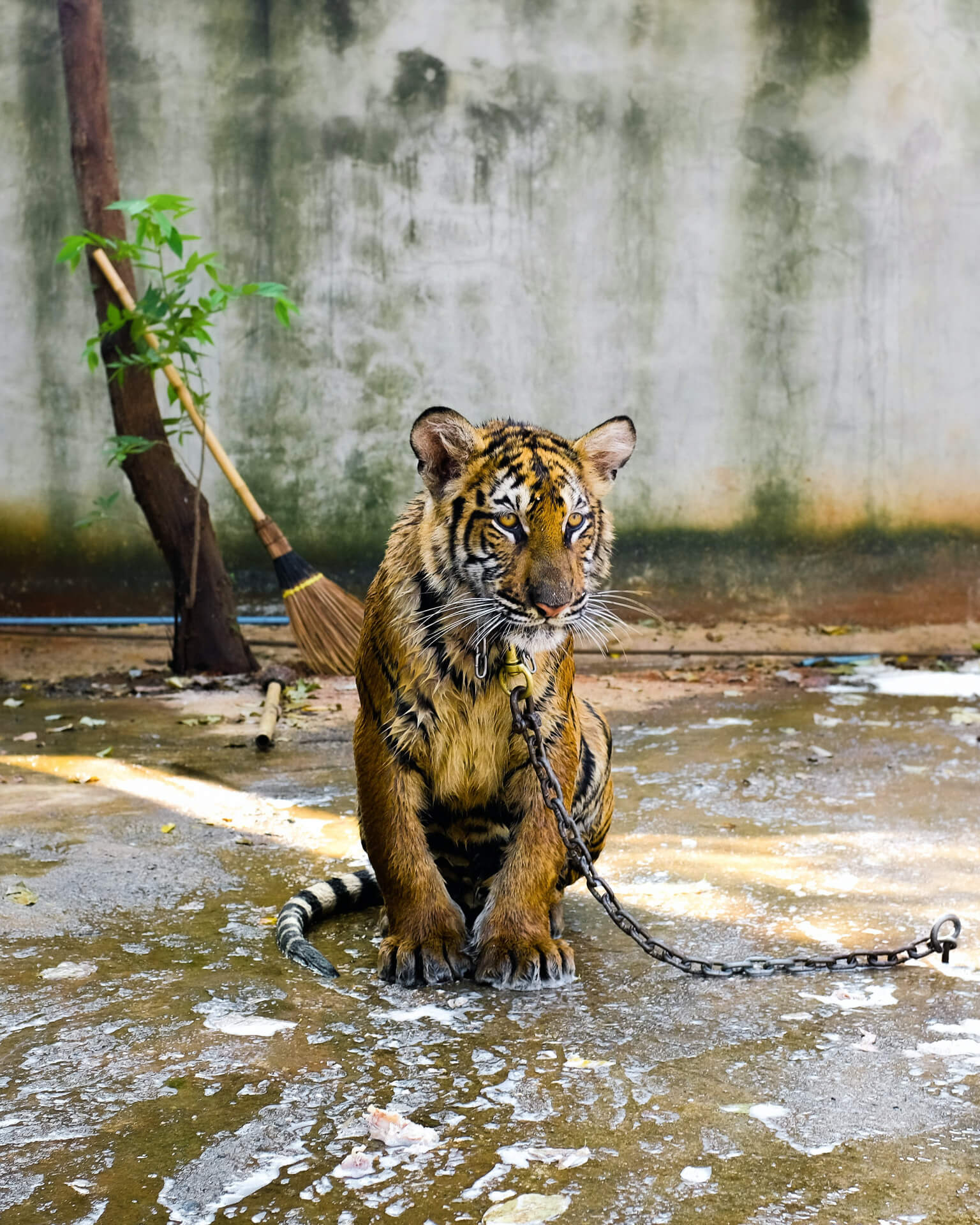
Unfortunately, many wildlife experiences mistreat animals and leave them in cruel conditions. Thailand, in particular, is a popular spot for negative forms of wildlife tourism, such as tiger selfies and elephant rides. Always remember that: the less money we put into funding this kind of tourism, the more likely it will come to an end.
Though it can be difficult to find ethical sanctuaries, there are databases you can check. Elephant Nature Park is a legitimate rescue center that takes care of injured and orphaned animals. They promote the importance of responsible tourism and ethical animal care.
Read more about wildlife tourism + the better alternatives
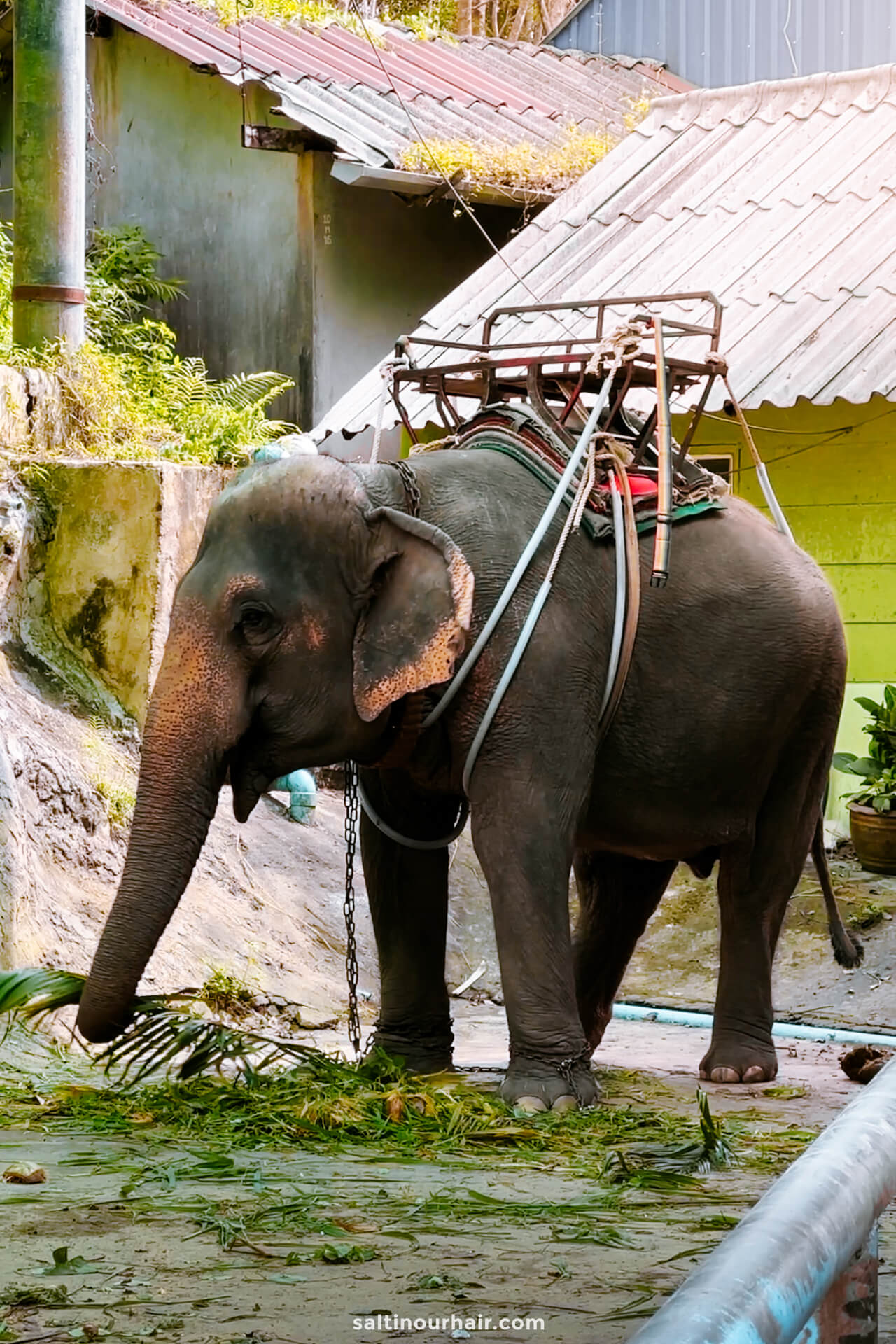
What to Pack for the Elephant Nature Park?
Depending on how long you plan to visit the Elephant Nature Park in Chiang Mai, prepare to bring a few items with you. Here are some necessary things to pack when you visit the reserve:
Packing List
- Sunscreen and a hat – protect yourself from the sun throughout the day. Read about alternative sunscreens here .
- Comfortable clothes and shoes – opt for loose-fitting clothing and good walking shoes as you’ll be outdoors most of the time.
- Bug repellent – if you’re not wearing long sleeves or pants, bring insect repellent. Get a non-toxic product so it doesn’t harm nature or animals.
- A change of clothes – during jungle walks with the elephants, your clothes and shoes might get very muddy, so having a spare set is good.
- Water and snacks – though you’ll have lunch at the sanctuary, bring some water to stay hydrated.
- Your camera – to memorize this incredible experience. Make sure to have the flash (and sound) off when photographing the animals.
- Cash – to pay your admission fee, tip your park guides, and maybe get a souvenir.
- Refillable water bottle – you can fill up your water bottle at the park.
- Rain jacket – if you’re visiting during the wet season of April to October.

If you’re staying longer than a day, make sure to pack:
- Layers – Layers of clothing are essential to add or remove items when the temperature changes.
- Microfiber Towel – extremely useful to take microfiber towels as they dry much faster and are incredibly lightweight.
- Flip-flops – to use at the showers or walk around the lodge.
- Long socks & trousers – For some hikes, night walks, or evenings outside, you might also want to take long socks and trousers to cover your legs and prevent being bitten by mosquitos.
- Power bank – having a power bank to recharge your phone is helpful. ( Get one here )
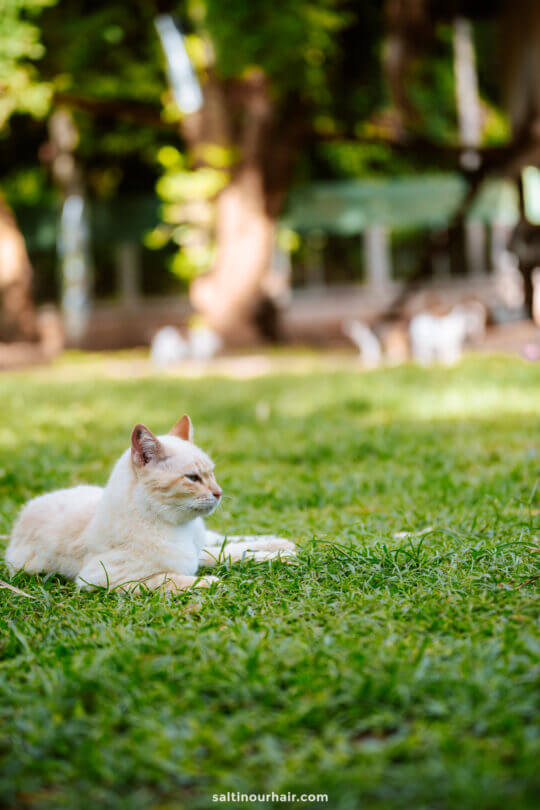
Best Time to Visit the Elephant Nature Park, Thailand
Though there’s no bad time to visit the Elephant Nature Park as the park’s open year-round, your visit may depend on the weather. The climate in Thailand varies throughout the country, but the best months to visit are October – November. This is the end of the rainy season which provides a cooler environment, especially in the mountainous North.
However, seeing the elephants walk together across the grounds is a magical experience, even with some rain.
Tip: this is a popular activity to do in Chiang Mai, so it’s good to book ahead!
By purchasing through our links, you support us at no additional cost. Thank you for your support. ♥️
- Find Hotels via Booking.com
- Find a Rental Car via Sunny Cars
- Find Flights to Thailand via Skyscanner
- Get a Travel Insurance via Heymondo
- Book Tours & Attractions via GetYourGuide
- Book a Bus/Train/Transfer via 12Go
Tiger Cave Temple in Krabi: The Ultimate Guide (Thailand)
8 best things to do in krabi, thailand, 13 best things to do in bangkok.
Looking for more travel information? Plan a chat with us for personalised travel advice or get an answer from the Salt in our Hair Travel Community on Facebook.
Your email address will not be published. Required fields are marked *
Notify me when new comments are added.
- Philippines
- New Zealand
- Netherlands
- United Kingdom

Thailand is home to some magnificent residences, and we’re not just talking about the welcoming locals. The “Land of Smiles” also happens to be the land of breathtaking wildlife, from its lush rainforests to its tropical beaches and, of course, majestic creatures.
The Asian Elephant is a symbol of Thailand and is thought to bring good fortune. But these superstitions haven’t prevented the domestication of wild elephants and their employment in abusive industries. Logging was banned in the 1980s, but unfortunately, most captive elephants ended up in the tourism trade, with less than 2,000 left in the wild.
Thailand currently enforces no laws that prevent the abuse and use of elephants in tourism. Still, the ethical sanctuaries in our guide are doing their bit to rehabilitate mistreated elephants, and you can, too. Check out these seven places to find out where to see elephants in Thailand sustainably.
Table of Contents
The Elephant Nature Park, Chiang Mai
Although not to be confused with the word “Chang,” actually meaning “elephant” in Thai, Chiang Mai is widely regarded as one of the best places to see elephants in Thailand. The Elephant Nature Park is the best-known conservation project in the area and prides itself on a track record of ethics and sustainability.
Find A Travel Buddy!
The refuge is home to 75 free-roaming elephants, each with its own heart-wrenching rescue story, which only makes the Elephant Nature Park’s work more commendable. Most elephants have been saved from exploitative tourism, such as abusive training camps or logging work.
There are also dogs, cats, horses, and water buffalo, among the other animals that have been rescued by leading conservationist Sangduen “Lek” Chailert, who founded the sanctuary in 1995. Set on the edge of dense rainforest in the northern capital, the forgiving climate and lush grounds make the park a dreamy refuge for these once-abused creatures. But it’s equally enjoyable for volunteers who can visit for the day or arrange longer overnight trips to muck in, prepare food, clean, and nurture the elephants.
The Surin Project, Baan Tha Klang
The Surin Project recognized one of the main problems around elephant abuse in Thailand to be poverty. It’s easy to demonize mahouts, the traditional trainers who work, ride and manipulate elephants for tourism and other purposes. But most of them are offered no alternative when it comes to making a living, forced to turn to their family businesses or the lucrative tourism trade for income.
Nestled in Baan Tha Klang in northeastern Thailand, The Surin Project works directly with mahouts, offering refuge to trainers and their elephants to keep them off the streets and interrupt unethical tourism.
There are near 200 mahouts and elephants living at the center, and the unique non-profit employs mahouts to tend to the land and the animals who roam free in the forested park. The sanctuary promotes sustainable tourism, and volunteers are essential to the project. Visitors can stay for a minimum of one week, and their donations go to the salaries of the mahouts and the care of the elephants.
Burm and Emily’s Elephant Sanctuary, Maechaem
Local Thai, Burm, and his English wife Emily started BEES in 2012 to bring Thai elephants owners onboard with a more ethical approach to animal tourism. They pride themselves on being at the forefront of welfare, and their approach to ethical tourism is all about putting the elephants’ needs first.
BEES is a home for old, injured, and retired elephants who’ve endured years of logging, tourist trekking, and abuse. Two hours southwest of Chiang Mai, the dense green valley and rolling mountains are the perfect setting for these gentle giants to live out their final years. It’s no surprise they have an outstanding record and five-star rating, the highest in this guide.
Their volunteer program takes a more hands-off approach, with activities limited to active care of the animals like preparing their afternoon snacks and cleaning their areas. There’s also an onsite cat café whose residents need caring for. BEES is fully immersed in the local community, and volunteers can also partake in village conservation work like tree planting and building repairs.
Friends of the Asian Elephant Hospital
Friends of the Asian Elephants Hospital (or FAE) is one of the world’s only elephant hospitals and a truly unique experience for visitors to Thailand. Located in the northwest, FAE’s mobile vet clinic is crucial to treating and rehabilitating elephants all over Thailand. These professionals care for injured, disabled, and vulnerable elephants while welcoming volunteers to do the same.
Their visitor program introduces you to veterinarians who give their lives to caring for nature’s majestic giants. They’ll also show you how they treat injured elephants, how to prepare food for them, and clean their areas.
Since its inception in 1993, the hospital has treated over 5,000 elephants. But they rely solely on donations and need volunteers to ensure they can keep tending to sick ellies.
Elephant Haven
The Sai Yoke Elephant Camp, newly-named Elephant Haven, is a fascinating elephant project in Kanchanaburi, west Thailand, and a leading example in elephant tourism reform. The sanctuary’s name change came about with its dynamic switch in intention. Once a tourist trekking camp that chained elephants, Elephant Haven is now home to roaming elephants who are free to socialize, bathe in mud, cool off in the river Kwai, and live out their years in peace.
Elephant Haven is among a handful of elephant experiences making changes in line with the groundbreaking work of the Elephant Nature Park in Chiang Mai. The former camp invites visitors to walk with elephants through the jungle rather than on their back and prepare fresh fruit and millet balls for them to enjoy along the way.
You’ll also find cats, dogs, birds, goats, and buffalos among the rescues here, and volunteers can visit for the day or as long as a week to help out with care for all the animals.
Samui Elephant Sanctuary
Samui Elephant Sanctuary is the island’s first refuge for mistreated and overworked elephants. A dozen elephants live peacefully on the 10 acres of forest land, and visitors can feed and walk with the elephants and even play with them in their mud pit and custom pool.
Thanks to the help of Lek Chailert, Save The Elephants , and volunteers, Samui Elephant Sanctuary has recently opened a second location with the hopes of extending its conservation work to all areas of the touristy island. Both sanctuaries also allow outsiders to sponsor an elephant, receive updates on their retirement, and donate towards their elephant’s care.
Wildlife Friends Foundation
Three hours from Bangkok, nestled between the Gulf of Thailand of the Myanmar border, is Phetchaburi, home to the dense rainforest of the Kaeng Krachan National Park and the Wildlife Friends Foundation.
Big cats, bears, primates, deer, and birds can all be found here, rescued from abuse and sheltering the exploitive animal trade. Among the 600-plus residents, just over 20 elephants call the sanctuary their home.
The Wildlife Friends Foundation rehabilitates and releases around 40 percent of their rescues back into the wild in protected conservation areas. But the elephants are not part of this demographic. Coming from trekking camps, the retired animals are too reliant on humans to survive without their care. Luckily, the Wildlife Friends Foundation is willing to provide it for them.
Volunteers can embark on a half or full-day experience, cleaning enclosures for all the animals, building enrichments, harvesting banana trees, and observing animals in their natural habitats.
Are there still wild elephants in Thailand?
There are around 3,000 to 4,000 elephants left in Thailand, with half of these roaming freely in grasslands and jungles of the National Parks Reserves. Some 100,000 elephants lived in the former Kingdom of Siam a century ago. These numbers have been dissipated by years of torturous logging practices and elephant tourism. Despite conservation efforts, elephants can be hard to rehabilitate, primarily if they’ve been bred in captivity because their reliance on humans lasts for life.
Still, Kuiburi is one of the only remaining regions in the country where you can still observe elephants in the wild. With a population of around 230 freely roaming in the thin forests and open fields, they keep their distance from daily visitors but are easy to spot.
Is it OK to ride elephants in Thailand?
Interacting with elephants has long been one of Thailand’s major tourism draws. But elephant tourism is built on the premise of ancient torture rituals that seel elephants into a fate of total reliance on humans. Domesticated elephants in Thailand have either been captured from the wild or bred in captivity to be “broken” by mahouts. Wild elephants are strong-willed and would never allow a human to ride them without the manipulation and torture enforced from a young age to break their spirit. Even without the uncomfortable-looking traditional carriages and camp’s claims to “sustainability,” riding elephants in Thailand is never OK.
Are elephant sanctuaries in Thailand ethical?
Aside from observing wild elephants from a distance, the only way to ethically interact with these creatures is at an elephant sanctuary. There are several ethical sanctuaries in Thailand, where the rehabilitation and care for animals are put before human entertainment. But, sadly, many camps pose as sanctuaries, especially since the rise of “sustainability” as a buzzword.
Organizations can promote themselves as “ethical” to draw more tourists, but visitors could unknowingly contribute to elephants’ torture. Always do your research before choosing a “sanctuary” to visit, and remember that any treatment beyond caring and petting the elephants is not in their best interest. Suppose a sanctuary advertises trekking, elephant riding, or entertainment as simple as kicking balls or painting for spectators; this clearly indicates that the refuge is not ethical.
Destinations
- North America
- South America
- Group Tours
- Cookie Policy
- Privacy Policy
- Terms & Conditions
© 2022 Journeying The Globe. All Rights Reserved.
Got a Travel Question?
Ask questions, get inspired, and plan your next adventure with us! Join our free Facebook group for travelers and connect with a global network of passionate explorers.
JOIN FOR FREE
13 ethical elephant sanctuaries in Thailand
Seeking an authentic elephant experience? Look no further than these responsible elephant sanctuaries that offer a natural and ethical way to see these incredible gentle giants...
1. Elephant Nature Park
Elephants at Elephant Nature Park (Shutterstock)
Elephant Nature Park is one of the best-known elephant conservation projects in Thailand. Set on the edge of a rainforest near Chiang Mai, in Thailand’s north, the sanctuary was founded by award-winning conservationist Lek Chailert in 1995. More than 75 elephants roam free here and each has a heart-breaking story: many have been saved from torturous camps that exploit elephants for tourism or logging purposes or other abusive situations.
The refuge is also home to a ragtag menagerie of adopted cats, dogs, horses, warthogs, water buffalo and other animals. There are a few different ways to visit Elephant Nature Park, with both single day or overnight stays available. Volunteers help prepare fruit and vegetables for the elephants and food for the other animals, or you can stay overnight to spend more time with these gorgeous creatures. Longer volunteer placements are also available here and must be booked well in advance.
2. The Surin Project
An elephant playing in the sand (Shutterstock)
One of the main issues around elephant abuse in Thailand is that the traditional trainers – mahouts – find it hard to make a living so feel forced to turn to unsustainable tourism for income. The Surin Project in Baan Tha Klang, northeast Thailand, works to reduce that problem, taking in the mahouts and their elephants to keep them off the streets.
Nearly 200 mahouts and elephants live in the centre; the mahouts are given employment and the elephants are free from chains to roam on forested land. Volunteers are essential to the project’s survival. A one-week minimum volunteering stint is required, giving you plenty of time to get to know the culture of the mahouts and this valuable work.
3. Boon Lott’s Elephant Sanctuary
Boon Lott’s Elephant Sanctuary (BLES) is a small, intimate affair in Sukhothai. The rescued elephants roam freely over 600 acres of forested land of banana plantation, grasslands, fresh-water rivers and open fields. Founded by animal-loving Brit Katherine Cooper who left a successful career in the UK, the sanctuary also features a cat and dog home on the grounds.
With just three guesthouses, visitor numbers are kept intentionally low to ensure the wellbeing and quality of life for the small herd of rescued elephants who live here. Most people stay at BLES for a handful of nights, spending their days watching elephants on the grazing grounds and taking a swim in the river, or getting to know the village mahouts. This peaceful sanctuary is in the north of Thailand, near Sukhothai Airport, and places book up quickly so reserve well in advance.
4. Friends of the Asian Elephant Hospital
See elephants ethically in Thailand (TAT)
As one of the only elephant hospitals in the world, the Friends of the Asian Elephant (FAE) Hospital is a special elephant experience in Thailand. The centre is one of very few of its kind and is located in Thailand’s northwest and is dedicated to treating and rehabilitating sick elephants. Its mobile vet clinic treats sick, weak and injured elephants all over the country.
Visitors are welcome at the hospital, and here you can learn about how these professionals take care of injured and disabled elephants and treat their injuries. Seeing the vulnerable elephants being treated is quite a leap from seeing the treatment of small domesticated animals, making this a fascinating stop-off. This donation-based hospital has treated over 5,000 elephants since 1993 and truly needs visitors and volunteers to help ensure its future. Volunteer activities include preparing food for the elephants and cleaning their areas.
5. Elephant Haven
Elephants bathing in Kanchanaburi (Shutterstock)
Formerly known as Sai Yoke Elephant Camp, the newly-named Elephant Haven in Kanchanaburi is one of the most exciting elephant projects in Thailand. The name alteration came around as this place used to be the kind that kept elephants in chains, but the camp has changed its ways. Now, the elephants here have freedom to roam and socialise, without hooks or being put on show – a giant leap for elephants in Thailand.
This is just one of a handful of camps that are making changes in conjunction with Elephant Nature Park near Chiang Mai. In this beautiful setting, you can visit just for a single day or stay overnight and wander with the elephants, walking with them through the jungle beside them, instead of on their backs. There are also one-week volunteering opportunities. Activities include helping to prepare fresh fruit and rice-and-millet ball treats for the elephants and jungle walks, along with feeding and caring for the sanctuary’s resident cats, dogs, horses, buffalos, goats, birds and many other rescued animals.
6. Burm and Emily’s Elephant Sanctuary
A mother and her calf enjoying Thailand's greenery (Shutterstock)
A place for old, injured or retired elephants, Burm and Emily’s Elephant Sanctuary (BEES) offers refuge to those elephants that have gone through years of logging or tourist trekking. The organisation is based around a two hour drive south of Chiang Mai, in a valley surrounded by dense greenery and beautiful mountains – just the kind of place where elephants should spend their golden years.
The volunteer programs at BEES run from Monday to Sunday. The sanctuary focuses on letting the elephants be, and helping out in the overall taking care of the elephants. Activities you can expect to get involved with here include preparing afternoon fruit treats and cutting grass and corn for the elephants, cleaning their areas and helping to care for other resident animals at BEES as well as the rescued cats at the onsite cat cafe. Depending on the sanctuary’s needs, you can get stuck in with a few other things here too, such as cooking classes, joining a weaving club in the local village or tree planting and conservation work.
7. Elephants World
Elephants World in Kanchanaburi provides a haven for rescued and injured elephants with plenty of space to roam and relax in a lush setting on the banks of the River Kwai. Founded in 2008 by a Thai veterinarian Dr Samart and his wife Khun Fon, the sanctuary is also a self-sustaining farm providing care for the elephants as well as work and home for 130 staff including mahouts. The refuge started with three elephants and now has 25 animals rescued from logging camps, trekking camps and city begging, operating under the heartfelt ethos: “We should work for the elephants, and the elephants not for us”. Interaction with the animals is respectfully limited. Visitors can watch the elephants foraging, bathing and socialising. You can visit them for the day, stay overnight or volunteer for a week.
8. Samui Elephant Sanctuary
An Asian elephant in Thailand's greenery (Shutterstock)
A dozen rescued elephants call these 10 acres of forest at Samui Elephant Sanctuary home. One of the first ethical sanctuaries on Koh Samui, it provides a safe haven for elephants who have previously been overworked or mistreated in the logging and tourist trekking camps. Inspired and supported by the world-renowned Elephant Nature Park in Chiang Mai, the Samui Elephant Sanctuary is the perfect place to watch happy and well-treated elephants in their natural habitats. Visitors are only allowed to walk with and observe the elephants as they forage, socialise, play in their custom-built pool and mud pit, and relish in the freedom and nurturing care they have at their sanctuary home.
9. Wildlife Friends Foundation
Wildlife Friends Foundation at Phetchaburi, about three hours away from Bangkok is not only home to elephants, but big cats, bears, primates, deer, birds and all sorts of other creatures. Wildlife Friends sanctuary and wildlife hospital rescues, rehabilitates and shelters all kinds of animals from abuse. Most of the 600-plus animals have been saved from horrible conditions or were abandoned after becoming unwanted pets. About 40% of the animals are released back into the wild in protected national parks, aside from the elephants, who came from trekking camps and can never be released because they spent too many years around humans and learned to rely on them too much.
The sanctuary offers full or half-day excursions at the elephant refuge and wildlife rescue centre to see hundreds of animals living happily in a natural environment. As an Elephant Refuge volunteer, you will help to prepare the food for over 20 elephants, clean their enclosures, create enrichments, harvest banana trees and grasses and a variety of other maintenance work around the centre.
10. Phuket Elephant Sanctuary
Phuket Elephant Sanctuary shelters sick, old and overworked elephants after decades of abuse in the tourism and logging industries. Another sister project by Save the Elephant Foundation, the sanctuary is leading the way when it comes to the ethical treatment and rehabilitation of retired and rescued elephants. Set against the picturesque jungle bordering Khao Phra Thaeo National Park, a herd of elephants, between the ages of 36 to 70, romp freely across lush pastures. Visitors can observe them from a treetop observation deck as they graze or splash in the fresh water lagoons and hydrotherapy mud pools.
11. Elephant Hills
A herd of elephants enjoying the jungle (Shutterstock)
Situated in the Khao Sok National Park, Elephant Hills is home to many elephants who have been rescued from a life of captivity who are now free to roam the vast jungle area chain-free. The park is constantly working at improving the life of the gentle giants in its care and is doing such a great job it received 100% of core criteria in an audit by Global Spirit, an independent animal welfare company in the UK.
What makes Elephant Hills so special is the chance to stay at one of the site’s two glamping camps, allowing you to fully immerse yourself in the wild natural landscapes. Spend your days kayaking, visiting local markets, trekking through mangrove forests and of course, seeing and learning about the elephants in an ethical and responsible way
12. Phang Nga Elephant Park
An elephant grazing on the grass (Shutterstock)
This small, family-run park in the Phang Nga Province on the edge of a nature reserve has been open since 2015, but elephants have been a part of this family’s life for over 150 years. Phang Nga Elephant Park prides itself on elephant welfare, constantly learning and improving to provide the best quality of life for the elephants as possible so you can be sure your visit here will be a sustainable one.
Spend your day in the thick forest where the elephants roam, watching them go about their daily routine and helping to plant food as part of the park’s conservation programme. Don’t miss a visit to the education centre to learn about the history of the Asian elephant and why elephant conservation is so important in Thailand
13. Into the Wild
A baby elephant enjoying a bath (Shutterstock)
Situated in the southern mountains of Chiang Mai, the elephants at Into the Wild are free to roam the emerald forested landscapes and splash in the water. By taking either the half day or full day programme, you can follow them on a trek through the jungle, observing the ellies in their natural environment. You will also have a chance to learn about the behaviour, history and ethics of elephant care in Thailand.
Crucially, Chiang Mai takes elephant welfare very seriously, and does not allow riding or elephant tricks. The focus is on responsible and sustainable elephant experiences, ensuring these elephants rescued from a life of logging and tourism can live out their retirement happily and peacefully. As well as giving back to the elephants, Into the Wild also does its utmost to support their neighbours, employing people from the local Karen hill tribe and supporting the local community with supplies.
Things you might like:
- Go wild! 7 wildlife hotspots in Thailand
See elephants, sun bears and big cats, as well as exotic bird and sea-life in Thailand’s jungles, mountains and oceans. Choose ethical travel companies that work with protected national parks and reserves to allow visitors to view wildlife responsibly without harming animals or their habitats. These are the best places to go where the wild things are…
- 5 alternative places in Thailand that will benefit from your post-lockdown visit
The shimmering shores of Phuket and Koh Samui may entice the lion’s share of Thailand’s sun-seekers, but away from the hordes are little-visited secrets hiding wildlife, rugged landscapes and even a floating art market. Here are 5 peaceful places for a post-lockdown visit…
- 7 experiences in Thailand that need to go straight on your post-lockdown list
As Thailand moves into reopening to UK travellers, expect fewer crowds and memorable adventures. Whether you want to explore dense jungles or dive deep into pristine waters to see a kaleidoscope of marine life, there are plenty of thrilling, meaningful ways to engage in local conservation and Thailand's rich culture
- 8 easy ways to become a more eco-friendly traveller in Thailand
Since the coronavirus lockdown, Thailand’s cities, wild havens and islands have had a chance to recover, so it is vital to preserve this bounce back by practising responsible tourism. These are just some of the small, simple changes you can make to become a more sustainable traveller and support local communities when they need it the most…

Where To See Elephants In Thailand ETHICALLY! Our Experience At Elephant Nature Park In Chiang Mai
Posted on Last updated: April 19, 2023
Would you like to see elephants in Thailand, but want to make sure you do so ethically? You’ve come to the right place!
Seeing elephants in real life is one of those incredible experiences we all want to have at least once in our lifetimes.
Especially when we travel to countries like Thailand, where we know elephants can be found in the wild, it’s only natural to want to add an elephant experience to your Thailand itinerary.
There are many places in Thailand where you can see elephants and get close to them. However not all of them are ethical. Elephant riding is still a very popular activity, which you should avoid if possible.
In this post I talk about our experience at Elephant Nature Park in Chiang Mai, an ethical elephant sanctuary and rescue centre.
We will also look at things you should consider before booking an elephant experience, what to expect and more. If you want to discover where to see elephants in Thailand, in an ethical way, this is the guide for you!
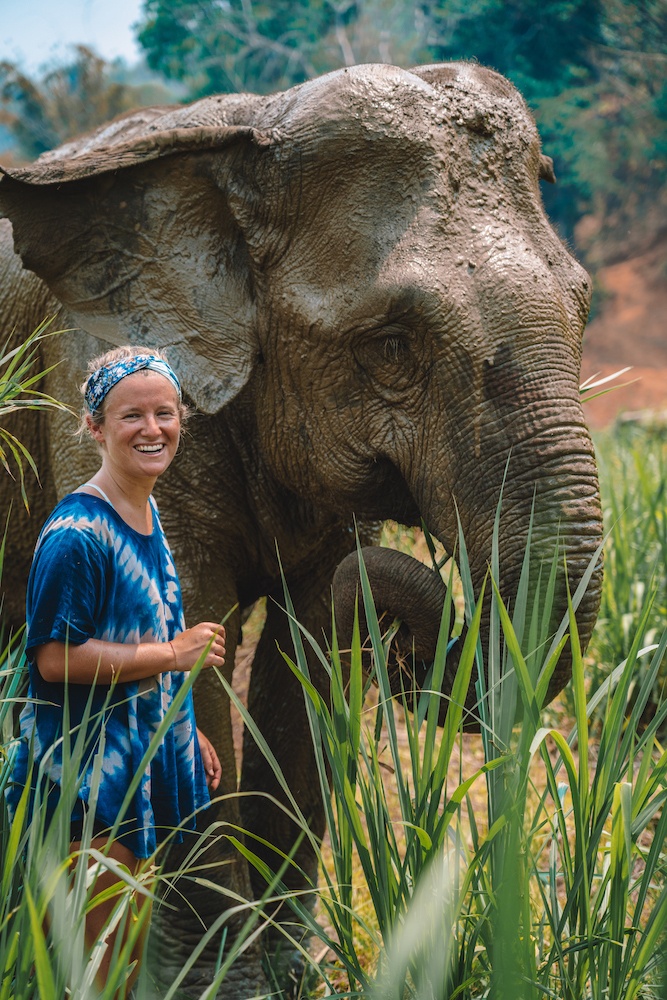
Getting close to the elephants at Elephant Green Hill in Chiang Mai, Thailand
A note on animal tourism
Animal tourism has always been popular. I think as humans it’s only natural to be attracted to beautiful wild animals, which we don’t have a chance to encounter in our normal daily lives.
However animal tourism isn’t always done in the best way it could be. Drugged tigers, elephants in chains, dolphin shows, holding turtles… the list goes on.
When it comes to animal conservation some people say; “better fed than dead”. While I do somewhat agree with that, if we can do better, shouldn’t we at least try?
As tourists, travellers and consumers, we have a huge influence over the direction we sway receiving economies. The local people are only trying to make a living, and you can’t blame them for that.

Two of the elephants at Elephant Green Hill in Chiang Mai
If tourists keep asking to ride elephants there will always be people who provide that service to feed their families. It’s only natural.
As consumers we are the ones that need to change what we are asking for, and ask for more ethical encounters. In recent years there has been a huge rise in ethical animal encounters.
As consumer demand changed to a more genuine approach, supply adapted to provide those services. Pretty much everyone that travels to Thailand wants to see elephants.
In this day and age there is plenty of information online and offline about it. It’s your responsibility as a traveller and consumer to find a place that does so ethically.

One of the beautiful elephants we spent the day with at Elephant Green Hill
How to find an ethical elephant encounter
So how do you decide what elephant sanctuary or centre to visit? There are some famous ones but beyond those, how do you know that what you’re booking is valid?
First things first, steer clear from any place that offers elephant riding. Despite what they say, there is no natural way to make an elephant want to carry people on its back.
Before booking anything, search for the centre name online. You should usually be able to find reviews, whether they’re on their official site or on other platforms such as TripAdvisor.

Feeding the elephants at Elephant Green Hill, part of the Elephant Nature Park “saddle-off” project
If other travellers have been there before you can usually understand from their reviews and experience how they treat the elephants.
Sites like TripAdvisor can be useful as you can see the photos uploaded by other tourists, not just the pretty promotional ones the company shares.
We personally chose Elephant Nature Park as we had heard lots of good things about it, both from other travellers who did the day tours and other friends who did the longer week volunteering experience.

Getting close to these elephants was a magical experience!
About Elephant Nature Park in Chiang Mai
Elephant Nature Park in Chiang Mai is often considered one of the best elephant sanctuaries that you can visit, and a must-see on any Thailand itinerary .
Established in the 1990s they have many years experience both with elephants and tourists, and a completely transparent and ethical approach.
They offer many different kinds of experiences, from half a day to even a full week of volunteering and helping out with the elephants. It’s a sanctuary where you can get close to the elephants, learn more about them and play with them.
With the rise of ethical animal encounters, many of the old elephant riding centres in the Chiang Mai area have joined ENP in their conservation efforts.
When you book an experience on their site you can choose whether to visit ENP or one of the other centres.

Spending time with the elephants at Elephant Green Hill

One of the elephants after our forest walk at Elephant Green Hill
The other centres are also ethical since they are part of ENP, they will just be in a different location from the main sanctuary.
The main ENP sanctuary has a herd of over 80 elephants, whilst the smaller centres will usually have less elephants.
We were afraid this might take away from the experience however it actually means that they only accept much smaller groups of visitors.
They might have less elephants, but less people also means more direct elephant time for you. We chose the “Saddle Off” experience at Elephant Green Hill .
We booked directly on the ENP website, but if you prefer to check reviews by other travellers and have free cancellation up until 24h before, you can also book it on GetYourGuide .
Click here to book your ethical elephant encounter in Chiang Mai , or check out prices & availability in the calendar below!

The younger elephant we spent the day with
Our experience at Elephant Green Hill & what to expect
We did the full day experience for 2,500 THB, which started with pickup from our hostel at 8AM and return around 4:30PM. Make sure to book your experience beforehand as these can get booked out very quickly!
Elephant Green Hill has three elephants, one of which was a baby elephant at the time we were visiting (April 2019).
We were the only people booked onto the tour that day so we ended up being just the three of us with three elephants!
We started the day by preparing the food for the elephants. We made a paste of rice, bananas and dried prunes and shaped it into balls. We then fed these balls and a lot of bananas to the elephants.

Preparing food for the elephants

The elephants were behind a small wooden fence but they’re not restricted in any way. The cheeky young one kept coming round to steal bananas and nobody ever really tried to stop him.
I really enjoyed this part of the day. Besides being great fun it also started getting us closer to the elephants.

Once we finished feeding them we went for a walk in the forest with the elephants. There were three local guides who were in charge of the elephants, and who were with us all day.
We walked through the trees for about 30 minutes, till we reached a spot the elephants clearly liked and we stopped for a while.
Here the elephants went off each in the direction they liked most and started eating from the trees, branches, grass and anything they found that struck their fancy.

Walking in the forest with one of the rescued elephants
We spent quite a bit of time at this stage just watching the elephants, admiring their beauty and size, and just marvelling at being so close to them.
As it started getting warmer we continued our walk to a muddy pool. Here the elephants raced past us and their mahouts and just dived straight in and started cooling off.
Watching them play in the water, splashing mud all over themselves and each and lying in the water was simply magical.
It’s one of those scenes you see in nature documentaries with David Attenborough’s voice in the background explaining what’s happening.

Happy elephants bathing at Elephant Green Hill in Chiang Mai, Thailand
After the short elephant bath it was time for a brief lunch break. The elephants stayed by the pool with their mahouts while we walked back to the main centre area for a buffet lunch.
They had quite a lot of choice with spring rolls, noodles, rice and fries. After lunch it was time for the elephant bath!
We walked over with the elephants to a much bigger pool, where all the elephants could properly dive into the water and cool down.
You can get in the water too and they will give you a bucket to join in the fun and splash the elephants (as well as your friends)! It soon turned into a water fight with everyone, elephants included, playing along.
One thing to note is the water is very dark and muddy and the elephants don’t really follow human society conventions.
When I saw one of the elephants go for a number two and the results of it floating in the water, I decided that was my cue to get out.

Bathing the elephants at Elephant Green Hill
After the bath we walked a bit more with the elephants. We walked through a grassy green field, drying off from the mud and water while the elephants ate a bit more.
It was an awesome day to say the least. What made me most happy was seeing how happy the elephants were. They are incredibly intelligent animals and you can see it from their eyes.
The way they interacted with each other, with us and their mahout was just touching. They might not be completely wild and free, but they’re loved and well looked after, and it shows.

Getting up close to the beautiful elephants
Where to stay in Chiang Mai
Most of the elephant centres, Elephant Nature Park included, are a bit of a drive outside Chiang Mai (understandably so).
However you don’t have to worry about being too far for them since all the tours usually include hotel pick-up and drop-off. Here are some recommendations on where to stay in Chiang Mai for every budget.
Budget: Leaf Hostel – We stayed at Leaf Hostel since it was close to where our friends were living. It wasn’t a very sociable hostel but the dorms were clean and spacious. If you’re looking for a more party hostel I’ve heard fun things about Bodega Chiang Mai Party Hostel .
Click here to book your stay at Leaf Hostel!
Mid-range: POR Thapae Gate – If you don’t fancy a hostel dorm a lovely mid-range option is POR Thapae Gate . Located in the heart of the Old City this hotel has spacious rooms and a pool where you can chill after a long day exploring Chiang Mai.
Click here to book your stay at POR Thapae Gate!
Luxury: Le Meridien Chiang Mai – We spent our last two nights in Chiang Mai at Le Meridien and loved it. It’s within easy walking distance of the night market and Old City, as well as having awesome city and mountain views.
Click here to book your stay at Le Meridien Chiang Mai!

Enjoying the sunset from the rooftop pool of Le Meridien in Chiang Mai
Looking for more Thailand travel tips? Check out these guides!
How to spend 10 days in Thailand
The best day trip to Chiang Rai from Chiang Mai!
Ultimate guide to the Surin Islands
Learn how to cook Thai cuisine in Chiang Mai!
Where to go scuba diving & snorkelling in Thailand
The most Instagrammable places in Bangkok
24 hours in Chiang Rai
What to pack for a trip to Thailand
Ayutthaya day trip from Bangkok
Day trip to the Similan Islands
7 hotels in Bangkok with awesome rooftop pools

The younger elephant that we spent the day with at Elephant Green Hill
Final thoughts on where to see elephants in Thailand
This post was a bit different from my usual travel guides. I usually write detailed guides to help you plan your trips so you know exactly where to go, what to do, how much you can expect to spend and so on.
Today I wanted to share with you a personal experience that I absolutely loved, and hope you can one day experience it too. If you want to see elephants in Thailand, then Elephant Nature Park is a great place to do so.
There are other places where you can have a similar experience, just make sure to do your research before you go there, and ensure they have an ethical approach with the elephants!
I hope you found this article useful, and that it answers your question about where to see elephants in Thailand in an ethical manner. Any questions just let me know in the comments!
Enjoyed reading about where to see elephants in Thailand? Pin it!

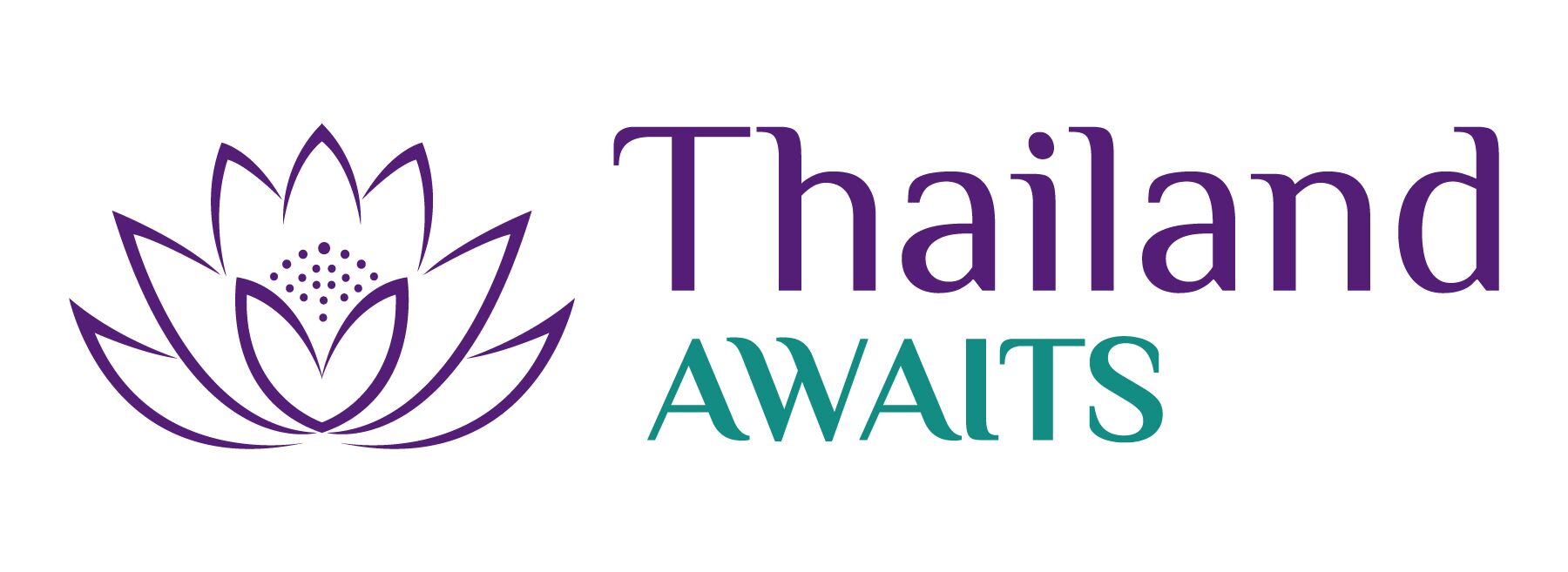
7 Ethical Elephant Sanctuaries in Thailand: A Guide for Responsible Travel
Choosing an ethical elephant sanctuary in Thailand is not easy to do and if you are someone who is serious about animal welfare, then it’s worth taking some time to make sure your choice will support the elephants ethically and not encourage continued animal exploitation . Today we share some tips to help you make sure you go in eyes open and choose an elephant sanctuary that supports these gentle giants.
The history of the elephant in Thailand
Why are there so many elephants in thailand, are there any real elephant sanctuaries in thailand, choosing an ethical elephant sanctuary in thailand: what to consider, which is the best elephant sanctuary in thailand, elephant parks in northern thailand, elephant sanctuaries in southern thailand, questions to help you find the best elephant sanctuary, ethical elephant sanctuaries in thailand – verdict.
This page may contain affiliate links. Please see our full disclosure policy for details.
The elephant is synonymous with Thailand, and has been an important animal for the country throughout history.
Their usefulness in conflicts was exploited by Thai armies who deployed them as ‘war elephants’, effectively Asian elephants being used as nature’s tanks.
While their strength and hardiness made them indispensable tools for loggers to help them carry their timber.
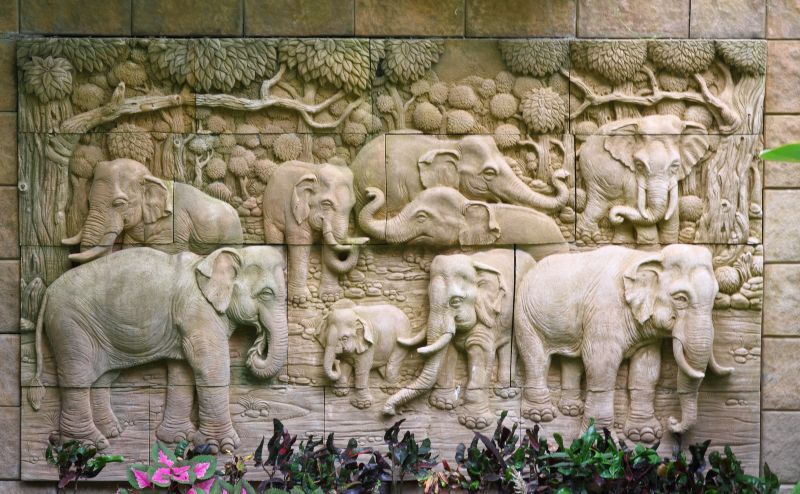
This history between Thailand and its elephants soon led to them becoming the country’s national animal of sorts, becoming entwined in national and royal iconography.
Once the lucrative logging industry was outlawed in the 1980s, elephant handlers (or mahouts) leveraged this knowledge by using their animals for the tourism trade.
Much of this elephant tourism saw elephants live in cruel conditions and forced to perform tricks and stunts including elephant riding.
Thankfully, things are changing, and several elephant sanctuaries have opened up to give elephants living conditions more akin to their natural habitat.
Sadly, while Thailand used to enjoy huge numbers of elephants, it’s no longer the case.
As of today, it’s thought that there are around 6,000 elephants in Thailand, however, half of that number are domesticated.
This is a significant decrease in numbers from the estimated 100,000 captive elephants from the early 1900s, let alone however many wild elephants that could have been added to that number.
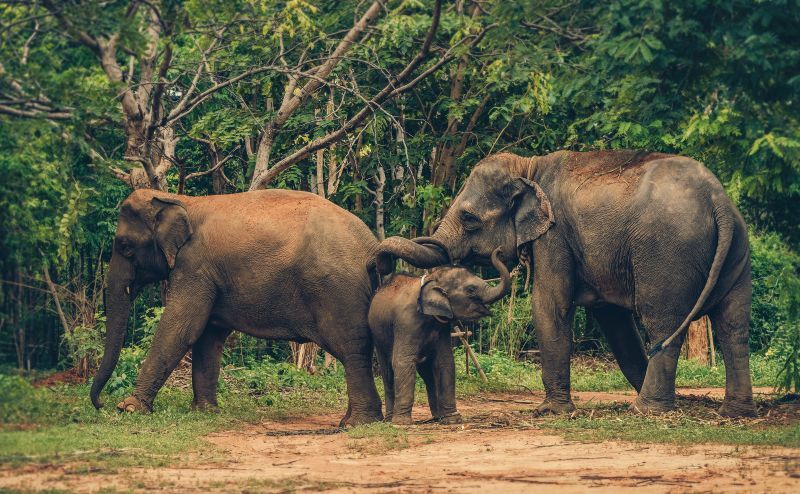
Despite the banning of logging practices, Thailand still has a problem with illegal logging. This has seen a country that was once 90% forest now offers just 170,000km2 of wild woodland.
This loss of forests, as well as the hunting of these beautiful animals, has meant that Thai elephants are now an endangered species.
Unscrupulous elephant park owners have realized the marketing power of using descriptors such as ‘ethical’, ‘eco-friendly’, ‘rescue centre’, ‘retirement home’ and indeed ‘sanctuary’, and use them to describe parks that are anything but.
That’s not to say that there aren’t plenty of truly ethical elephant sanctuaries in Thailand.
There are many committed to ending elephant exploitation and promoting the well-being and conservation of these majestic creatures, and minimising the invasive human interaction that was formerly so commonplace.
Many tours advertise swimming or bathing with elephants, and it looks like fun, but is it ethical? Let’s discuss.
Should you bathe elephants?
With more of a light shone on unethical practices such as riding elephants, some have moved to ostensibly ‘softer’ activities such as bathing with them.
Elephants love to splash and roll around in the water, but like us, are less keen when a group of strangers are pawing at them at the same time.
While it can seem harmless to bathe alongside them, take a moment to consider how the elephants are bathing at an often scheduled time, and won’t leave the water while the tourists are present.
This is because they’ve been trained to do so. It’s not natural for elephants to be so submissive to humans, unless they’ve been subjected to cruel training methods.
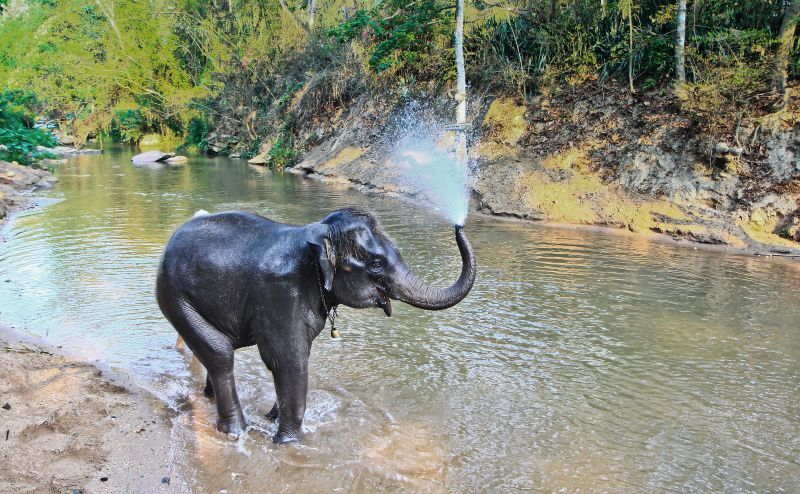
Should you swim with elephants?
Just as you shouldn’t expect to bathe an elephant, neither should you swim with them.
While elephants love to swim and bathe, they also like to do it when they want, and with an element of peace and quiet.
If they’re being forced to do it by their mahout in an elephant park, then you can be fairly sure that they’ve been coerced in a less-than-ethical manner.
Luckily, there are now several recommended ethical elephant sanctuaries in Thailand. Which you find best will depend on how much time you have and which part of Thailand you are visiting.
If you choose to visit one from the list below though, you can be sure of a wonderful time safe in the knowledge that the elephants have been treated well.
We had visited Thailand several times and not visited any elephant sanctuaries because we wanted to be sure we chose a truly ethical one and never got around to researching enough before our trips.
Now we are moving to Thailand for a year (or more) and we have much more time.
We have chatted with some of the operators listed below to learn from them what to look for when choosing which parks to support.
You could also research animal welfare sites to be sure you have a list ready to go while we are travelling.
The lush forests and less developed landscape of Northern Thailand are home to some excellent sanctuaries.
Elephant Nature Park, Chiang Mai
Providing a home for elephants rescued from mistreatment in the tourist trade and now home to over 100 this was the first of the ethical elephant sanctuaries in Thailand established.
It opened back in 2003 after its owner Lek began working with injured elephants in 1998.
The park offers several experiences, including their ‘Hands Off’ project, single day, and a 7-day volunteer experience.
Where: 1 Ratchamanka Rd, Tambon Phra Sing, Mueang Chiang Mai District, Chiang Mai Contact: Visit their website for more
Burm and Emily’s Elephant Sanctuary, Chiang Mai
Visitors to Burm and Emily’s Elephant Sanctuary (BEES) usually stay for at least two days and one night. Day visits are available, but they must be booked well in advance directly with the sanctuary.
The main activities here are observing the elephants in the forest, and helping clean and prepare their feed.
Visitors to the Observation Walk Day Program can view the elephants from a special observation tower that doesn’t disturb them.
Along with the elephants, you may meet other rescued animals. The multi-day visits can include a cooking class, gardening, helping plant trees, and other tasks around the sanctuary.
Where: Tambon Chang Keung, Mae Chaem District, Chiang Mai – You MUST pre-book Contact: Find out more here .
Friends of the Asian Elephant Hospital, Lampang
As their name suggests, the staff at the Asian Elephant Hospital treats injured elephants and gives them a better life.
Friends of the Elephant Hospital was founded by Soraida Salwala in 1993 and was the first of hospital established to treat sick elephants in the world.
Don’t confuse this with the Thai Elephant Conservation Centre, which is adjacent and forces elephants to perform for visitors.
Where: 295 Moo 6 Lampang-Chiangmai Road Viengtan Hangchatr Lampang Contact: You can reach out to the hospital via their Facebook page
Mahouts Elephant Foundation, Mae Sot
The founders of the Mahouts Elephant Foundation, the Blaine family from England, worked with the Karen indigenous mahouts in Mae Sot to create a safe home. Their foundation story is an interesting one that we encourage you read on.
This is a great choice for anyone who has time for a longer immersive experience with both a 4-day or 7-day mountain stay in a Karen community.
Where: near the border between Thailand and Myanmar Contact: Visit their website for more details
Boon Lott Elephant Sanctuary, Sukhothai
At Boon Lott’s Elephant Sanctuary (aka BLES) the elephants enjoy over 600 acres of forests and rivers to roam in. Guest numbers are kept low to ensure elephant welfare and to allow for positive experiences.
Bles was founded by British woman Katherine Connor who had previously volunteered at a Chiang Mai elephant hospital.
Boon Lott means survivor in Thai and was named after a baby elephant that Katherine met before opening the sanctuary.
There are currently 10 elephants in the herd at BLES. A visit allows you to meet retired and rescued elephants in their natural environment.
Your experience will include walking with the elephants through the protected forest habitat and helping with their care, but you do not bathe or feed them.
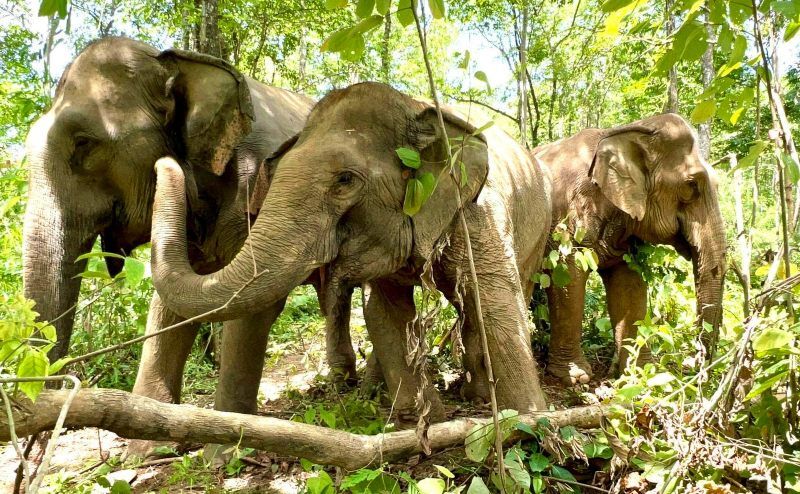
Guests stay for 5 nights spending their time helping with work related to caring for the elephants.
A maximum of 10 guests can visit at any time which allows each guest to spend time with and get to know the mahouts, locals from the village, who care for the elephants here.
You may also get to help with other animals like cats and dogs.
Where: Sukhothai Province – about 8km from the village of Baan Tuek Contact: Find out about visiting BLES here
There are many elephant camps and “experiences” in southern Thailand especially in the tourist towns, places like Pattaya, and the islands of Phuket and Koh Samui.
Choosing ethical ones can be more challenging and perhaps there are some we have missed from our list, as thankfully this is a developing situation.
As people are educated about elephant treatment these businesses are slowly becoming more humane and will continue to do so if guests stop requesting things like rides and bathing.
Phuket Elephant Sanctuary, Pa Klok Phuket
There are several elephant parks in Phuket, so how do you know which Phuket elephant sanctuary is ethical? Well, this one is! We think Phuket Elephant Sanctuary is the best in Phuket.
I just wish it had a more distinctive name so it was not so easily confused with the many unethical ones.
A home for rescued elephants, this sanctuary is owned by Mr. Montri Todtane and is a genuine success story of change.
Mr Todtane had previously owned an elephant riding camp, but changed his views in 2016 to create this elephant jungle sanctuary.
These days he promotes the most hands-off experiences in Phuket including only one very limited feeding opportunity on their half-day tours but heavily promoting observation over interaction.
View this post on Instagram A post shared by Phuket Elephant Sanctuary (@phuketelephantsanctuary)
Phuket Elephant Sanctuary is home to Thailand’s longest canopy walkway (600m) where you can watch the elephants from above. This is by far the most ethical elephant experience in Phuket.
There are currently 12 elephants on this 30-acre sanctuary and a number of experiences from half day with a brief feeding session to 90-minute canopy walks and observation-only sessions.
There is also a 7-day volunteer program.
Where: 100, Moo 2, Paklok, Thalang, Phuket Thailand Contact: Find out how to join in here.
Samui Elephant Sanctuary
This is the first ethical elephant sanctuary in Koh Samui. It has two locations, the first in Bophut in 2018 and a new location in Chaweng Noi in 2020.
There are 6 or more female elephants at each site. Most used to be involved in the logging industry.
View this post on Instagram A post shared by Samui Elephant Sanctuary (@samuielephantsanctuary)
Both sites offer half-day morning and afternoon sessions where you learn more about Asian elephants, prepare some food for them, and take a walk with them. There is no bathing.
They are associated with the Save Elephant Foundation.
Where: Bophut and Chaweng Noi – Hotel pickup included Contact: Find out more here
The best elephant sanctuary is the most ethical elephant sanctuary. To that end, there are a few questions to ask that will inform you of how well a park looks after its animals.
- How many interactive activities (such as riding, bathing, or touching) can visitors do with the elephants? If the answer is more than zero, then it’s generally an unethically run park.
- Does the sanctuary look like an elephant’s natural habitat? You don’t need to be an expert here. Just ask yourself if it’s closer to a lush woodland than it is to a concrete jungle.
- How much room do the elephants have? Not only are they large creatures, but elephants also like to roam around too. If an area seems restrictive to you, then it almost certainly will to a creature many times your size.
- Do the elephants have the facilities to engage in their normal activities? Elephants love to roll around in the mud, bathe, and scratch up against trees. A barren patch of grass does little to stimulate these intelligent creatures.
The sanctuaries mentioned in this post barely touch the surface of the elephant-based attractions based in Thailand.
While there are still regrettably too many exploitative elephant parks, it’s heartening to see change happening with the rise of just as many ethical parks.
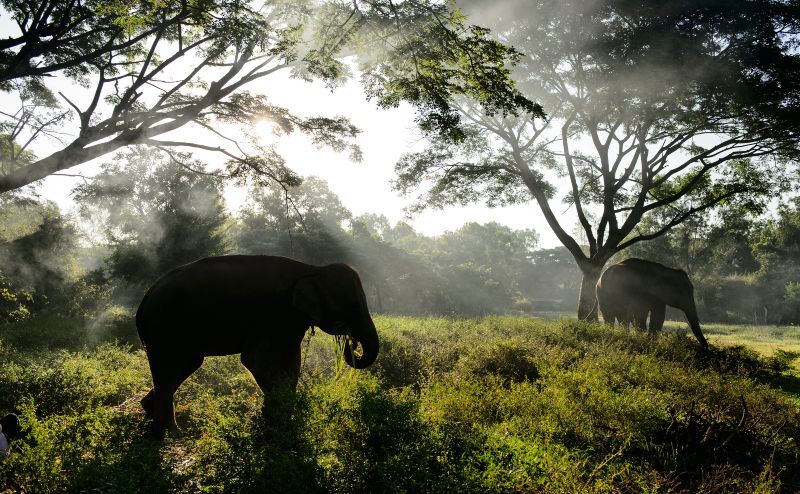
There’s one simple way to determine between a tourist-centered elephant nature park and a truly ethical elephant sanctuary. That is in how much human interaction the animals have.
While getting as close to these majestic animals as possible is tempting, we have to remember what is best for the elephants.
Let them enjoy their space as nature intended, and marvel at their true behavior, rather than an unnatural sideshow.
Find out more about Ethical Elephant treatment at Peta (People for the Protection of Animals)
About the author: Paula Morgan has been travelling to Thailand since the mid-1990s and has fallen in love with the people, culture, and of course, the food. These days she visits as often as she can and is planning an extended stay in the country in 2024.
Keep Planning Your Trip to Thailand
- 42 Bangkok Tips For First Timers: Must-Read Guide
- How To Get Around Bangkok: Public Transport For Visitors
- The Chao Phraya Tourist Boat: Sightseeing Tips For Every Stop
- 12 Things to Know Before Going to Thailand
- Simple Thai Words and Phrases for Traveling in Thailand
National Geographic content straight to your inbox—sign up for our popular newsletters here
How to navigate elephant tourism in Thailand
Elephants have long been synonymous with Thailand, yet their treatment in the name of tourism is questionable. Ethical camps are few and far between but it's here we see how good life can be for these incredible animals, if treated responsibly.

"It's true what they say, you know, an elephant really never forgets."
Gazing at Faasai's gentle, intelligent face, I can well believe it. No one who looks into an elephant's eyes remains unchanged. Like deep pools of molten rock, they seem to speak of infinite memories. As I hear her story, however, I change my mind — perhaps they speak of infinite miseries. Like so many captive elephants in Thailand, Faasai was subjected to The Crush; a process as terrible as the name suggests.
Designed to establish human dominance, babies — snatched from their mothers as young as six-months-old — are forced into tiny cages and systematically tortured until their spirits are broken. It's then, and only then, that they're released; ready to be taught to carry humans, to dance, paint, play football and finally, to bow.
"When this girl first arrived her eyes were infected," my guide, Newt, tells me. "Her feet were injured from the chains that tethered her to the spot when she wasn't giving rides or performing. But now look at her."
Right on cue, Faasai turns, lets out an enormous fart and lumbers off, her dignity somehow intact; her gait ungainly yet supremely graceful. She's utterly magnificent.
I'm spending the day at Elephant Nature Park, around 37 miles from Chiang Mai. Newt is showing me around the sprawling, 250-acre camp, home to 80 rescuees, each with a story more harrowing than the last.
Elephants are simply not designed to stand on their heads or walk a tightrope. Furthermore, their backs are actually extremely weak. Huge, heavy and cumbersome, the saddles they're forced to wear lead to pressure sores, permanent spine damage, and often to an early death. And perhaps that's a blessing. An elephant can live as long as a human — in captivity, we're often condemning these animals to decades of unrelenting misery.
Yet their number in Thailand's tourism industry continues to climb. A sudden, nationwide ban on logging in 1989 — a trade that used elephants to move felled trees — is often cited as the reason for this, although there are far more captive elephants now than there were at the time of the ban: 2,198, according to World Animal Protection.
Roughly equal in size to the wild population in Thailand, that's twice as many elephants in tourism than in all the other Asian countries combined.
"It's big business," Newt tells me. "An elephant is worth up to $50,000 [£36,500], while the weekly wage is often less than $50 [£36]. And at the end of the day, tourists love them. They get what they want."

His point hits home. I'll freely admit I'm no different from the next animal-obsessed traveller. I come to Thailand, I want to see elephants — but happy, healthy ones, not animals that have lost the will to live.
The growing calls from the West for ethical camps hasn't gone unnoticed. In parts of Northern Thailand, riding is out of favour. This becomes clear as soon as I step onto the hot, dusty streets of Chiang Mai, where, only a few years ago, I'm told, it was advertisements for rides that were covering the walls of the city's operators. Now they offer me the chance to 'be a trainer for a day', or 'walk beside these giants on a jungle trek'. Accordingly, many parks here have rebranded, transforming into 'retirement homes,' 'refuges' and 'sanctuaries'.
"That's true," Newt agrees, when I cite this surely positive attitude change. "But more riding camps still open all the time. And often elephants aren't treated any better; it's just better hidden. When they aren't with tourists they're chained up alone all day, sometimes by all four feet. What would happen if you did that to a horse in the UK?"
Elephant Nature Park's owner, Lek, was one of the first people to speak out against their mistreatment in Thailand. Born in a mountain village, the granddaughter of a traditional shaman healer, Lek grew up with an elephant, gifted to her family in thanks for her grandfather's skill. She's been advocating for animal rights since her teens, has won world renown for her conservation work and is involved in numerous charitable endeavours.
“Six resident elephants munch their way through the undergrowth, their gigantic bulk inky black in the muted morning light”
Unfortunately, Lek is nowhere to be found when I visit, although towards the end of the day I get to meet the latest addition to her elephant menagerie. Kabu was forced repeatedly to mate with her brother to produce a much-prized calf. When the baby was born she killed it, a common reaction among captive elephants under extreme duress. She stands stock-still, three-quarters submerged in a swimming pool-like structure — for therapy, Newt explains — her sad, staring eyes looking straight through me.
Seeing my dismay, Newt smiles: "Don't worry, she'll pull through. She gets better every day, and elephants have an amazing ability to move past things."
A beacon of hope
Differentiating between the good, the bad and the truly depressing when it comes to elephant parks can be almost impossible, but it's at 7am, cradling an armful of steaming dung, that I realise just how good life can be for these remarkable animals, if they're treated responsibly.
I'm helping with the morning poo pick-up at Elephant Valley Thailand, in Chiang Rai, my second port of call, three hours north east of Chiang Mai by bus. Set amid a sultry jungle of cedar and bamboo, the 40-acre sanctuary is cool, calm and quiet. Ahead of me, the six resident elephants munch their way through the undergrowth, their gigantic bulk inky black in the muted morning light.
Dung in hand, I'm lost in an awed reverie when I notice the staff making a beeline for particularly large pile of poo. Silently, they scan the area around the bowling ball-sized droppings in a state of fraught anticipation. "They're searching for an elephant tail hair," one employee, Peter, tells me, "They bring good luck. It's the same routine every morning. Really slows everything down, but it's a great feeling when you find one."
I join the vigil, pondering the stark contrast between the reverence shown here for these animals and their widespread mistreatment; something I later learn is closely intertwined with Thailand's history. By law, elephants are no more than livestock, yet Thais often say they helped build their nation. For centuries, they buttressed the country — organic tanks during times of war, bulldozers in peacetime, and taxis throughout it all. Today, the elephant's status seems perverse, contradictory, even: a beast of burden yet also a cultural icon.
"Everyone believes they bring good luck," Peter says. "I mean, the country's most iconic symbol is the elephant, and you've seen the statues in every temple. But when it comes to making money, often anything goes."
That afternoon, I meet Elephant Valley owner Jack, who tells me just how far he's planning to go in his quest for change. Human and animal interaction is kept to an absolute minimum here, and elephants are free to roam wherever they will, he explains. In fact, Jack plans to reintroduce them into the wild — something almost unheard of in Thailand — but is also determined to show other camps that, as a business model, his way works: "One big difference between here and other genuine sanctuaries is that this is a business, not a charity. I want to show venues they don't need to offer shows and rides; that being nice to elephants makes money — and this is what travellers want."
In 2010, visitor numbers to Thailand stood at 15.9 million. By 2017, that figure had more than doubled to over 35 million. Like me, most wanted to see elephants — if it takes off, Jack's plan could have an incredible impact.
Allowing elephants to simply be elephants is the commitment at the beating heart of this park. Watching Tong In, the camp's only bull, a beautiful five-ton lump with tusks just under a metre long, I wonder why anyone would want anything else. He spots his girlfriend, Lu, through the trees and trots over to her, trumpeting — a gleeful march of pure pleasure that has me giggling like a five-year-old.
He too came from the tourist industry, Peter reveals, and had become dangerous and wild when the shows all got too much. It took him a while to adapt to his new life of freedom: "He still remembers all his tricks, and sometimes he thinks we want him to perform. He'll randomly sit down, or stand on his hind legs. We laugh, but it's sad really. He was very angry with humans when he first arrived, but he's beginning to trust again."
While it seems it's true what they say — an elephant never forgets — their capacity for forgiveness is astonishing, heart-warming and humbling. Perhaps, one day, every tourist will be able to see them this way.
- Environment
History & Culture
- History & Culture
- Coronavirus Coverage
- Mind, Body, Wonder
- Paid Content
- Terms of Use
- Privacy Policy
- Your US State Privacy Rights
- Children's Online Privacy Policy
- Interest-Based Ads
- About Nielsen Measurement
- Do Not Sell or Share My Personal Information
- Nat Geo Home
- Attend a Live Event
- Book a Trip
- Inspire Your Kids
- Shop Nat Geo
- Visit the D.C. Museum
- Learn About Our Impact
- Support Our Mission
- Advertise With Us
- Customer Service
- Renew Subscription
- Manage Your Subscription
- Work at Nat Geo
- Sign Up for Our Newsletters
- Contribute to Protect the Planet
Copyright © 1996-2015 National Geographic Society Copyright © 2015-2024 National Geographic Partners, LLC. All rights reserved
Thailand Trip Expert
All about Thailand travel
The 4 Best Places to See Elephants in Phuket
If you are travelling to Phuket, Thailand, and want to see elephants roaming around freely in their natural environment, head to one of the island’s elephant sanctuaries. One can spend a morning or an afternoon walking amongst these majestic giants, learning about their important link to Thai culture.
The best places to see elephants in Phuket are the Phuket Elephant Sanctuary, near Paklok, the Elephant Retirement Park, near Bangtao Beach, the Elephant Jungle Sanctuary, near Naithon Beach, and the Phang Nga Elephant Park. Do not support places that offer elephant rides or shows.
Many places in Thailand have elephants, but not all of the places offering tourists elephant experiences are ethical to visit. When booking your elephant encounter, make sure you support a place that puts the welfare of these beautiful animals first. It is magical spending time with elephants in a quiet, peaceful environment.
Elephants in Phuket
The Asian elephant is indigenous to Thailand. A century ago, when Thailand was still called the Kingdom of Siam , there were around 100 000 elephants . Elephants were domesticated and used for work and for war. They played a key role in Thai society.
Today, Thailand has about 3800 domesticated elephants and about 3000 wild elephants. Phuket is home to 235 of these elephants – the exact number is known because the large pachyderms all need to be registered on a government database.
Visit an Elephant Sanctuary or Retirement Park
One will see elephants everywhere you go in Thailand. They are, after all, the national symbol of the country. Elephants have played an essential role in Thai culture and society for hundreds of years.
When visiting Phuket, one should definitely plan to experience an encounter with these majestic beasts because it is fascinating to learn about the mahouts’ – traditional elephant keepers – deep relationship s with their elephants.
Unfortunately, the popularity of elephant tourism has led to animal rights issues , so one needs to be very selective about which places you go to spend time with elephants.
It is best to visit elephant sanctuaries or retirement parks , where riding and shows are not offered, and the animals’ welfare is the top priority. These places strive to educate people from around the world about ethical elephant tourism, elephant poaching and the plight of elephants in the logging and trekking industries .
What to Do at an Elephant Sanctuary
All the elephant sanctuaries and retirement parks in this article offer either half-day or whole-day tours. Visitors can choose to spend either a morning or afternoon with the elephants.
There are many different, interesting activities to do at elephant sanctuaries:
- Observe elephants and their fascinating behaviors while they play together, feed on vegetation, bathe in the mud, or go for a swim.
- Go on jungle walks alongside the elephants .
- See how mahouts prepare the elephants’ daily feed .
- Help feed the elephants and give them their dietary supplements.
- Observe the mahouts perform health checks on the elephants .
- Volunteer to help the sanctuary by planting banana trees for the elephants to eat .
- Pose for photos alongside the elephants (strictly no flash photography).
Some but not all places allow visitors to bathe the elephants with mud and swim with the elephants.
Sanctuaries and parks offer the following educational activities:
- Video presentations teach visitors about the history of elephants in Thailand.
- English-speaking mahouts and park guides talk to visitors about the plight of Asian elephants and one can learn individual rescued elephants’ stories.
- Guides and mahouts also teach guests about the key role that elephants play in natural ecosystems and the importance of elephant conservation.
If you get hungry after all the activities, all the sanctuaries and parks offer guests a buffet-style lunch consisting of traditional home-cooked Thai foods, snacks, and refreshments (coffee, teas, water, soft drinks).
Things to Bring to an Elephant Sanctuary
Remember to take the following items with you when you visit the elephants:
- A hat and sunscreen . You will be spending a lot of time in the sun, so come prepared with protection.
- Insect repellent . There are loads of mosquitos in the jungle.
- Comfortable walking shoes . Wear shoes that are good for walking around on uneven terrain. They might get muddy, so avoid wearing your white sneakers!
- Bathing suit and towel . Depending on where you visit, you may have the opportunity to bathe the elephants or swim with them.
- Change of clothes . You will get really messy if you join the elephants for a mud bath, so it is best to pack a second outfit.
- Camera . Elephant sanctuaries and parks have photographers available to get the perfect shot of you and the elephants, but it is always nice to bring your own camera so that you do not miss out on any photo opportunities. Do not use your flash!
The Four Best Places to See Elephants in Phuket
The following places provide wonderful experiences with elephants and are 100% committed to ethical elephant tourism practices:
- The Phuket Elephant Sanctuary , near Paklok.
- The Elephant Retirement Park , near Bangtao Beach .
- The Elephant Jungle Sanctuary , near Naithon Beach.
- Phang Nga Elephant Park in the small, rural village of Phang Nga.
The Phuket Elephant Sanctuary
Dedicated to the ethical treatment of elephants, Phuket Elephant Sanctuary is a fantastic place to see elephants that are at peace in their environment. Tourists can watch the animals from a safe distance , playing, bathing, and relaxing in the forest.
This sanctuary strictly prohibits touching the elephants, flash photography , and does not offer elephant rides or shows . The welfare of the animals is of the utmost importance, and guests to the sanctuary need to respect the animals.
The Phuket Elephant Sanctuary’s residents have all been rescued from abusive lives in the elephant trekking, logging, or circus industries. The sanctuary’s operators genuinely care about creating a tranquil habitat for the retired elephants to live out their days in dignity.
One can spend either a morning or an afternoon exploring the 30-acre sanctuary. Admission fees are $45 for children under 12 and $91 for adults . This includes 3.5 hours of exploring the sanctuary, observing the elephants, walking alongside them, feeding them fruits , and enjoying some refreshments and snacks at the Tree Top reception area.
The sanctuary also offers whole-day tours , private tours , and they run a volunteer program for tourists who want to spend a lot more time with the elephants and actively contribute towards their conservation.
The Elephant Retirement Park
This Park offers tourists the opportunity of seeing and spending time with their rescued elephants in a wonderful, natural environment where the animals’ welfare is the top priority .
The Park is home to eight elephants that were all rescued from lives in working captivity. They can now live out the remainder of their lives in peace and dignity at the Elephant Retirement Park, where they will never experience abuse or riding again.
Visitors can roam around the park with the elephants for either a whole day or for half a day , watching them graze on the lush jungle vegetation, and go for a swim in their spacious pond. Tourists can also experience feeding the elephants their favorite treats.
The admission fees for a half-day tour are $55 for children under 10 and $79 for adults . This includes 3.5 hours of time with the elephants, lunch, snacks, and refreshments, access to knowledgeable, English-speaking guides, transfer to and from your accommodation and a free Elephant Retirement Park T-shirt.
One can opt for longer tours. There is a day-long program , an overnight program , and even a weekend-long elephant volunteering experience where one can be fully immersed in the elephants’ world.
The Elephant Jungle Sanctuary
Started in 2014, Elephant Jungle Sanctuary is an eco-tourism project that is dedicated to ethical elephant tourism in Thailand. They use their platform to educate tourists and local people about the Asian elephant’s plight.
The sanctuary is located in a beautiful part of the island, with jungle and beach views . They use all the money made from visitors and donations to rescue more elephants, care for them, and provide them with a safe environment in which to spend their lives.
Visitors to the sanctuary will be guided by mahouts, who speak English, and can tell one about how the elephants are cared for, elephants’ role in Thai culture, and the histories of individual animals.
Half-day tours are $58 for children under 10 and $76 for adults . These prices include pick up and drop off at your hotel or accommodation, a buffet meal and refreshments, and fruits to feed the elephants.
There are also overnight packages , and a day-long tour where one can hike through the jungle with the elephants while they forage.
On the tour, one can watch the elephants go about their daily business, feed them, bathe them, and even go swimming with the elephants ! There us a professional photographer who can snap pictures of you while you fully immerse yourself in the experience.
Phang Nga Elephant Park
Phang Nga Elephant Park is about an hour’s drive outside Phuket . This relatively small, family-operated elephant park is located in the tiny rural village of Phang Nga where people have been living alongside elephants for 150 years . Here, thirty mahouts live with their elephants and their families, caring for them and promoting elephant welfare.
Phang Nga Elephant Park supports ethical elephant tourism . Their animals live in a relaxed, quiet environment and visitors are invited to experience the elephants in a respectful way. They use their education center to teach tourists and locals about the importance of elephant conservation.
Admission fees are $88 for children under 14 and $149 for adults for a 4 to 5-hour tour of the park. A traditional Thai lunch, and transfers to and from your accommodation are included in this price. Shorter 2-hour tours are also available . There are no overnight stays offered.
Visitors get the whole elephant care experience, including preparing their food , and learning about traditional Thai herbal medicine used to keep the elephants healthy.
One can walk alongside the animals through the jungle, feed the elephants, swim with them in a rock pool , and help them by planting trees and other food crops for the elephant.
The Importance of Ethical Elephant Tourism
It extremely expensive to keep elephants in captivity. Due to their large size, they require a lot of vegetation to graze on. They cost about $40 per day to feed – that is more than 3 times the minimum wage in Thailand. Elephants also need veterinary care and space to live.
In the past, the only way that mahouts could afford to keep their elephants was to send them to work in the logging or trekking industry , or to take them to urban areas to perform and beg for money .
As the tourism industry in Thailand boomed, so did the popularity of elephant tourism . People from all over the world wanted to go to Thailand to experience these giant animals face-to-face and ride on their backs.
Mahouts offered tourists elephant rides, jungle treks, and circus-like shows where elephants would be dressed up and made to perform tricks. While this work covered the cost of feeding the elephants, it also involved cruel training practices to ensure that elephants are safe around tourists.
In recent years, these animal rights abuses have been highlighted in the media and tourists now shy away from elephant tourism in Thailand , which is deemed unethical and undignified for the animals.
While increased awareness regarding the cruel treatment of elephants is positive for the species, the loss of income from tourism has meant that many mahouts are forced to send their elephants back into the logging and trekking industries . The additional impact that the Covid-19 pandemic had on the Thai tourism industry is causing widespread joblessness for many domesticated elephants.
Elephant sanctuaries and retirement parks, that rescue elephants from a hard life of working captivity rely on the income from tourists to care for their residents and to rescue more elephants . By visiting these places, paying to spend time with the animals, and even donating money, one can support elephant welfare and conservation in Thailand.
Elephants in Captivity
It is cruel for any wild animal to be forced to live in captivity, but especially for highly intelligent and emotional mammals, like elephants. However, due to widespread deforestation and destruction of the jungle – the elephants’ natural habitat – there is nowhere to release the animals back into the wild.
It is illegal to capture wild elephants for domestication and illegal to release domesticated elephants into the jungle where they will compete with wild populations. However, wild baby elephants are still routinely poached in the jungles of Myanmar and smuggled over the border into Thailand to be sold into captivity.
Elephant sanctuaries and retirement parks are the kindest, most natural places for domesticated elephants to live in Thailand. They keep elephants safe from the cruelty and abuse of the logging and trekking industries.
To contribute towards elephant conservation and support their ethical treatment, do not support any elephant parks or camps that offer riding, bathing in the ocean, or elephants performing any unnatural behaviors .
The island of Phuket is home to 235 magnificent Asian elephants. These creatures are indigenous to Thailand, but sadly the species has been exploited by the logging, trekking and tourism industries.
There are four highly reputable, 100% ethical elephant sanctuaries and parks in Phuket that tourists are encouraged to visit:
All these places offer guests the experience of seeing elephants up close in a natural, tranquil setting where they are not required to perform any tricks or give people rides .
Visitors can go on half-day, day-long, overnight, and even weekend-long tours of the sanctuaries. One can see how the mahouts care for the animals, help to feed them, bathe them, and even swim with them.
Tourists need to be very selective of the elephant parks and camps they visit in Thailand. Many do not uphold the values of ethical elephant tourism and these places should not be supported.
By visiting ethical elephant sanctuaries and parks, one can contribute to the elephants’ welfare and to the conservation of Asian elephants in Thailand. The elephant sanctuaries and parks rely on admission fees to pay for the animals’ food, housing, and medical care, so by visiting them you directly support the elephants .
My Recommendations
- Best Insurance for Thailand travel Check
- Best App to Date Thai Girl Check
Related Posts
How much are beer and alcoholic drinks in phuket: a detailed price list.
Although Phuket is filled with a wide range of beautiful beaches, spectacular resorts and hotels, and lots more, it is…
17 Reasons Why You Should Visit Phuket
When it comes to the most famed holiday destinations in Thailand, Phuket is one of the standout options to consider.…
Is the tap water safe to drink in Phuket
It is said that nothing compares to the crystal-clear waters of Thailand; in fact, they are not referring to the…
Visiting Thailand? Here Are The Best Places To See Elephants
Visiting Thailand's elephants both ethically and safely is a rare event that many travelers don't experience, but this is where you can.
Seeing elephants in their natural habitat is one of those unforgettable experiences that everyone should have at least once in their lives. Besides being known as the "Land of Smiles", it is also known as the "Land of Awe-Inspiring Wildlife", which has everything from beautiful rainforests to tropical beaches and, of course, friendly giants.
Trying to figure out where to go to see elephants in Thailand, but not sure which places are ethical to visit? Here are some of the greatest spots to get to know Thailand's friendly giants. Remember that this list only covers establishments that have sound animal care standards in place and do not allow people to ride elephants on their backs.
10 The Surin Project In Baan Tha Klang
The Surin Project which is located in the northeastern Thai town of Baan Tha Klang, works directly with mahouts, providing a haven for trainers and their elephants to keep them off the streets and prevent unethical tourism. In fact, nearly 200 mahouts and elephants live at the center and this non-profit organization employs mahouts to care for the land and the animals that walk free in the forested park. The site is a national treasure as its sanctuary encourages environmentally friendly tourism. Surin Project, visitors are welcome to stay for a minimum of one week, and their donations are used to pay the salaries of the mahouts and care for the elephants while they are in the sanctuary. This is a good sanctuary that is visited by many travelers as well as locals in Thailand.
RELATED: Elephant Island: Why You Can Visit, But You Can't Stay
9 Elephant Nature Park In Chiang Mai
This is one of Thailand's best-known elephant conservation programs, but it is also one of the priciest. Despite that, over the years, the sanctuary has taken in a variety of animals, including cats, dogs, horses, warthogs, water buffalo, and more. A single-day trip or an overnight stay are also viable options for visiting Elephant Nature Park . For tourists that like to spend more time with these wonderful creatures, there is an overnight volunteer program where volunteers help prepare food for elephants and other animals. It is also possible to reserve longer volunteer positions, however, this must be done well in advance of the start date.
8 Friends of the Asian Elephant Hospital In Mae Yao National Reserve Of Lampang
Visiting Friends of the Asian Elephants Hospital will definitely be a unique experience for travelers to Thailand. The sanctuary’s mobile veterinary clinic is essential to the treatment and rehabilitation of elephants throughout Thailand, which is located in the northwest. In fact, injured, crippled, and vulnerable elephants are cared for by the sanctuary’s specialists and volunteers alike. Visitors to this place will also be able to meet veterinarians who devote their careers to caring for these majestic giants of nature as part of their guest program. Additionally, visitors will also get to see how they care for sick and injured elephants, as well as how they prepare their meals and maintain their living spaces.
7 Elephant Sanctuary In Koh Samui
The Samui Elephant Sanctuary is the first haven on the island for elephants who have been abused and overworked. Visitors to this place can feed, walk, and even play with the elephants in their mud pit and custom pool in the sanctuary’s forest area. In fact, the Koh Samui Elephant Sanctuary has provided refuge to hundreds of elephants that had previously been exploited in the forestry industry or by tourists on elephant treks. This sanctuary is a great site to see elephants in their natural settings.
RELATED: Go Walking With The Lions & The Leopards And Riding Elephants With Mukuni Big Five Safari
6 Elephant Sanctuary In Phuket
Phuket Elephant Sanctuary provides a safe haven for elephants that have been subjected to years of cruelty in the tourism and logging sectors. The sanctuary is leading the way in the humane treatment and rehabilitation of elephants that have been retired or rescued. A treetop observation balcony provides an excellent vantage point from which to see the animals as they frolic in the freshwater lagoons and hydrotherapeutic mud pools. So visitors that would like to visit the area will be able to see these giant creatures playing on lagoons or in mud pools.
5 Wildlife Friends Foundation In Tha Mai Ruak
Wildlife Friends Foundation is home to many rescued animals all over Thailand. In fact, some of the animals rescued by the Wildlife Friends Foundation are rehabilitated and released back into the wild in protected conservation zones. However, elephants are not part of this group as the retired elephants from trekking camps are too reliant on human care to be able to thrive without it. Fortunately, the Wildlife Friends Foundation is more than happy to help them out with that. Visitors of this sanctuary can help other volunteers in cleaning the cages or even feed the animals which is a lifetime experience with wild animals.
4 Burm and Emily’s Elephant Sanctuary In Maechaem
Burm and Emily's Elephant Sanctuary is a haven for old, injured, or retired elephants. This sanctuary provides a safe haven for elephants who have suffered from years of logging or tourist trekking. In a valley surrounded by lush foliage and majestic mountains, the organization is located around two hours south of Chiang Mai, in an area that is ideal for elephants to spend their golden years in peace and tranquility. Visitors can visit the place and indulge with the elephants in the area, they can also try to volunteer too in helping feed the elephants.
RELATED: Año Nuevo State Park: Where You Can See The Majestic Elephant Seals Of California
3 Phang Nga Elephant Park In Mueang Phang-nga District
Located on the edge of a nature reserve in Phang Nga Province, this modest, family-run park has been a sanctuary for many elephants. Phang Nga Elephant Park is committed to the welfare of its elephants, which makes them continue learning and developing sustainable strategies in taking care of these gentle giants in order to ensure their stay. Visitors to this place can make sure that they will have a positive experience together with the elephants.
2 The Happy Elephant Home In Chiang Mai
The Happy Elephant Home is a wonderful place to spend time with family and friends as it is located in a large green rolling field near an isolated cluster of bamboo buildings. This is a peaceful and calm area for the elephants as they will not be astonished by the presence of people in traditional clothing. In visiting this sanctuary, visitors can help feed the elephants enormous bushels of bananas and bathe them in mud, before letting them cool off in the river.
1 Elephant Hills In Khao Sok
At the outskirts of Khok Sao National Park, the magnificent Elephant Hills sanctuary is situated. According to many visitors of the area, the most exciting part of this sanctuary isn't the luxurious tents or the comfy lodgings that visitors can stay in because the most precious part is the opportunity to spend many days with the elephants and their guides. In this sanctuary, there are up to three-day safaris available, which include all meals and housing expenses. Gentle giants will be bathed, fed, and walked with by guests as they move through their natural habitat. Elephant Hills is currently home to Asian elephants that were abused and mistreated, but are now living out their lives in peace and tranquility.
NEXT: You Can Sleep Among Elephants In This “Jungle Bubble” Hotel
Nomadic Matt's Travel Site
Travel Better, Cheaper, Longer
How to Play, Feed, Bathe, and Protect Elephants in Thailand
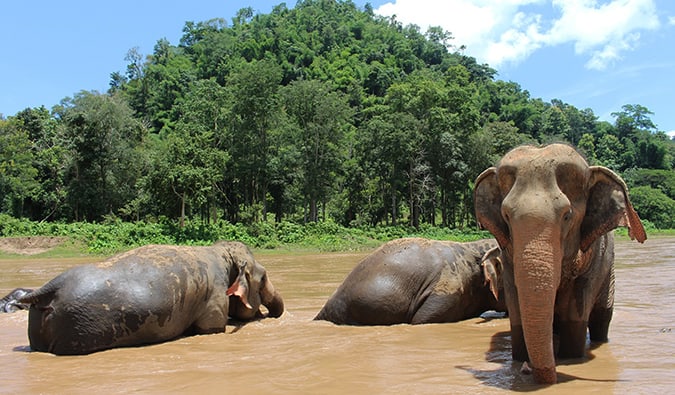
Elephants have long been important in Thailand , where they are a symbol of religion, history, royalty, and power.
According to Buddhist legend, Queen Maya of Sakya, Lord Buddha’s mother, dreamed that a divine Bodhisattva on a white elephant touched her side. She later became pregnant, and since then, elephants have had a strong connection to divinity and royalty in Buddhism. As Thailand is predominantly Buddhist, elephants are held in high esteem.
Additionally, elephants were used in the logging industry to help clear trees, so there was a practical nature to their importance as well.
After a government-imposed ban on logging in 1989, the industry dwindled and suddenly all of these elephants had no “purpose.” Their owners were left needing a way to make money for their families and the care of the elephants. Since most tourists came to Thailand thinking “I can’t wait to ride an elephant,” it was a lucrative transition.
Elephants were taken into cities and fed by tourists who wanted a photo. In the jungles, riding camps were set up where visitors could ride an elephant through the jungle, take their photos, and return home with tales of their cool experience.
Elephants became big business in the country. After all, as a tourist, who wouldn’t want a chance to see or ride one? It’s a dream come true for many.
When I lived in Thailand , I learned about the true nature of elephant tourism. I learned how those elephants roaming the streets were drugged and often starved.
And it was illegal too.
Elephants in cities had been banned for years, but, as is common in Thailand, officials turned a blind eye or were paid off.
I was always torn: do I ignore them, hoping this will eventually end the practice, or do I feed the elephant out of kindness but perpetuate this cruelty?
It wasn’t until a few years ago, after an accident that left a child, a driver, and an elephant dead, that officials in Bangkok finally cracked down and made it elephant free.
And then there’s the riding? I mean riding an elephant sounds amazing!
Until you realize how the animal is treated.
When you ride an elephant, you get a glimpse into their poor treatment. I remember once yelling at the mahout (trainer) for swinging his hook a little too hard at the elephant. It left me very perturbed — and wishing I hadn’t ridden that elephant.
Riding an elephant requires elephants to be physically abused. Moreover, it’s not good for elephants to be constantly carrying people around as it can damage their back.
Unfortunately, I didn’t know better. There wasn’t a lot of good information about there about how to see elephants in Thailand in a socially responsible way.
But the more time I spent in Thailand, the more I learned that there are no good elephant riding parks in all of Thailand. All abuse and mistreat their elephants — despite what they say. Riding elephants is actually terrible for their growth and development as well.
To be clear, there is no such thing as ethically riding an elephant.
Luckily, there’s been a large movement in the last few years to protect the elephants and, now tourists, have a lot more ethical options when it comes to elephants in Thailand.
The pioneer is Elephant Nature Park . Led by Lek Chailert, Elephant Nature Park (ENP) has been around since 1996 and is the biggest conservation and elephant rescue organization in Thailand.
Located outside of Chiang Mai , it is currently home to dozens of elephants (plus a menagerie of other animals) that have been saved from the tourism and logging industries. It’s a “retirement” home for elephants
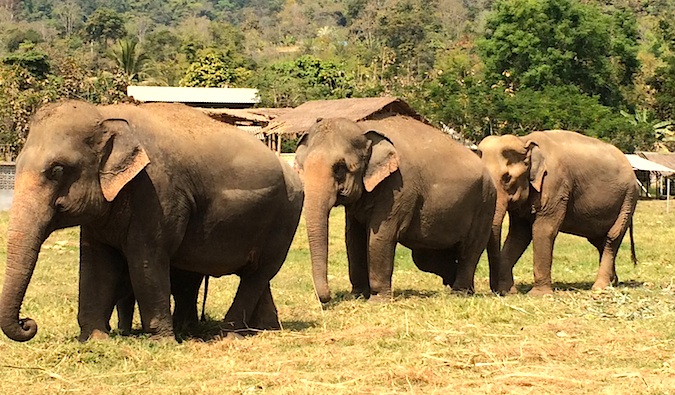
Demand is so high, not only for visitors but volunteers too, that you have to make reservations in advance to visit (for volunteers, that might mean up to a year in advance). When I tried to visit a few years ago, they were already booked for the next month!
This time, I booked ahead and was able to visit and see all the good they do:
The more you learn about elephants in Thailand, the more you realize the need for change. It was heartbreaking listening to the stories of each elephant and seeing so many with broken backs, legs, and missing feet. Luckily, because of organizations like ENP and more socially conscious tourists, things are changing.
ENP has started to work with the riding camps to give up riding and move toward more animal-friendly practices. Thais are learning that people will pay big bucks to feed, bathe, and play with elephants and that this can be more lucrative, more popular, and more sustainable than offering rides.

As such, there are now a lot of places around Thailand where you can see and interact with elephants in a responsible way throughout the country:
- Wildlife Friends Foundation of Thailand – A full-day visit is 1,600 THB per person and a half-day visit is 1,100 THB per person (excluding transport). wfft.orgl
- Elephant Hills – Luxury jungle camps with two-day tours that cost between 14,000-16,500 THB. elephanthills.com
- The Surin Project – Home to upwards of 200 elephants, here you can volunteer for up to eight weeks. The price is 13,000 THB per week (7 days is the minimum volunteer period). surinproject.org.
- Boon Lotts Elephant Sanctuary – The cost to visit is 6,000 THB per night, and reservations must be made in advance. blesele.org.
The elephant camps aren’t gone yet. They won’t be for a long, long time. But with more educated tourists and an economic incentive for locals to treat the elephants better, hopefully, we can severely reduce these camps in the next few years (and eventually eliminate them).

So the next time you’re in Thailand , please don’t ride the elephants. If you want to see an elephant, visit Elephant Nature Park or a similar program and help protect these amazing creatures.
You’ll get a closer and more personal interaction with the elephants, and you’ll be doing good. It’s a win-win for everyone involved.
How to Visit Elephant Nature Park
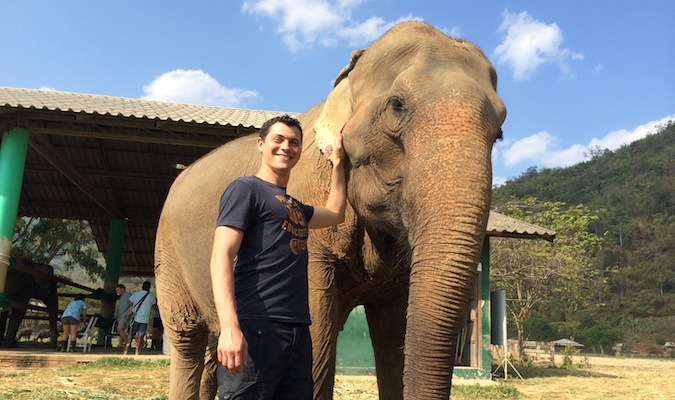
ENP is located near Chiang Mai , though they do have branches around the country (and in Cambodia ) that also offer ethical experiences.
Short visits to ENP last 6-7 hours and cost 2,500 THB per person. This includes a vegetarian lunch buffet as well as transportation to/from Chiang Mai.
Their popular overnight visit (2 days, 1 night) costs 5,800 THB per person and includes meals, transportation, and accommodation.
Get the In-Depth Budget Guide to Thailand!

My detailed 350+ page guidebook is made for budget travelers like you! It cuts out the fluff found in other guidebooks and gets straight to the practical information you need to travel around Thailand. You’ll find suggested itineraries, budgets, ways to save money, on and off-the-beaten-path things to see and do, non-touristy restaurants, markets, bars, safety tips, and much more! Click here to learn more and get your copy today.
Book Your Trip to Thailand: Logistical Tips and Tricks
Book Your Flight Use Skyscanner to find a cheap flight. They are my favorite search engine because they search websites and airlines around the globe so you always know no stone is left unturned.
Book Your Accommodation You can book your hostel with Hostelworld as they have the biggest inventory and best deals. If you want to stay somewhere other than a hostel, use Booking.com as they consistently return the cheapest rates for guesthouses and cheap hotels.
Don’t Forget Travel Insurance Travel insurance will protect you against illness, injury, theft, and cancellations. It’s comprehensive protection in case anything goes wrong. I never go on a trip without it as I’ve had to use it many times in the past. My favorite companies that offer the best service and value are:
- Safety Wing (best for everyone)
- Insure My Trip (for those over 70)
- Medjet (for additional evacuation coverage)
Looking for the Best Companies to Save Money With? Check out my resource page for the best companies to use when you travel. I list all the ones I use to save money when I’m on the road. They will save you money when you travel too.
Want More Information on Thailand? Be sure to visit our robust destination guide to Thailand for even more planning tips!
Got a comment on this article? Join the conversation on Facebook , Instagram , or Twitter and share your thoughts!
Disclosure: Please note that some of the links above may be affiliate links, and at no additional cost to you, I earn a commission if you make a purchase. I recommend only products and companies I use and the income goes to keeping the site community supported and ad free.
Related Posts
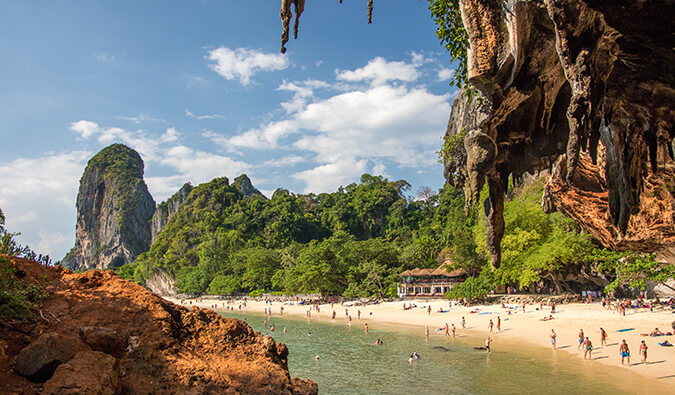
Get my best stuff sent straight to you!
Pin it on pinterest.
- 100% tailor made
- 100% value guarantee
- Expert consultant
- Ground support
- No hidden cost
- Why Tailor-made Travel ?
- Our Promise
- Responsible tourism
- Best & Reasonable Price

- Thailand and Vietnam
- Thailand and Cambodia
- Thailand Vientam Cambodia
- Vietnam and Cambodia
- Southeast Asia Tours
- Japan Tours
- Japan Family Tours
- Japan Senior Tours
- Japan Food Tours
- Japan Autumn Tours
- Japan Nature Tours
- Japan Walking&Hiking Tour
- Custom Japan Honeymoon
- China Tours
- China Guides
- Thailand Tours
- Thailand Guides
- Vietnam Tours
- Vietnam Guides
- Cambodia Tours
- Cambodia Guides
- Indonesia Tours
- Philippines Tours
- Tailor-Made Trip
- expert consultant
- ground support
- no hidden cost
- Thailand Travel Guide
Top 10 Places Seeing Wild Elephants in Thailand
Elephant is one kind of the lovely and rare animal in the world. For those people who like elephant, that will leave them unforgettable memory if they can get close contact with elephants during their traveling. In Thailand, you will have many choices to see elephants, but it will be much more amazing if seeing wild elephants in an Elephant Tour in Thailand . Now, just check out the top 10 places seeing wild elephants in Thailand.
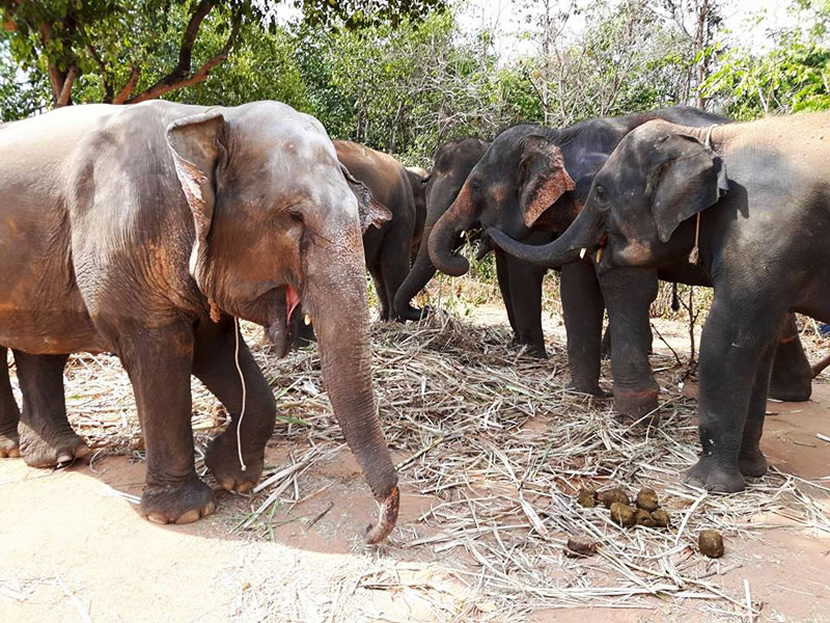
Surin is located in the eastern of Thailand, and it is a famous hometown of elephants. There is the Surin Project. Here you can get in deep touch with elephants, feed them and play games with them. After mahouts join the project, they have fixed salary to maintain their live, so they do not need to train elephants to participate in various activities which will make damage of elephants' health.
2. Kui Buri National Park
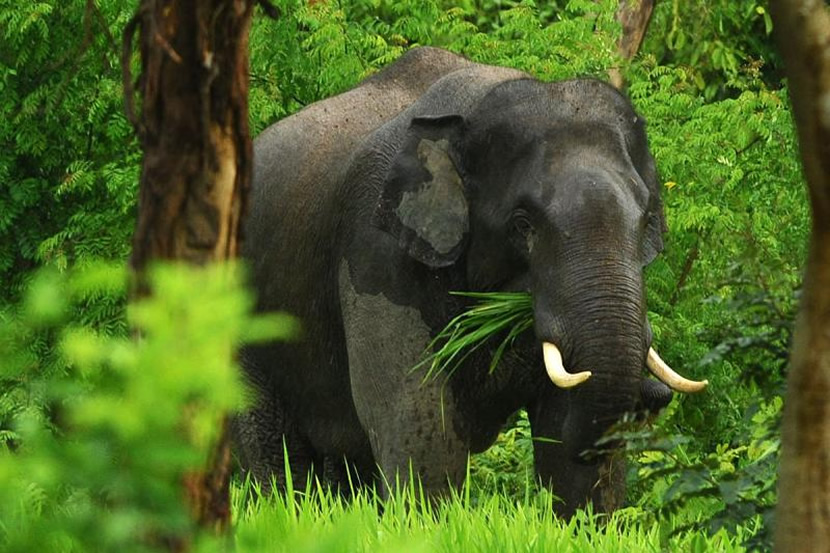
Kui Buri National Park was established in 1999. It is situated in the Tenasserim Hills in Prachuap Khiri Khan Province. Now, it is estimated that about 100 individuals and around 320 elephants grow in Kui Buri National Park . There are also many kinds of wild mammals, such as gaurs, golden jackals, leopards, deers, bantengs, and langurs.
3. Khao Yai National Park
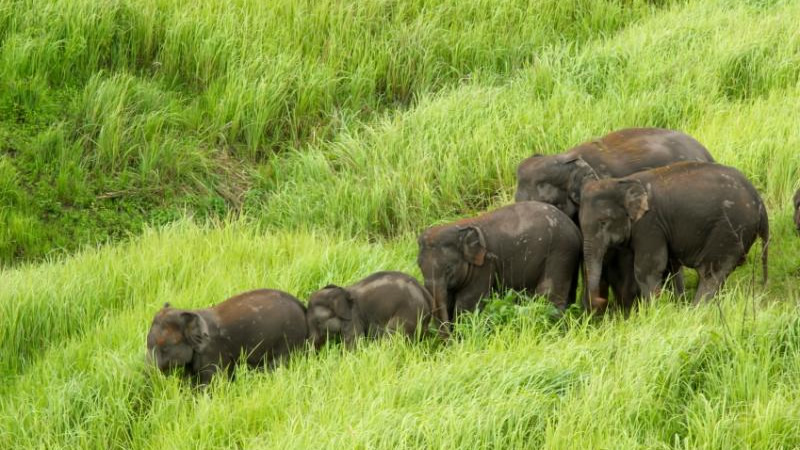
Khao Yai National Park is the second largest national park in Thailand, more than 200 kilometers from Bangkok . The National Park was built in 1962 and covers an area of 2168 square kilometer. The park has 67 species of mammals, including tigers, jackals, gibbons, cynomolgus macaques, Asian elephant, sambar and muntjac etc.
4. Khao Sok

Khao Sok National Park may be the most famous national park in southern Thailand . And it is located in the mainland between Phuket , Krabi , Khao Lak and Koh Samui . It is declared to be a national park in 22nd December, 1980. You will enjoy elephant experience and elephant trekking here.
5. Thungyai-Huai Kha Khaeng Wildlife Sanctuaries
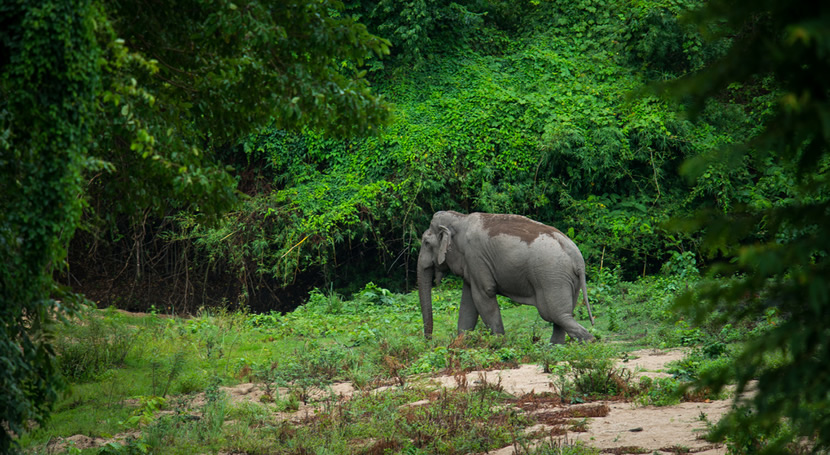
This wildlife sanctuary is located near the Thai and Burma border in western of Thailand, and it covers an area of 320000 hectares. It is the largest nature reserve in Thailand. It was built in April 24, 1974. And it was included in the world cultural heritage by UNESCO in 1991.
6. Kaeng Krachan National Park
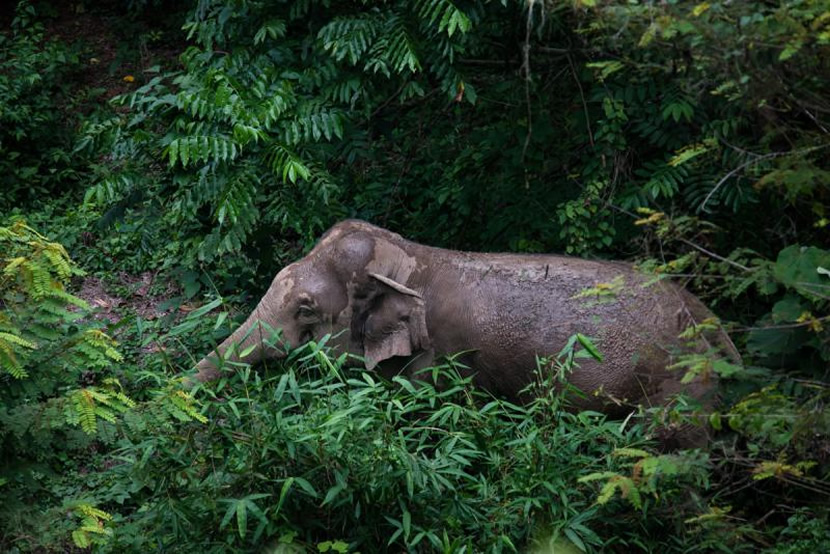
Kaeng Krachan National Park is an important wildlife sanctuary in Thailand, with more than 400 species of birds and 57 species of mammals, which included India buffalo, elephant, sambar, malay tapir, leaf monkey and gibbons etc. It is closer to the important tourist city, Huaxin.
7. Wildlife Friends Foundation Thailand
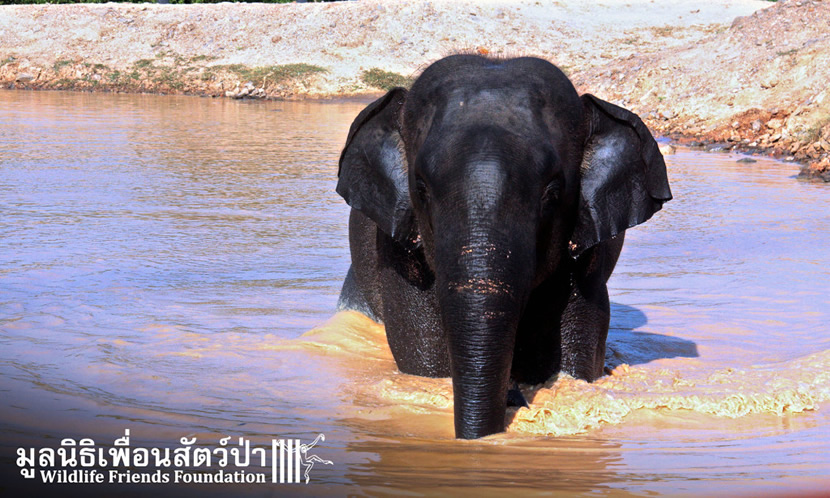
The aim of Wildlife Friends Foundation Thailand (WFFT) is to rescue, rehabilitate and care for wildlife. And the elephant is its important rescued object. Wildlife Friends Foundation Thailand can provide an ecological and careless living residence for the piteous elephant.
8. Elephant Valley Thailand
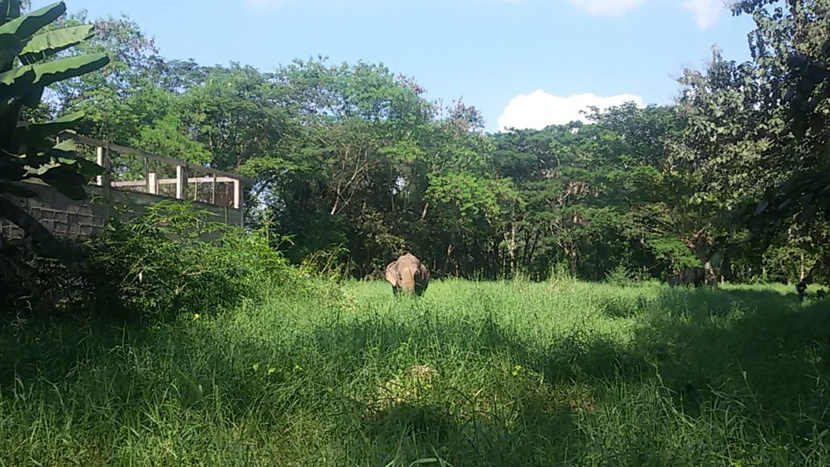
Elephant Valley Thailand was setting up by Manager Jack, an English gentleman. Unlike most elephant parks in Thailand , we follow the guide's footsteps in the forest to observe the elephants at a distance. The guide will introduce to us the characteristics and names of each elephant in English.
9. Elephant Jungle Sanctuary
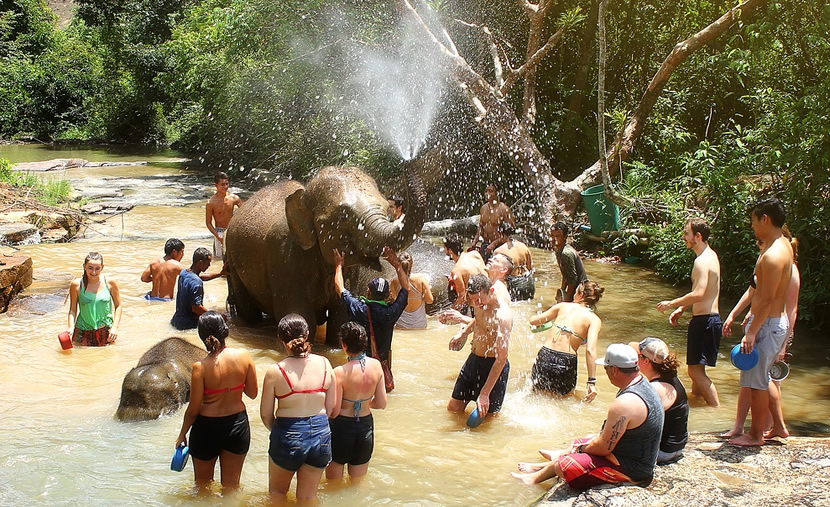
Elephant Jungle Sanctuary is far away 60km from the city of Chiang Mai, which is located in the Northern Thailand . And this sanctuary is founded in July 2014. It is not allowed people ride elephants, because riding elephants for a long time will bad for elephants' health.
10. Phuket Elephant Sanctuary

The sanctuary is situated on the island of Phuket in Southern Thailand . The staffs of Phuket Elephant Sanctuary are trying their best to rescue and take care of elephants. They treat elephants as their friends and family members.
Read more: Elephant Tours in Thailand
You Might Like

Destinations
- Southern Thailand
- Northern Thailand
- Kanchanaburi
- Koh Phangan
- Thailand Honeymoon
- Festival & Party
- Thailand Golf Tours
- Thai ladyboy
- All-inclusive Thailand
Travel Styles
- For Couples
- Singles and Solo
- Young Adults
- Small Group
- Elephant wildlife
- Off the beaten track

- Why trailor-made travel?
- our promise
- responsible tourism
- best & reasonable price
- Philippines


The PERFECT 3 Days in Chiang Mai Itinerary
C hiang Mai is one of our favorite places to visit in Thailand. Situated in the misty mountains of northern Thailand, this ancient city offers culture, nature, and adventure to all who come to explore it.
Whether you’re coming to marvel at Chiang Mai’s countless temples or explore the national parks and elephant sanctuaries just outside the city limits, spending 3 days in Chiang Mai promises a memorable experience.
For first-time visitors to this beautiful and relaxing city, we’ve laid out the perfect 3-day Chiang Mai itinerary that gives you a taste of both the excitement and the serenity that Chiang Mai offers.
3-Day Chiang Mai itinerary overview
From trekking through lush jungles alongside elephants to savoring delectable Thai cuisine , here’s how to make the most of your three days in Chiang Mai.
Day 1 of 3 days in Chiang Mai
Your first day in Chiang Mai will be all about exploring the city itself. We took the sleeper train from Bangkok to Chiang Mai , which put us in Chiang Mai fairly early in the morning, around 7:30 a.m. Regardless of how you arrive in Chiang Mai, be sure to be dressed modestly for touring the temples in the city, which means linen pants or long skirts or dresses that cover both your legs and your shoulders.
On the first day of this 3 day Chiang Mai itinerary, you’ll visit the following places.
Wat Phra Singh
Wat chedi luang.
- Lunch in the historic city center
Wat Chiang Man
- Dinner and explore the Chiang Mai Night Bazaar
Day 2 of 3 days in Chiang Mai
Your second day in Chiang Mai will take you out of the city for most of the day to visit one of the elephant sanctuaries that Thailand is famous for .
If you’re visiting Chiang Mai with kids , this will likely be their favorite day spent.
- Visit an Elephant Sanctuary with lunch (we visited Into the Wild Elephant Camp )
- Swim and get cleaned up at the hotel or book a Thai massage
- Visit another one of Chiang Mai’s famous night markets for dinner and souvenir shopping
Day 3 of 3 days in Chiang Mai
Your third and final day during your 3 days in Chiang Mai also takes you out of the city to see one of the most famous temples, as well as to visit an indigenous Hmong tribal village.
- Day trip to Wat Phra That Doi Suthep and Hill Tribe Village (with lunch)
- Dinner back in Chiang Mai
Best time to visit Chiang Mai
If you’re planning a family trip to Thailand and want to visit when the weather is best, many consider November through February to be the ideal time of year.
During this period, Chiang Mai experiences cooler temperatures and lower humidity than it does during the scorching summer months. Additionally, this time coincides with some of Thailand’s popular festivals of Loy Krathong and Yi Peng, where the sky is adorned with countless floating lanterns.
The months of March to May bring warmer weather. And finally, the rainy season runs from June to October. The weather is also quite hot during the summer months. However, we visited during the rainy season, and experienced only one brief downpour in Chiang Mai that lasted about 45 minutes.
So, if you are planning around your kids’ school breaks and the summer months are the only time of year that allows for a 2 week Thailand trip or longer, then don’t let the rainy season discourage you from visiting.
Where to stay in Chiang Mai for 3 days
Because Chiang Mai is such a popular destination, you’ll find a wide variety in lodging, from budget-friendly hostels to luxurious resorts.
Whether you stay within the Old City gates or just outside the gates, you’ll find lots of conveniently located places to stay.
Here are a few hotel options that are within walking distance to many of Chiang Mai’s top attractions.
- Centara Khum Phaya Resort
- Celosia Hotel (where we stayed)
- Melia Chiang Mai
Day 1 highlights of this 3 day itinerary for Chiang Mai
When you arrive in Chiang Mai, or any other city, it’s a good idea to simply spend the day walking around the tourist center of the city and familiarizing yourself with it. So, on your first day in Chiang Mai go for a walk in the UNESCO World Heritage designated historic center, but make sure it’s a walk with purpose.
If the heat is sweltering or you prefer a guided experience, book a tuk tuk tour that will take you to some of the most popular temples.
The city is home to dozens of temples, so you’ll want to map out the ones you personally want to visit. Here are three we recommend.
Dating back to the 14th century, Wat Phra Singh houses the Phra Singh Buddha, one of the most revered in northern Thailand.
The temple complex boasts beautiful, ancient architecture with multi-tiered roofs and intricately carved wooden structures leafed with gold.
The main assembly hall houses the grandiose Buddha statue. The Phra Singh Buddha is one of the most revered Buddha images in Thailand, second only to the Emerald Buddha at Wat Phra Kaew in the Grand Palace- a must-visit on any Bangkok itinerary .
Wat Chedi Luang is another majestic temple located in the center of Chiang Mai.
It once housed the Emerald Buddha, prior to being moved, eventually making it to its current location in Bangkok.
Although time and the elements have weathered its grandeur, the main chedi (stupa) still stands as a remarkable testament to the age of the city. It remains the largest chedi in Chiang Mai.
The temple complex hosts daily monk chats where visitors can ask them anything about Buddhism and Thailand.
There is at least one building in the complex that doesn’t allow women to enter, but as one of the most notable temples in Chiang Mai, it’s worth the time and small admission fee to visit.
Believed to be the oldest temple in Chiang Mai, Wat Chiang Man was our personal favorite. Founded in 1296 by King Mengrai, the city’s founder, the temple has a serene atmosphere. The beautifully adorned main viharn (assembly hall) is the highlight of the temple.
However, don’t miss the Phra Sila (Crystal Buddha), a small but exquisite crystal Buddha image believed to have magical powers.
Day 2 Chiang Mai highlights
Many of the best things to do in Chiang Mai actually lay outside the city. On your second day, book a day trip to one of the ethical elephant sanctuaries.
Into the Wild Elephant Sanctuary
Although there are a lot of elephant sanctuaries surrounding Chiang Mai, you’ll want to do your research, as not all of the “sanctuaries” treat the elephants in an ethical manner.
We chose Into the Wild Elephant Camp , which is about 1 ½ hours from Chiang Mai. Our transportation was included with our booking.
At Into the Wild you will get to feed the elephants, and go on a trek through the jungle with them. The elephants are allowed to roam freely without any ropes or leads.
After the morning trek, you’ll be able to get in the mud and the river with the elephants that choose to get in there and help bathe and cool them off.
The elephants are never expected to perform tricks for tourists nor are tourists allowed to ride them.
You can tell that both the elephants and the operators of the sanctuary have a mutual respect for each other, which made us feel comfortable with our interactions with these majestic creatures.
Chiang Mai Night Bazaar and Kalare Night Bazaar
After you return from your outing to an elephant sanctuary, you’ll probably want to shower and get cleaned up. Before heading out for dinner that evening.
The best places to eat in Chiang Mai are at the night markets. You’ll find lots of vendors selling a variety of delicious, yet inexpensive Thai food options, like Khao Soi, Pad Thai, Moo Ping and Sai Ua. If you’re not sure what to order, book a street food market tour with a local guide.
The Chiang Mai Night Bazaar and the Kalare Night Bazaar across the street are among the best markets that comes alive after sunset.
You’ll not only find a food court area with dozens of different food stalls, but this iconic bazaar stretches several blocks selling endless goods and unique Thai souvenirs .
Visitors can wander through the lanes of colorful stalls selling everything from handmade crafts and traditional textiles to t-shirts and carved soap.
The markets, particularly the Chiang Mai Night Bazaar exudes a festive ambiance, creating a sensory experience while you’re shopping for treasures and savoring local delicacies.
We ate at and explored the night markets every night during our 3 days in Chiang Mai.
Thai Massage
Whether you end the night with a Thai Massage or get one at another time while in Chiang Mai, make it a point to get a massage!
We got several massages in Thailand, in Chiang Mai and in the beach town of Krabi in southern Thailand. A Thai massage is one of the best things to do in Krabi , Chiang Mai, Bangkok, Phuket and elsewhere.
In Thailand, massages are inexpensive and unique, with a mixture of stretching and applied pressure.
Hill Tribe Village
Visiting a hill tribe village in Northern Thailand during your 3 days in Chiang Mai will give you a different than you get in the more developed city.
The Hmong people are an indigenous tribe known for their textiles. While Hmong people live throughout Southeast Asia, Northern Thailand is one of the more populous areas.
You can book a day trip that will take you to a hill tribe village to see how rural people live in the mountainous areas around Chiang Mai, as well as to Wat Phra That Doi Suthep.
Wat Phra That Doi Suthep
Wat Phra That Doi Suthep is a majestic temple perched atop a mountain overlooking Chiang Mai.
One of Thailand’s most famous temples, Doi Suthep requires walking up 300 steps or taking a cable car to get to it. This sacred site is believed to enshrine a relic of the Buddha, making it one of the most important pilgrimage destinations in northern Thailand.
Aside from that, the views of the city below are breathtaking set against the backdrop of lush greenery.
Conclusion: Is 3 days in Chiang Mai enough?
As your three-day Chiang Mai itinerary draws to a close, you may find yourself reluctant to leave this enchanting city. From the serenity of ancient temples to the excitement of bustling markets and the adventure that awaits in the surrounding jungles, your 3 days in Chiang Mai will go by quickly… too quickly probably.
If your itinerary allows, we’d recommend at least 4 days in Chiang Mai so you can also visit Doi Inthanon National Park and spend more time just basking in the atmosphere of the city.
There are so many other things to do in Chiang Mai for families that you simply won’t be able to fit into a 3 day itinerary. But if time is limited and a few days is all you have, you’ll leave Chiang Mai with a lasting impression and a desire to return.
Do you have a question or comment about this itinerary for 3 days in Chiang Mai? We’d love to hear from you. Leave your thoughts in the comments below.
Like it? Pin this guide to 3 days in Chiang Mai to save it for later!
Did you know….
When you make a purchase or book hotels, tours, or other travel services, through our links, we receive a small commission, at no extra cost to you. We only EVER recommend service providers, websites, or products we personally use when booking our own travels. Your support enables us to keep producing helpful travel content. Thank you!
- Book a HOTEL
- Book a RENTAL CAR
- Purchase TRAVEL INSURANCE
- Book guided tours or excursions at GET YOUR GUIDE or VIATOR
- Buy the JAPAN RAIL PASS
- Buy other TRAIN TICKETS IN ASIA
- Book a DESTINATION PHOTOGRAPHER
- Buy TRAVEL GEAR on Amazon
- Buy a PRIORITY PASS MEMBERSHIP for airport lounge access


IMAGES
VIDEO
COMMENTS
1. The Elephant Nature Park, Chiang Mai. Even though the Thai term "Chang" actually translates to "elephant," Chiang Mai is recognized as one of Thailand's finest locations to see elephants. Because of its track record for honesty and long-term viability, locals trust Elephant Nature Park.
The best ethical elephant sanctuaries in Thailand. #1 Elephant Nature Park. #2 Phuket Elephant Sanctuary. #3 Friends of the Asian Elephant Hospital, Lampang. #4 Elephant Hills, Khao Sok. #5 Mahouts Elephant Foundation. #6 WFFT Thai Elephant Refuge, near Hua Hin. #7 Boon Lott's Elephant Sanctuary (BLES), Sukhothai.
Elephant Nature Park is one of the most respected and famous elephant conservation projects in the country. Elephant Nature Park is located near the northern Thai city of Chiang Mai and is home to more than 35 free-roaming elephants, many of which have been rescued from the logging and tourism industries. A day out at Elephant Nature Park is ...
Visitors to BLES, located outside the village of Baan Tuek, an hour's drive north of Sukhothai airport, get involved in all aspects of sanctuary life, from collecting elephant food from the jungle to maintaining herding areas and grazing grounds. Overnight visits including transfers and all meals cost 6000B (US$178).
After a lot of research and going here myself, the best ethical way to see elephants in Thailand is to visit or volunteer at the Elephant Nature Park located approximately 1.5 hours north of Chiang Mai in Northern Thailand near the border of Myanmar. Below I'll share my experience visiting these elephants and explain why this is the best place ...
Samui Elephant Sanctuary. Location: Koh Samui, an island known for its idyllic beaches, is also home to the pioneering Samui Elephant Sanctuary. Its story: Spread across 10 acres of forest, it's a retreat for a dozen elephants rescued from the burdens of logging and tourist trekking industries.
Here are some of the best places to see elephants in Thailand. 1. Elephant Nature Park, Chiang Mai. Located in the lush forests of northern Thailand, Elephant Nature Park is a renowned sanctuary dedicated to rescuing and rehabilitating elephants from exploitation. The sanctuary provides a natural haven for rescued elephants, offering them a ...
Here are five elephant sanctuaries to consider on your next trip to Thailand: Boon Lott's Elephant Sanctuary currently cares for nine elephants. 1. Boon Lott's Elephant Sanctuary. Baan Tuek. In 2005, British animal activist Katherine Connor Connor rescued a baby elephant from the tourist trade, whom she named "Boon Lott" (which means ...
Finding elephants on a nature walk. Khao Yai National Park is one of the best places in Thailand to see Asian elephants in the wild. There are two good ways to do this, the first being by night safari (see below), and the second by guided walk. Our first adventure in Khao Yai was therefore a guided walk, which involved us meeting up with a ...
Elephants In Thailand: Boon Lott's Elephant Sanctuary. In Sukhothai, there is a small sanctuary for rescued elephants known as Boon Lott's Elephant Sanctuary. The Boon Lott Sanctuary, which is in the ideal position, is the greatest place to spend a few days getting to know the little herd of gentle giants. Take your new friends on a stroll ...
Westend61/Getty Images. Elephant tourism has been an important part of Thailand's economy for five decades. There are about 4,000 wild elephants in Thailand, reports the World Wildlife Fund (WWF ...
The Elephant Nature Park is an incredible project set in Northern Thailand, only 65 kilometers from the city of Chiang Mai. Since the 1990s, it has provided a sanctuary and haven for elephants and many other rescued animals from all over Thailand. It's the only place to experience elephants in the country (or another sanctuary recommended by ...
The Elephant Nature Park, Chiang Mai Photo by Rajiv Perera on Unsplash. Although not to be confused with the word "Chang," actually meaning "elephant" in Thai, Chiang Mai is widely regarded as one of the best places to see elephants in Thailand. The Elephant Nature Park is the best-known conservation project in the area and prides itself on a track record of ethics and sustainability.
1. Elephant Nature Park. Elephants at Elephant Nature Park (Shutterstock) Elephant Nature Park is one of the best-known elephant conservation projects in Thailand. Set on the edge of a rainforest near Chiang Mai, in Thailand's north, the sanctuary was founded by award-winning conservationist Lek Chailert in 1995.
There are many places in Thailand where you can see elephants and get close to them. However not all of them are ethical. Elephant riding is still a very popular activity, which you should avoid if possible. In this post I talk about our experience at Elephant Nature Park in Chiang Mai, an ethical elephant sanctuary and rescue centre.
This is by far the most ethical elephant experience in Phuket. ...
Established in 1962, Khao Yai is Thailand's oldest national park, a UNESCO World Heritage Site, and one of the best places in Thailand to spot elephants in the wild. Around 200 Asian elephants live in the park and can often be seen at night. ... One of the few places to see elephants in the wild in Thailand is Kui Buri National Park. Here ...
Roughly equal in size to the wild population in Thailand, that's twice as many elephants in tourism than in all the other Asian countries combined. "It's big business," Newt tells me. "An elephant ...
The following places provide wonderful experiences with elephants and are 100% committed to ethical elephant tourism practices: The Phuket Elephant Sanctuary, near Paklok. The Elephant Retirement Park, near Bangtao Beach. The Elephant Jungle Sanctuary, near Naithon Beach. Phang Nga Elephant Park in the small, rural village of Phang Nga.
9 Elephant Nature Park In Chiang Mai. This is one of Thailand's best-known elephant conservation programs, but it is also one of the priciest. Despite that, over the years, the sanctuary has taken in a variety of animals, including cats, dogs, horses, warthogs, water buffalo, and more. A single-day trip or an overnight stay are also viable ...
Ethical Advice for seeking out Elephants in Thailand. Even more so than its Southeast Asian neighbours, Thailand is home to many wild and domesticated Asian elephants. Around 3,000 elephants live throughout the country, about half in captivity. Although we would all like to see elephants in their natural, wild habitat, this isn't always possible.
The Surin Project - Home to upwards of 200 elephants, here you can volunteer for up to eight weeks. The price is 13,000 THB per week (7 days is the minimum volunteer period). surinproject.org. Boon Lotts Elephant Sanctuary - The cost to visit is 6,000 THB per night, and reservations must be made in advance. blesele.org.
In Thailand, you will have many choices to see elephants, but it will be much more amazing if seeing wild elephants in an Elephant Tour in Thailand. Now, just check out the top 10 places seeing wild elephants in Thailand. 1. Surin. Surin. Surin is located in the eastern of Thailand, and it is a famous hometown of elephants.
Whether you're coming to marvel at Chiang Mai's countless temples or explore the national parks and elephant sanctuaries just outside the city limits, spending 3 days in Chiang Mai promises a ...